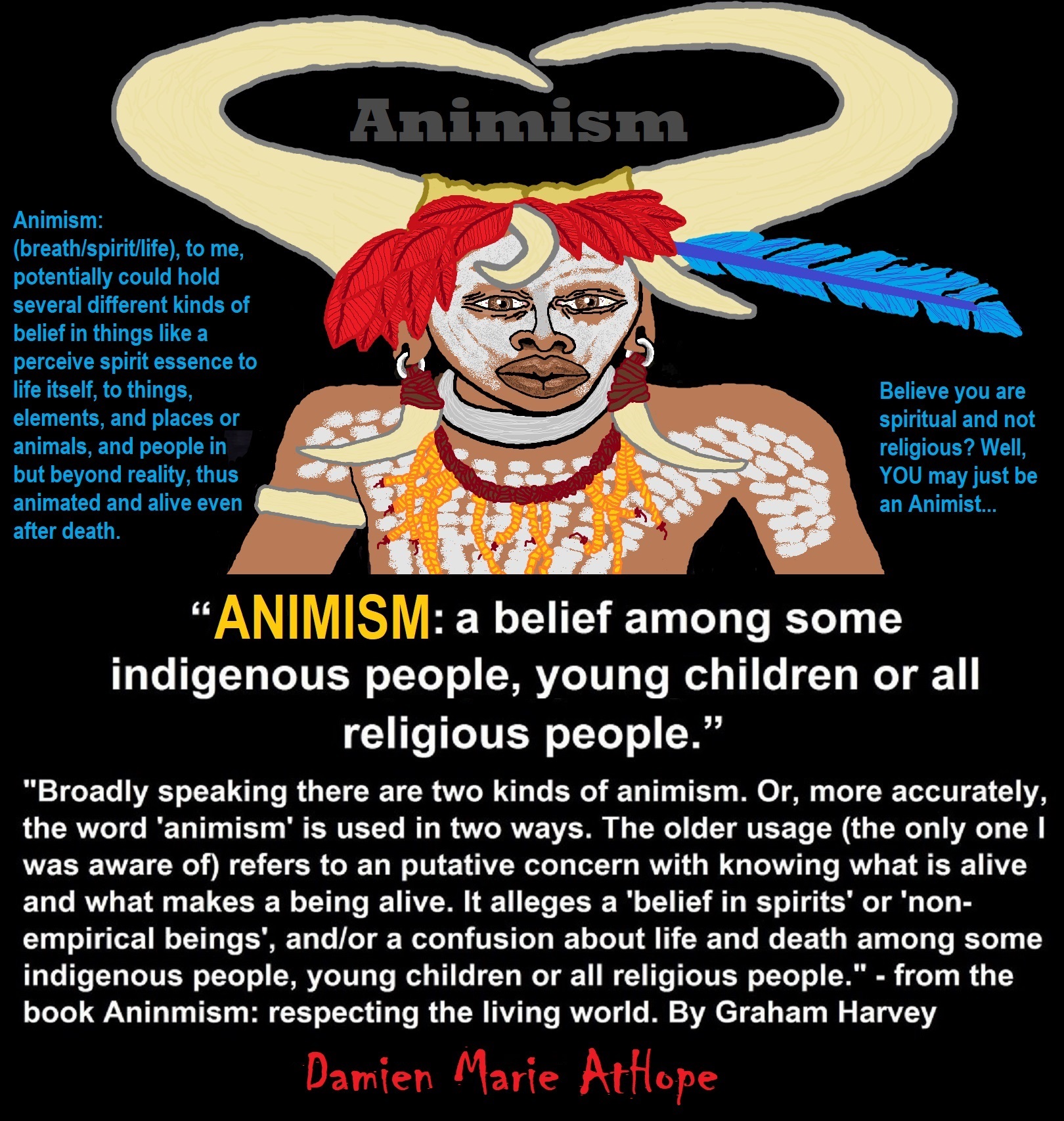

All of our ancestors we once only animists, anarchists, and socialists
then some asshole wanted power, thus it has all gone down from there.
No God: No evidence, No intelligence, and No goodness = Valid Atheism Conclusion
1. No evidence, To move past the Atheistic Null Hypothesis: There is no God/Gods (in inferential statistics, a Null Hypothesis generally assumed to be true until evidence indicates otherwise. Thus, a Null Hypothesis is a statistical hypothesis that there is no significant difference reached between the claim and the non-claim, as it is relatively provable/demonstratable in reality in some way. “The god question” Null Hypothesis is set at as always at the negative standard: Thus, holding that there is no God/Gods, and as god faith is an assumption of the non-evidentiary wishful thinking non-reality of “mystery thing” found in all god-talk, until it is demonstratable otherwise to change. Alternative hypothesis: There is a God (offered with no proof: what is a god and how can anyone say they know), therefore, results: Insufficient evidence to overturn the null hypothesis of no God/Gods.
2. No intelligence, Taking into account the reality of the world we do know with 99 Percent Of The Earth’s Species Are Extinct an intelligent design is ridiculous. Five Mass Extinctions Wiped out 99 Percent of Species that have ever existed on earth. Therefore like a child’s report card having an f they need to retake the class thus, profoundly unintelligent design.
3. No goodness, Assessed through ethically challenging the good god assumptions as seen in the reality of pain and other harm of which there are many to demonstrates either a god is not sufficiently good, not real or as I would assert, god if responsible for this world, would make it a moral monster ripe for the problem of evil and suffering (Argument from Evil). God would be responsible for all pain as life could easily be less painful and yet there is mass suffering. In fact, to me, every child born with diseases from birth screams out against a caring or loving god with the power to do otherwise. It could be different as there is Congenital insensitivity to pain (CIP), also known as congenital analgesia, in which a person cannot feel (and has never felt) physical pain.
My Thought on the Evolution of God?
Animal protector deities from old totems/spirit animal beliefs come first to me, 13,000/12,000 years ago, then women as deities 11,000/10,000 years ago, then male gods around 7,000 years ago. Then Moralistic gods around 5,000 years ago.
Silence is no virtue, especially against injustice, oppression, or untruths. From our natural only reality, there is no need to hide, for Atheism and a magic-free universe is the truth and theism religion and its supernatural thinking gods are just a lie. Truth deserves to be supported and has no need to remain silent and should instead, inspire its strong championing. I hear this call deep in me to bravely champion the truth of atheism and I do it with pride. To me, Animistic Somethingism: You just feel/think there has to be something supernatural/spirit-world or feel/think things are supernatural/spirit-filled. “Somethingism” is commonly an unspecified belief in an undetermined supernatural reality, stated sometimes as spiritual but not religious, but, to me, is basically unrealized animism. Vague Theism or god Somethingism: just say NO! May I remind you , vague theism, somethingism or “ietsism” is not some Philosophers Stone of Theism removed from strong critique.
So loudly, I will proclaim supernatural, and gods are willful mental illusions, confusions, and lies that are commonly inspired by a life of religious influences, religiously motivated fears, and or religious indoctrination. I laugh at questions like “what would convince you of god” as if I approach thinking differently dependent. As a rationalist I am always moved best by valid and reliable reason and evidence, you know the very stuff, all religions and any supernatural claim always lack in the end. Religion is big on claims but small of real reasoning, full of logical fallacies in thinking, and no evidence to quorate all their delusionary supernatural nonsense and superstitions.

Pic ref
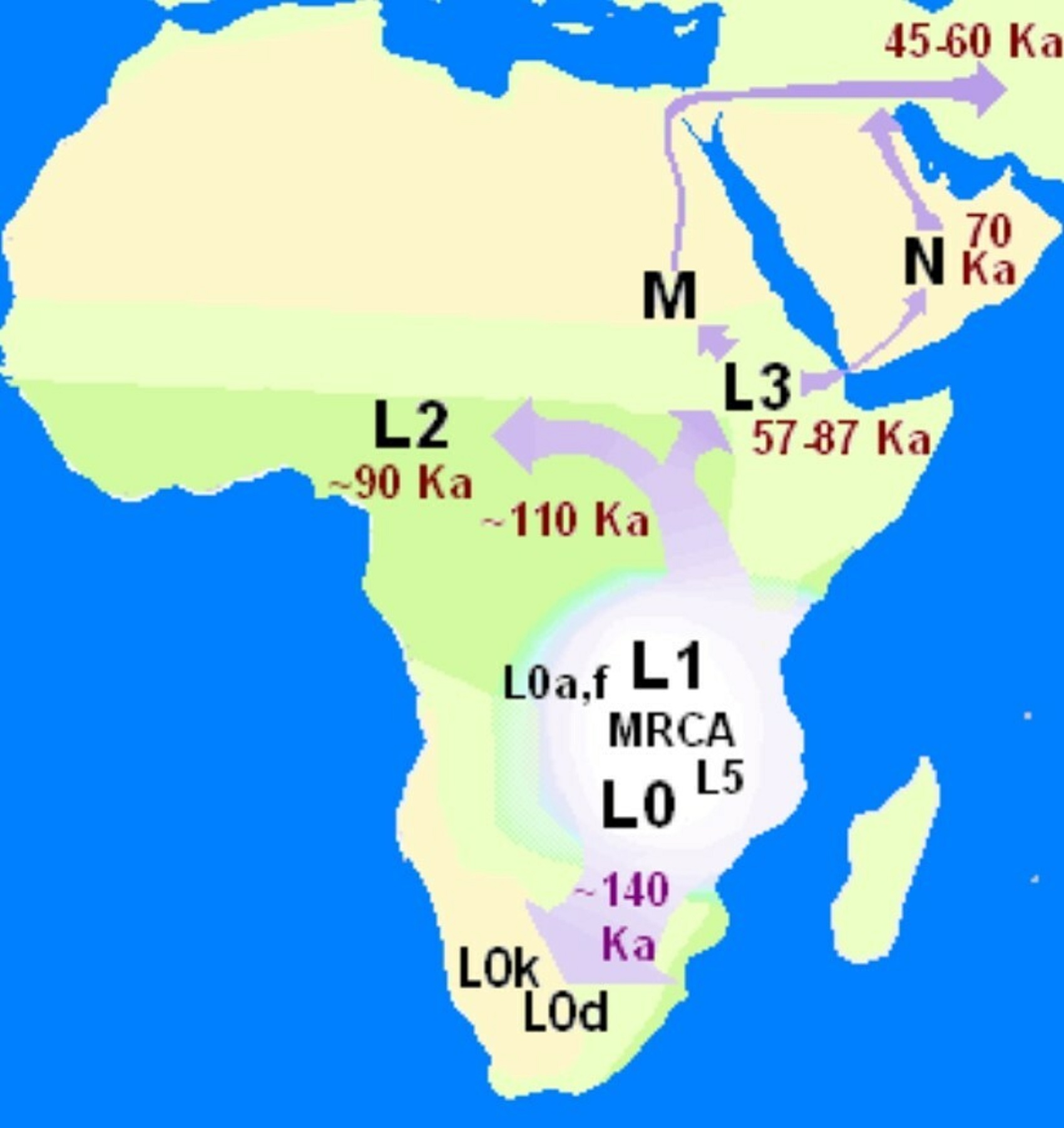
“In terms of mitochondrial haplogroups, the mt-MRCA is situated at the divergence of macro-haplogroup L into L0 and L1–6. As of 2013, estimates on the age of this split ranged at around 155,000 years ago, consistent with a date later than the speciation of Homo sapiens but earlier than the recent out-of-Africa dispersal.” ref
“There were at least several “out-of-Africa” dispersals of modern humans, possibly beginning as early as 270,000 years ago, including 215,000 years ago to at least Greece, and certainly via northern Africa and the Arabian Peninsula about 130,000 to 115,000 years ago. There is evidence that modern humans had reached China around 80,000 years ago. Practically all of these early waves seem to have gone extinct or retreated back, and present-day humans outside Africa descend mainly from a single expansion out 70,000–50,000 years ago. The most significant “recent” wave out of Africa took place about 70,000–50,000 years ago, via the so-called “Southern Route“, spreading rapidly along the coast of Asia and reaching Australia by around 65,000–50,000 years ago, (though some researchers question the earlier Australian dates and place the arrival of humans there at 50,000 years ago at earliest, while others have suggested that these first settlers of Australia may represent an older wave before the more significant out of Africa migration and thus not necessarily be ancestral to the region’s later inhabitants) while Europe was populated by an early offshoot which settled the Near East and Europe less than 55,000 years ago.” ref
“Haplogroup L3 is a human mitochondrial DNA (mtDNA) haplogroup. The clade has played a pivotal role in the early dispersal of anatomically modern humans. It is strongly associated with the out-of-Africa migration of modern humans of about 70–50,000 years ago. It is inherited by all modern non-African populations, as well as by some populations in Africa. Haplogroup L3 arose close to 70,000 years ago, near the time of the recent out-of-Africa event. This dispersal originated in East Africa and expanded to West Asia, and further to South and Southeast Asia in the course of a few millennia, and some research suggests that L3 participated in this migration out of Africa. L3 is also common amongst African Americans and Afro-Brazilians. A 2007 estimate for the age of L3 suggested a range of 104–84,000 years ago. More recent analyses, including Soares et al. (2012) arrive at a more recent date, of roughly 70–60,000 years ago. Soares et al. also suggest that L3 most likely expanded from East Africa into Eurasia sometime around 65–55,000 years ago years ago as part of the recent out-of-Africa event, as well as from East Africa into Central Africa from 60 to 35,000 years ago. In 2016, Soares et al. again suggested that haplogroup L3 emerged in East Africa, leading to the Out-of-Africa migration, around 70–60,000 years ago.” ref
“Haplogroups L6 and L4 form sister clades of L3 which arose in East Africa at roughly the same time but which did not participate in the out-of-Africa migration. The ancestral clade L3’4’6 has been estimated at 110 kya, and the L3’4 clade at 95 kya. The possibility of an origin of L3 in Asia was also proposed by Cabrera et al. (2018) based on the similar coalescence dates of L3 and its Eurasian-distributed M and N derivative clades (ca. 70 kya), the distant location in Southeast Asia of the oldest known subclades of M and N, and the comparable age of the paternal haplogroup DE. According to this hypothesis, after an initial out-of-Africa migration of bearers of pre-L3 (L3’4*) around 125 kya, there would have been a back-migration of females carrying L3 from Eurasia to East Africa sometime after 70 kya. The hypothesis suggests that this back-migration is aligned with bearers of paternal haplogroup E, which it also proposes to have originated in Eurasia. These new Eurasian lineages are then suggested to have largely replaced the old autochthonous male and female North-East African lineages.” ref
“According to other research, though earlier migrations out of Africa of anatomically modern humans occurred, current Eurasian populations descend instead from a later migration from Africa dated between about 65,000 and 50,000 years ago (associated with the migration out of L3). Vai et al. (2019) suggest, from a newly discovered old and deeply-rooted branch of maternal haplogroup N found in early Neolithic North African remains, that haplogroup L3 originated in East Africa between 70,000 and 60,000 years ago, and both spread within Africa and left Africa as part of the Out-of-Africa migration, with haplogroup N diverging from it soon after (between 65,000 and 50,000 years ago) either in Arabia or possibly North Africa, and haplogroup M originating in the Middle East around the same time as “N.” A study by Lipson et al. (2019) analyzing remains from the Cameroonian site of Shum Laka found them to be more similar to modern-day Pygmy peoples than to West Africans, and suggests that several other groups (including the ancestors of West Africans, East Africans, and the ancestors of non-Africans) commonly derived from a human population originating in East Africa between about 80,000-60,000 years ago, which they suggest was also the source and origin zone of haplogroup L3 around 70,000 years ago.” ref
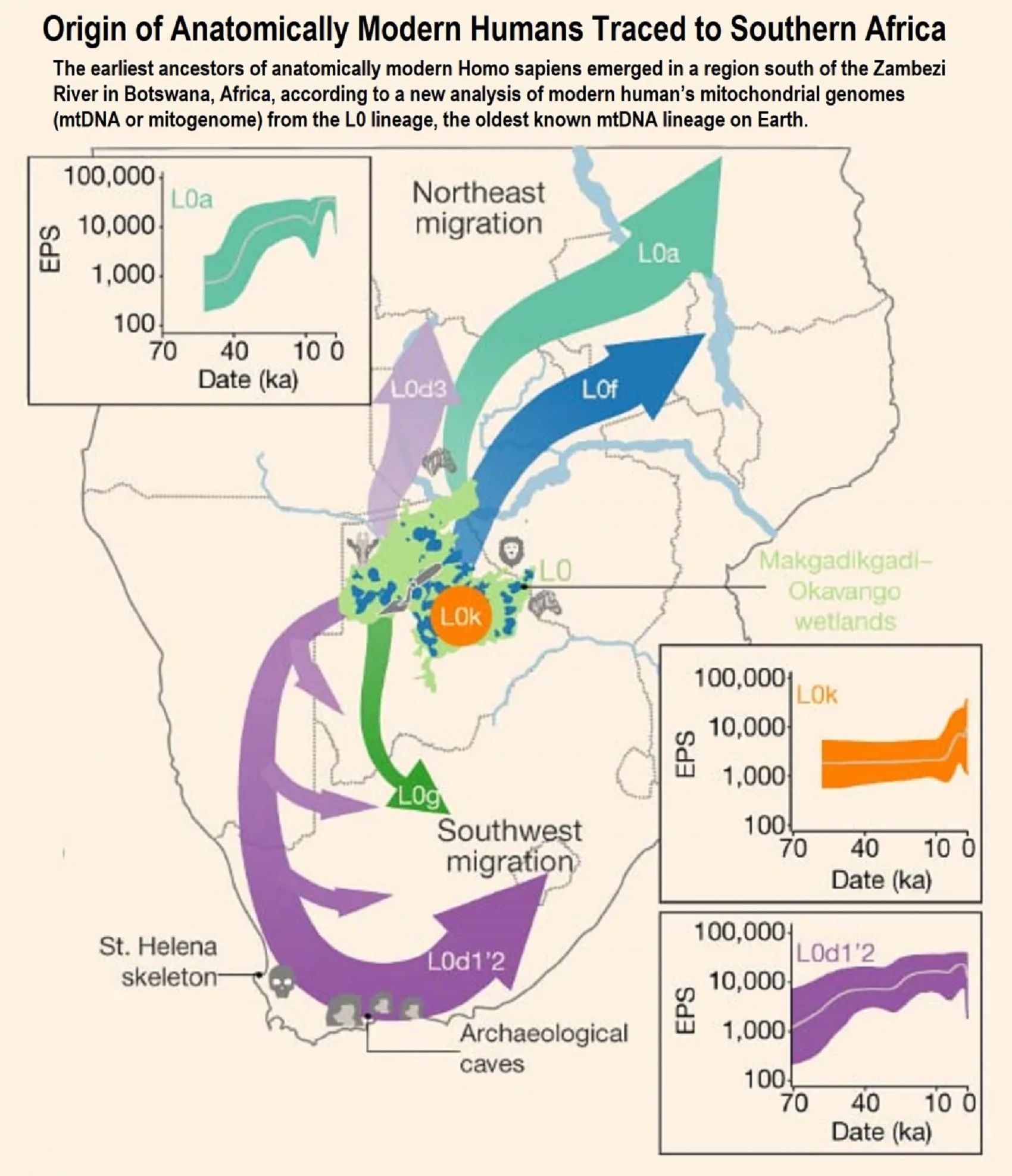
Pic ref
“The earliest ancestors of anatomically modern Homo sapiens emerged in a region south of the Zambezi River in Botswana, Africa, according to a new analysis of modern human’s mitochondrial genomes (mtDNA or mitogenome) from the L0 lineage, the oldest known mtDNA lineage on Earth.” ref

“When researchers completed the final analysis of the Human Genome Project in April 2003, they confirmed that the 3 billion base pairs of genetic letters in humans were 99.9 percent identical in every person. It also meant that individuals are, on average, 0.1 percent different genetically from every other person on the planet. And in that 0.1 percent lies the mystery of why some people are more susceptible to a particular illness or more likely to be healthy than their neighbor – or even another family member.” ref
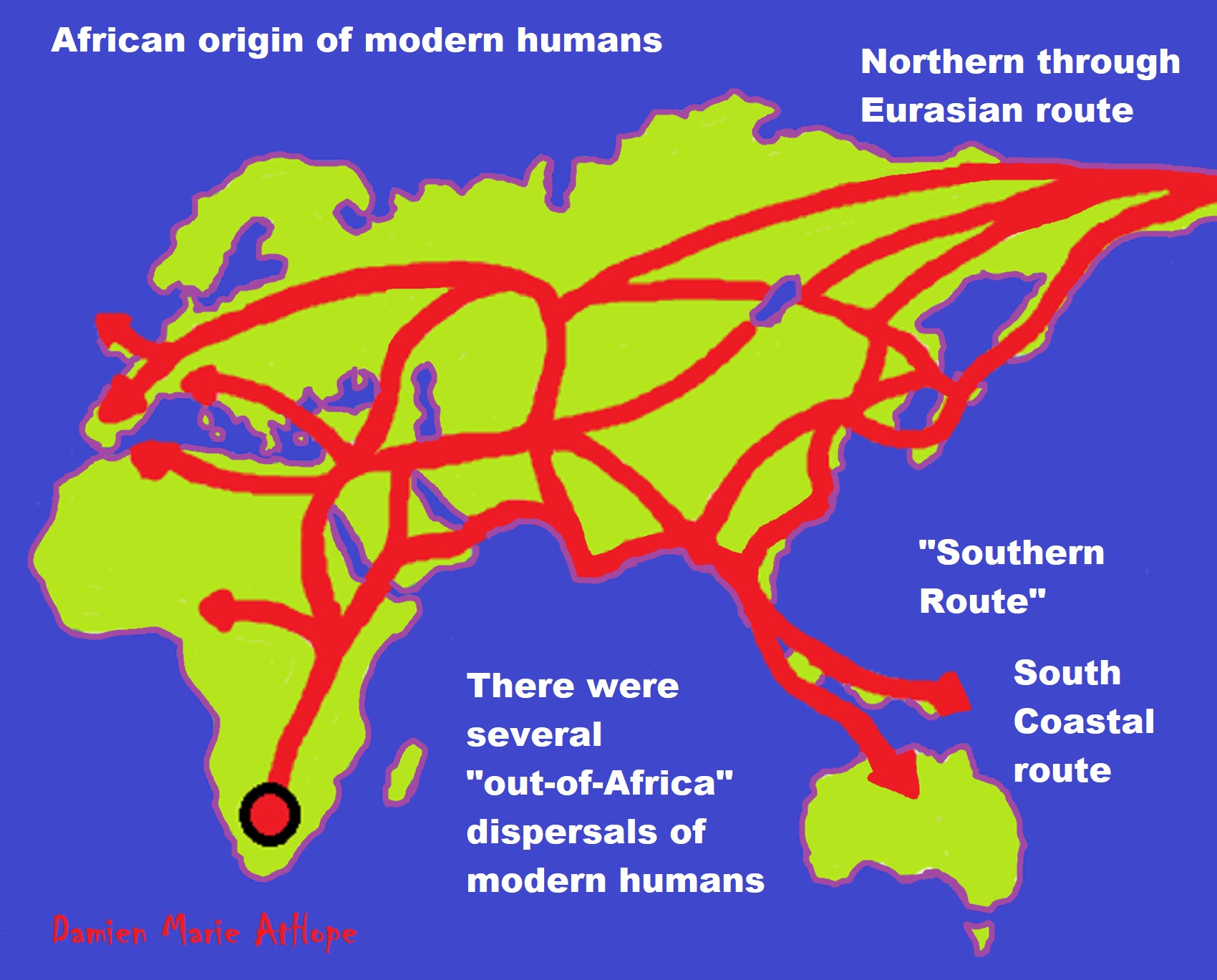
ref, ref, ref, ref, ref, ref, ref, ref
“There are two geographically plausible routes that have been proposed for humans to emerge from Africa: through the current Egypt and Sinai (Northern Route), or through Ethiopia, the Bab el Mandeb strait, and the Arabian Peninsula (Southern Route).” ref
“Although there is a general consensus on the African origin of early modern humans, there is disagreement about how and when they dispersed to Eurasia. This paper reviews genetic and Middle Stone Age/Middle Paleolithic archaeological literature from northeast Africa, Arabia, and the Levant to assess the timing and geographic backgrounds of Upper Pleistocene human colonization of Eurasia. At the center of the discussion lies the question of whether eastern Africa alone was the source of Upper Pleistocene human dispersals into Eurasia or were there other loci of human expansions outside of Africa? The reviewed literature hints at two modes of early modern human colonization of Eurasia in the Upper Pleistocene: (i) from multiple Homo sapiens source populations that had entered Arabia, South Asia, and the Levant prior to and soon after the onset of the Last Interglacial (MIS-5), (ii) from a rapid dispersal out of East Africa via the Southern Route (across the Red Sea basin), dating to ~74,000-60,000 years ago.” ref
“Within Africa, Homo sapiens dispersed around the time of its speciation, roughly 300,000 years ago. The so-called “recent dispersal” of modern humans took place about 70–50,000 years ago. It is this migration wave that led to the lasting spread of modern humans throughout the world. The coastal migration between roughly 70,000 and 50,000 years ago is associated with mitochondrial haplogroups M and N, both derivative of L3. Europe was populated by an early offshoot that settled the Near East and Europe less than 55,000 years ago. Modern humans spread across Europe about 40,000 years ago, possibly as early as 43,000 years ago, rapidly replacing the Neanderthal population.” ref, ref

ref, ref, ref, ref, ref, ref, ref, ref, ref, ref, ref, ref
“There were at least several “out-of-Africa” dispersals of modern humans, possibly beginning as early as 270,000 years ago, including 215,000 years ago to at least Greece, and certainly via northern Africa and the Arabian Peninsula about 130,000 to 115,000 years ago. These early waves appear to have mostly died out or retreated by 80,000 years ago.” ref
“The most significant “recent” wave out of Africa took place about 70,000–50,000 years ago, via the so-called “Southern Route“, spreading rapidly along the coast of Asia and reaching Australia by around 65,000–50,000 years ago, (though some researchers question the earlier Australian dates and place the arrival of humans there at 50,000 years ago at earliest, while others have suggested that these first settlers of Australia may represent an older wave before the more significant out of Africa migration and thus not necessarily be ancestral to the region’s later inhabitants) while Europe was populated by an early offshoot which settled the Near East and Europe less than 55,000 years ago.” ref
- “An Eastward Dispersal from Northeast Africa to Arabia 150,000–130,000 years ago based on the finds at Jebel Faya dated to 127,000 years ago (discovered in 2011). Possibly related to this wave are the finds from Zhirendong cave, Southern China, dated to more than 100,000 years ago. Other evidence of modern human presence in China has been dated to 80,000 years ago.” ref
- “The most significant out of Africa dispersal took place around 50–70,000 years ago via the so-called Southern Route, either before or after the Toba event, which happened between 69,000 and 77,000 years ago. This dispersal followed the southern coastline of Asia, and reached Australia around 65,000-50,000 years ago, or according to some research, by 50,000 years ago at earliest. Western Asia was “re-occupied” by a different derivation from this wave around 50,000 years ago, and Europe was populated from Western Asia beginning around 43,000 years ago.” ref
- “Wells (2003) describes an additional wave of migration after the southern coastal route, namely a northern migration into Europe at circa 45,000 years ago. However, this possibility is ruled out by Macaulay et al. (2005) and Posth et al. (2016), who argue for a single coastal dispersal, with an early offshoot into Europe.” ref
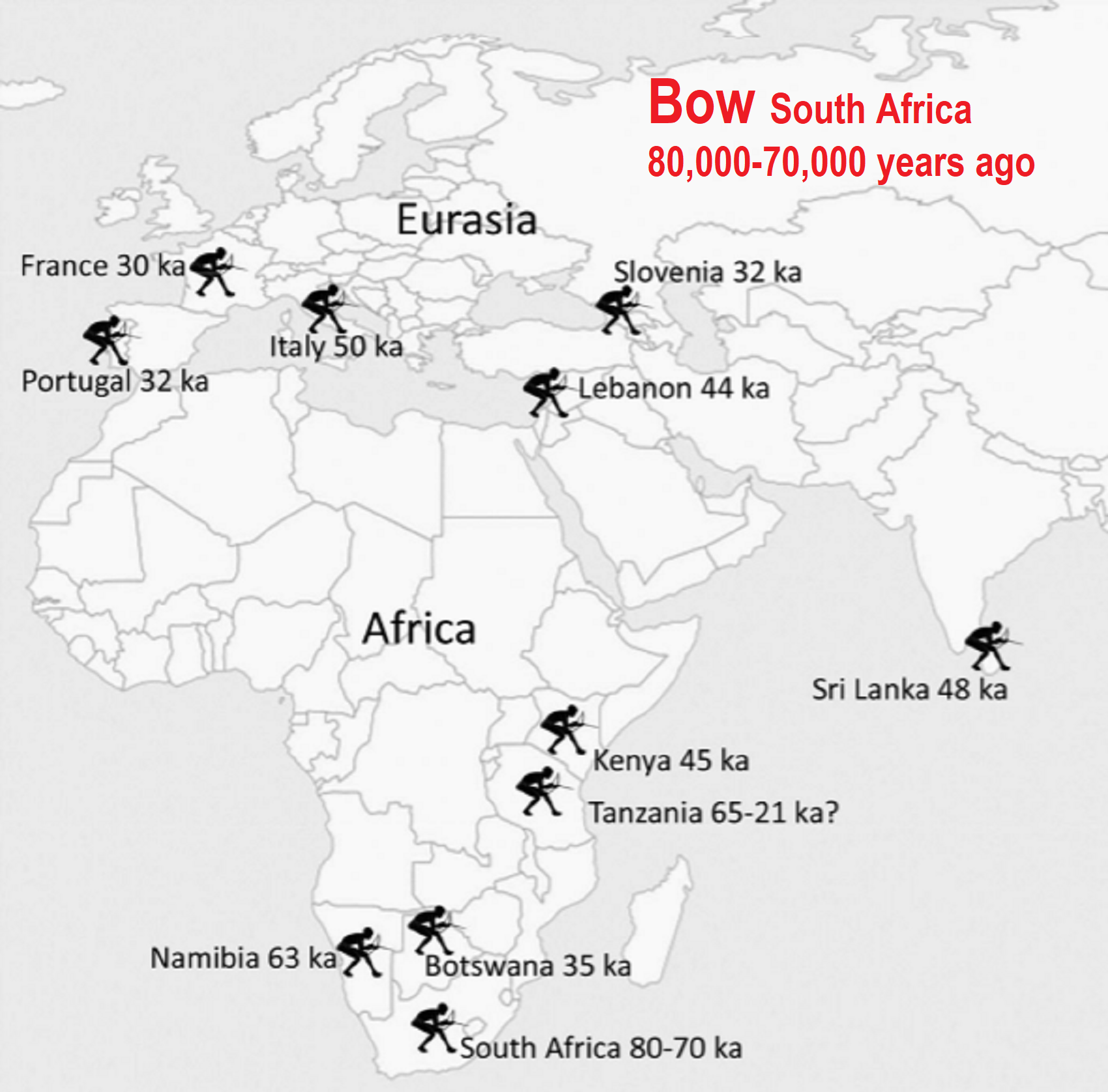
Did Pleistocene Africans use the spearthrower‐and‐dart?
“Well, evidence grows apace for ever-more ancient bow-and-arrow use. List of age estimates, locations, and current evidence bundles for the use of either arrows or darts by/before 30,000 years ago, the list may not be exhaustive, but we suggest that it broadly summarizes current knowledge (MSA = middle stone age).” ref
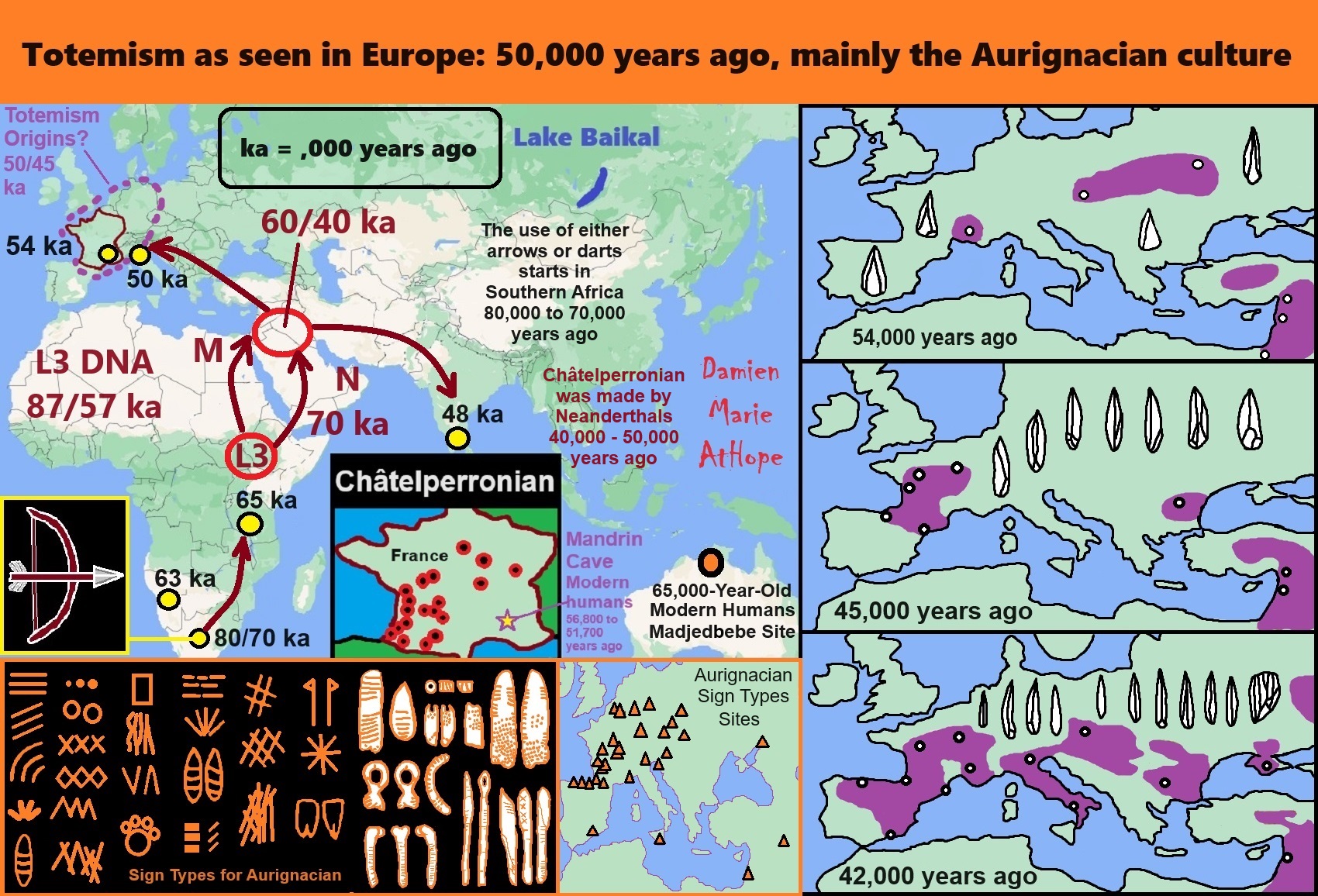
ref, ref, ref, ref, ref, ref, ref, ref, ref, ref, ref, ref, ref, ref, ref, ref, ref, ref, ref, ref, ref, ref, ref
This is my thoughts/speculations on the origins of Totemism
Totemism as seen in Europe: 50,000 years ago, mainly the Aurignacian culture
- Pre-Aurignacian “Châtelperronian” (Western Europe, mainly Spain and France, possible transitional/cultural diffusion between Neanderthals and humans around 50,000-40,000 years ago)
- Archaic–Aurignacian/Proto-Aurignacian (Europe around 46,000-35,000)
- Aurignacian “classical/early to late” (Europe and other areas around 38,000 – 26,000 years ago)
“In the realm of culture, the archeological evidence also supports a Neandertal contribution to Europe’s earliest modern human societies, which feature personal ornaments completely unknown before immigration and are characteristic of such Neandertal-associated archeological entities as the Chatelperronian and the Uluzzian.” – (PDF) Neandertals and Moderns Mixed, and It Matters: Link

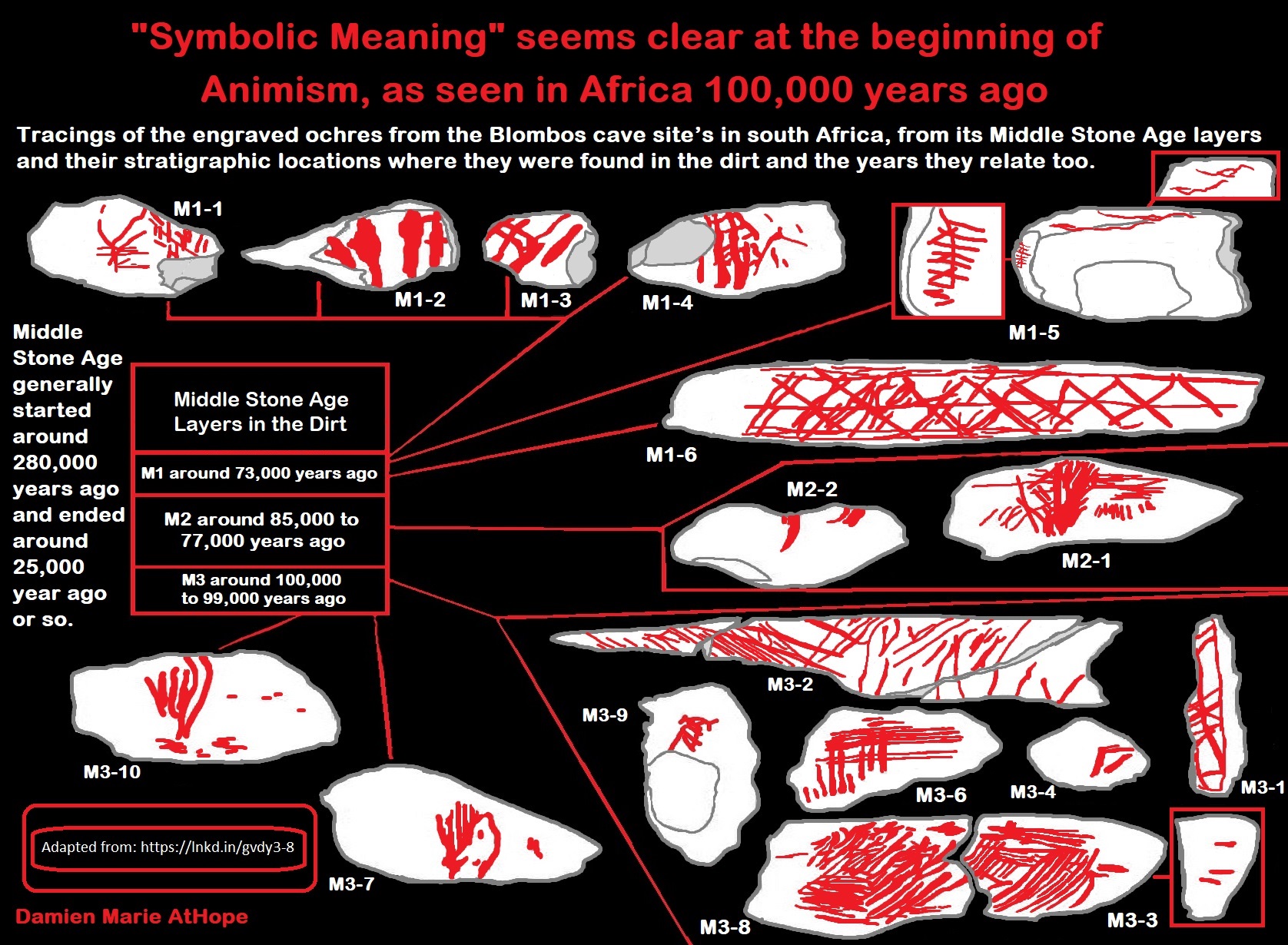
Adapted from: ref
Here we see the tracings of the engraved ochres from the Blombos cave site’s in South Africa, from its Middle Stone Age layers and their stratigraphic locations where they were found in the dirt and the years they relate to. M1 dates to around 73,000 years ago, M2 around 85,000 to 77,000 years ago, and M3 dates to around 100,000 to 99,000 years ago. Middle Stone Age generally started around 280,000 years ago and ended around 25,000 years ago or so. Therefore, amazing as it is, here we have proof that “Symbolic Meaning,” seems to be clear at the beginning of Animism, as seen in Africa 100,000 years ago. In a landmark study, it was demonstrated, for the first time, that there are seeming tradition in the production of geometric engraved representations, includes the production of a number of different patterns and this set of evolving traditions have roots that go back in time to at least 100,000 years ago (around a time I say Animism begins in Africa). The fact that they were created, that most of them are deliberate and were made with representational intent, strongly suggests they functioned as artifacts within a society by symbols with meaning. ref
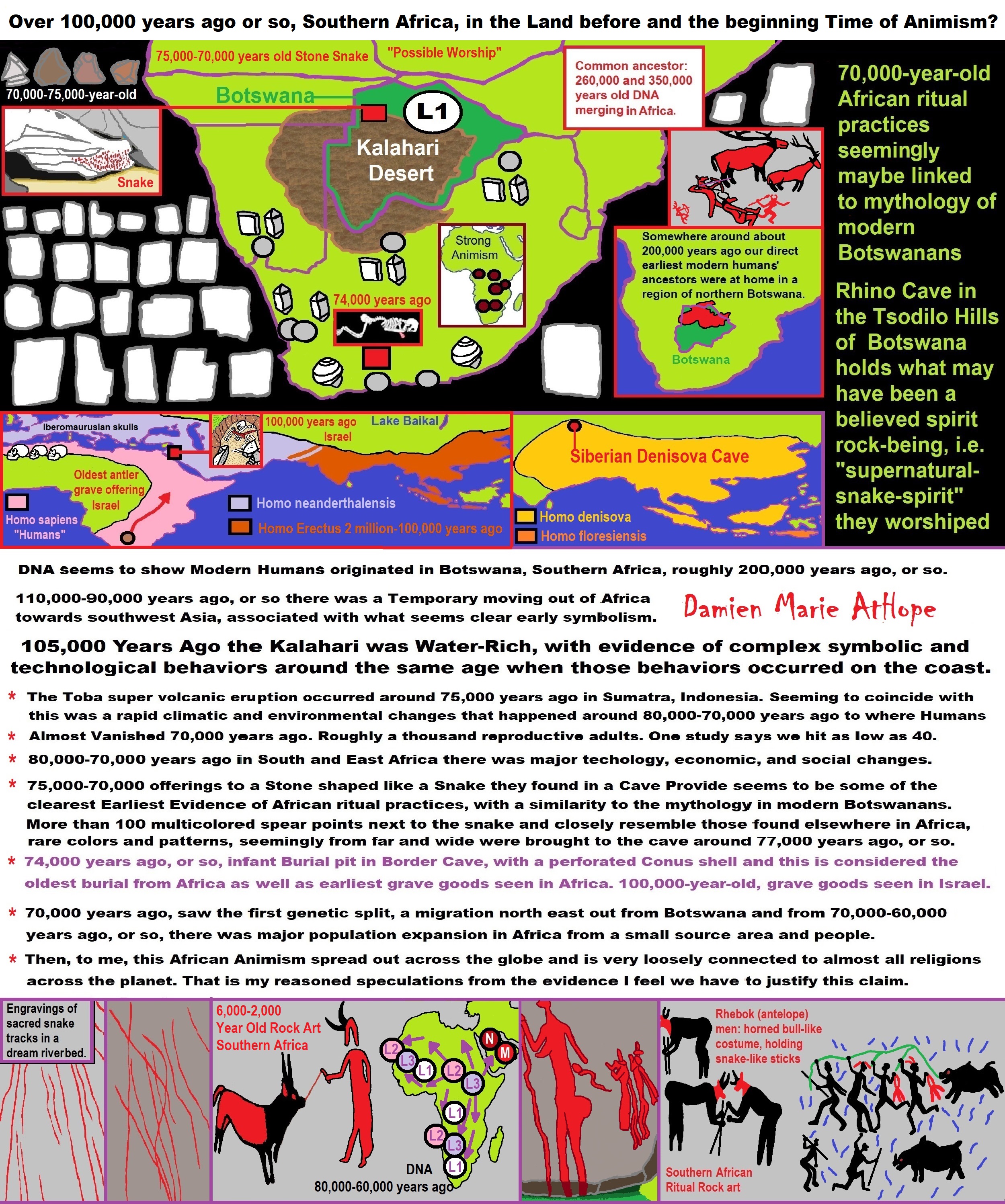
ref, ref, ref, ref, ref, ref, ref, ref, ref, ref, ref, ref, ref, ref, ref, ref, ref, ref, ref, ref, ref, ref, ref, ref, ref, ref, ref, ref, ref, ref, ref, ref, ref, ref, ref, ref, ref, ref, ref, ref, ref, ref, ref, ref, ref, ref, ref, ref, ref, ref, ref, ref
Animism: a belief among some indigenous people, young children, or all religious people!
Over 100,000 years ago or so, Southern Africa, in the Land before and the beginning Time of Animism: LINK
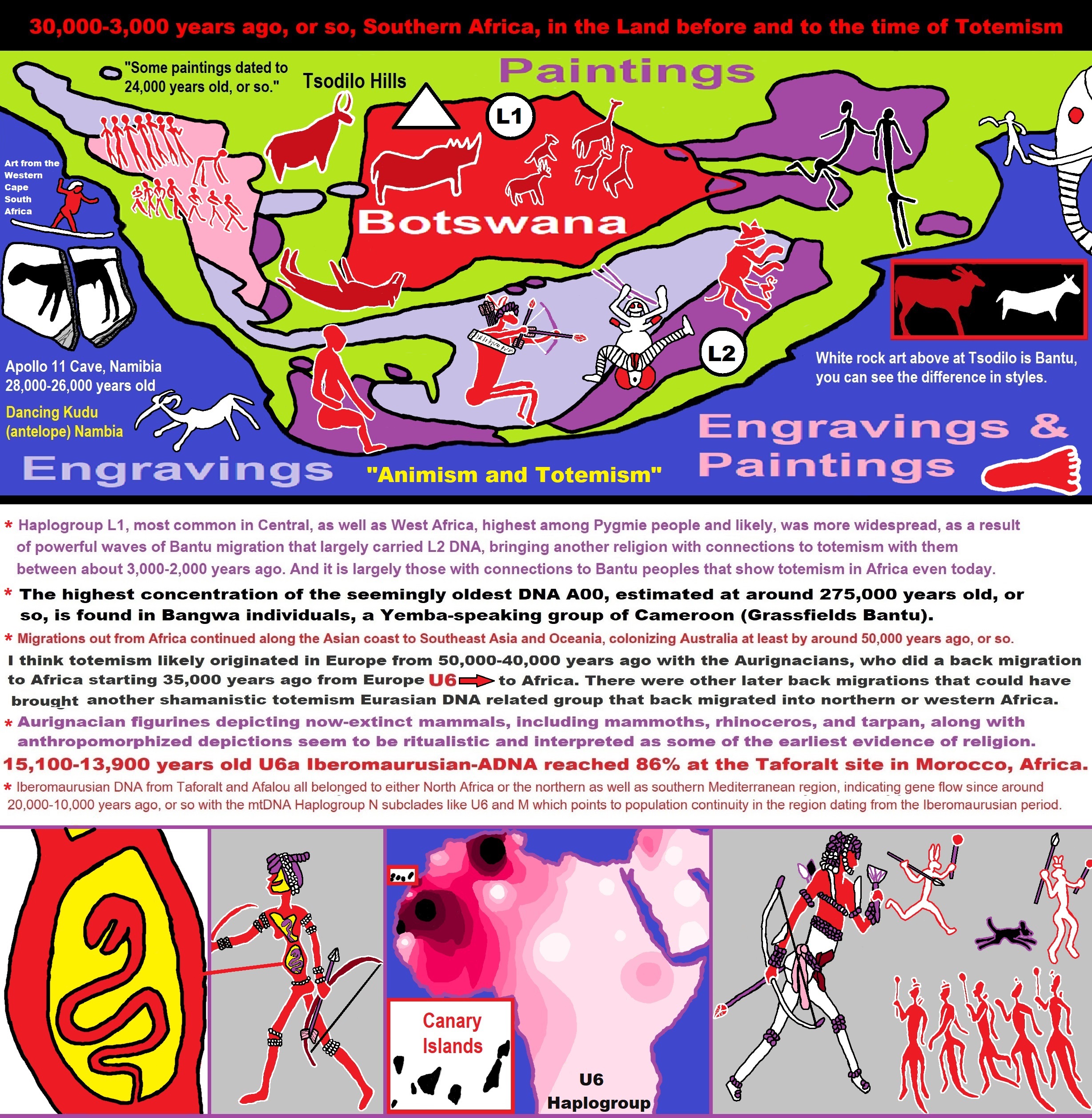
ref, ref, ref, ref, ref, ref, ref, ref, ref, ref, ref, ref, ref, ref, ref, ref, ref, ref, ref, ref, ref, ref, ref, ref, ref, ref, ref, ref, ref, ref, ref, ref, ref, ref, ref, ref, ref, ref, ref, ref, ref, ref, ref, ref, ref, ref, ref, ref, ref, ref, ref, ref, ref, ref, ref, ref, ref, ref, ref, ref,
Explaining the Earliest Religious Expression, that of Animism (beginning 100,000 to 70,000 years ago?) to Totemism (beginning 30,000 to 3,000 years ago?) in Southern Africa: LINK

At Border Cave, a “savanna-woodland” vegetation community is implied before 100,000 years ago and the matching density of stone tools vary considerably through time, with high frequencies of stone blades occurring before 100,000 years ago. ref
Around 74,000 years ago, in Border Cave, South Africa, the burial of a 4 to 6-month-old child was found in a pit with a personal ornament, a perforated Conus shell. ref
Border Cave is the only African site covering a time span of 250,000 years, with Middle Stone Age human remains, and also records the first emergence of key cultural innovations such as things like grass bedding dated between 70,000 to 30,000 years ago. ref
In South Africa, some of the oldest beads are made of marine shells that come from the Still Bay layers of Blombos Cave dating back to around 72,000 years ago, and engraved ostrich eggshells dated to around 60,000 years ago from Diepkloof in South Africa. Some of the oldest beads made of non-marine shells involve ostrich eggshells and from Border Cave, there are some that date to around 42,000 years ago. Beads were also collected from the late MSA/early LSA context of similar age at Apollo 11 and from layers associated with MSA at Boomplaas Cave. Furthermore, beads were also reported from the MSA at Cave of Hearths. Other sub-contemporaneous beads have been recovered north of South Africa. ref
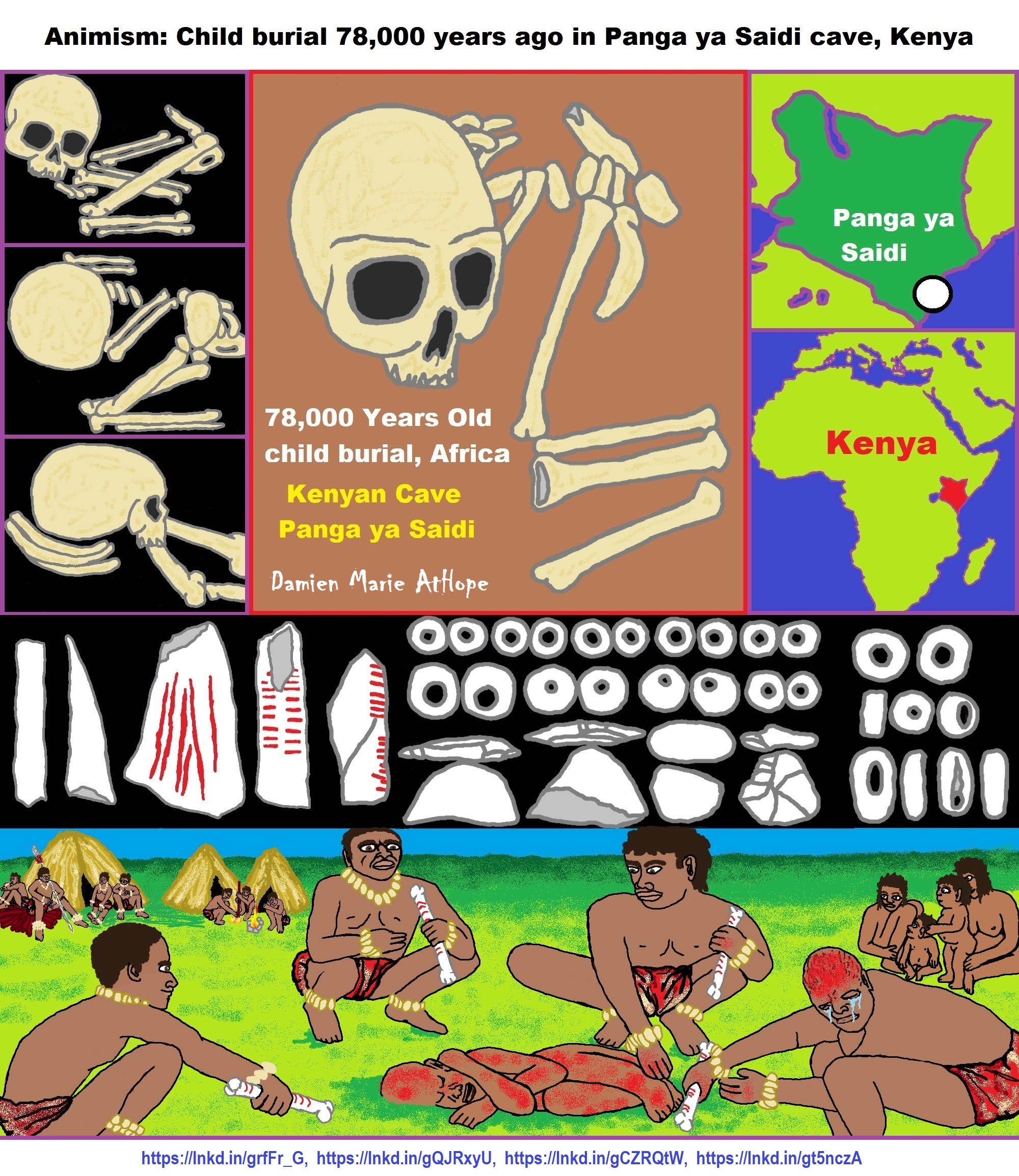
“Mtoto’s burial, to experts it is believed the child was around three years old when they died and was likely wrapped in a shroud and had their head on a pillow. Besides the seemingly deliberate position of the body, the team noticed a few clues that suggested the child was swaddled in cloth, possibly with the intention of preserving the corpse. They also speculate the body was placed in a cave fissure — known as funerary caching — before being covered with sediment.” ref, ref
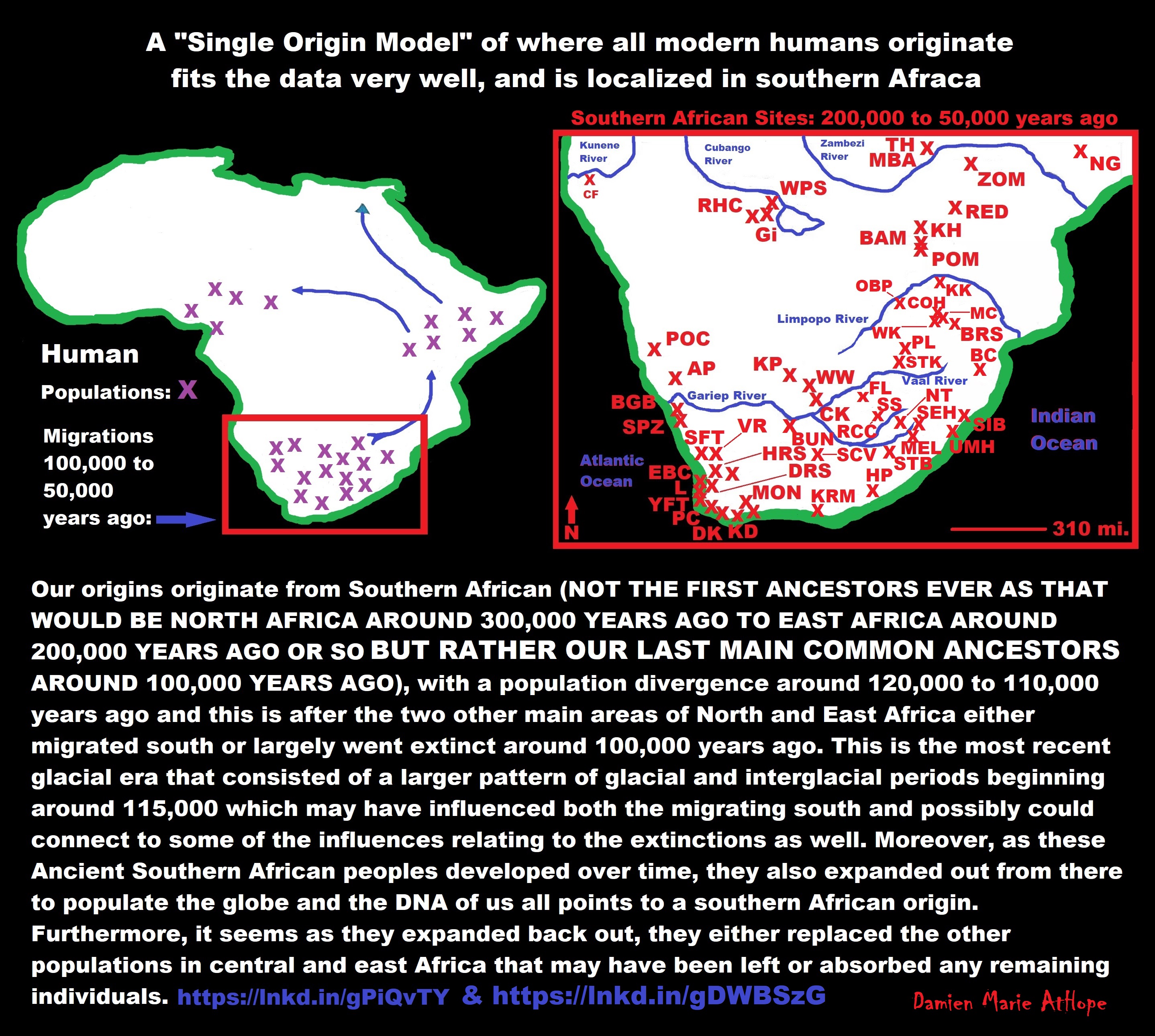
Our origins originate from Southern African (NOT THE FIRST ANCESTORS EVER AS THAT WOULD BE NORTH AFRICA AROUND 300,000 YEARS AGO TO EAST AFRICA AROUND 200,000 YEARS AGO OR SO BUT RATHER OUR LAST MAIN COMMON ANCESTORS AROUND 100,000 YEARS AGO), with a population divergence around 120,000 to 110,000 years ago and this is after the two other main areas of North and East Africa either migrated south or largely went extinct around 100,000 years ago. This is the most recent glacial era that consisted of a larger pattern of glacial and interglacial periods beginning around 115,000 which may have influenced both the migrating south and possibly could connect to some of the influences relating to the extinctions as well. Moreover, as these Ancient Southern African peoples developed over time, they also expanded out from there to populate the globe, and the DNA of us all points to a southern African origin. Furthermore, it seems as they expanded back out, they either replaced the other populations in central and east Africa that may have been left or absorbed any remaining individuals. ref
Southern African Middle Stone Age sites:
(Ap) Apollo 11; (BAM) Bambata; (BBC) Blombos Cave; (BC) Border Cave; (BGB)Boegoeberg; (BPA) Boomplaas; (BRS) Bushman Rock Shelter; (BUN) Bundu Farm; (CF)Cufema Reach; (CK) Canteen Kopje; (COH) Cave of Hearths; (CSB) Cape St Blaize; (DK)Die Kelders Cave 1; (DRS) Diepkloof Rock Shelter; (EBC) Elands Bay Cave; (FL) Florisbad; (≠GI) ≠Gi; (HP) Howiesons Poort; (HRS) Hollow Rock Shelter; (KD) Klipdrift; (KKH) Klein Kliphuis; (KH) Khami; (KK) Kudu Koppie; (KP) Kathu Pan; (KRM) Klasies River Main Site; (L) Langebaan; (MBA) Mumbwa Caves; (MC) Mwulu’s Cave; (MEL)Melikane; (MON) Montagu Cave; (NBC) Nelson Bay Cave; (NG) Ngalue; (NT) Ntloana Tšoana; (OBP) Olieboomspoort; (PC) Peers Cave; (POC) Pockenbank; (PL) Plover’s Lake; (POM) Pomongwe; (PP) Pinnacle Point; (RCC) Rose Cottage Cave; (RED) Redcliff; (RHC) Rhino Cave; (SCV) Seacow Valley; (SFT) Soutfontein; (SEH) Sehonghong; (SIB)Sibudu Cave; (SPZ) Spitzkloof Rock Shelter; (SS) Sunnyside 1; (STB) Strathalan Cave B; (STK) Sterkfontein; (TR) Twin Rivers; (UMH) Umhlatuzana; (VR) Varsche Rivier 003; (WPS) White Paintings Shelter; (WK) Wonderkrater; (WW) Wonderwerk; (YFT)Ysterfontein 1; (ZOM) Zombepata Cave. ref

Stone Snake of South Africa: “first human worship” 70,000 years ago
Evidence from Rhino Cave, in Botswana produced results that revealed a very special set of behavioral patterns which best-fit ritualized behavior. There were colorful non-local stone tools carefully and often elaborately made just to be offered to the stone snake; burned and smashed beyond use then abandoned. ref
Religions continuing in our modern world, full of science and facts, should be seen as little more than a set of irrational conspiracy theories of reality. Nothing more than a confused reality made up of unscientific echoes from man’s ancient past. Rational thinkers must ask themselves why continue to believe in religions’ stories. Religion myths which are nothing more than childlike stories and obsolete tales once used to explain how the world works, acting like magic was needed when it was always only nature. These childlike religious stories should not even be taken seriously, but sadly too often they are.
Often without realizing it, we accumulate beliefs that we allow to negatively influence our lives. In order to bring about awareness, we need to be willing to alter skewed beliefs. Rational thinkers must examine the facts instead of blindly following beliefs or faith. Below is a collection of researched information such as archaeology, history, linguistics, genetics, art, science, sociology, geography, psychology, philosophy, theology, biology, and zoology. It will make you question your beliefs with information, inquiries, and ideas to ponder and expand on. The two main goals are to expose the evolution of religion starting by around 100,000 years ago and to offer challenges to remove the rationale of faith. It is like an intervention for belief in myths that have plagued humankind for way too long. We often think we know what truth is nevertheless this can be but a vantage point away from losing credibility if we are not willing to follow valid and reliable reason and evidence.
The door of reason opens not once but many times. Come on a journey to free thought where the war is against ignorance and the victor is a rational mind. Understanding Religion Evolution: Pre-Animism (at least 300,000 years ago), * Animism (such as that seen in Africa: 100,000 years ago), *Totemism (Europe: 50,000 years ago), * Shamanism (beginning around 30,000 years ago), *Paganism (beginning around 12,000 years ago), * Progressed organized religion (around 5,000 years ago), * CURRENT “World” RELIGIONS (after 4,000 years ago), and * Early Atheistic Doubting (at least by around 2,600 Years Ago)
In a general way, it all starts with Animism (a theoretical belief in supernatural powers/spirits) and this is physically expressed in or with Totemism (a theoretical belief in a mythical relationship with powers/spirits through a totem item), which then enlists a full-time specific person to perform this worship and believed interaction as Shamanism (a theoretical belief in access and influence with spirits through rituals). In addition, there is the further employment of myths and gods added to all the above, which is Paganism and is often a lot more nature-based than most current top world religions, thus hinting to their close link to more ancient religious thinking from which it stems.
My hypothesis is expressed with an explanation of the building of a theoretical house (modern religions development). It seems ancient peoples had to survived amazing threats in a “dangerous universe by superstition perceived as good and evil”, and human “immorality or imperfection of the soul”, which was thought to affect the still living and led to ancestor worship. Presumably, this ancestor worship led to the belief in supernatural beings, which some of these were turned into the belief in gods. This feeble myth called gods were just a human conceived idea that was “made from nothing into something over and over, changing again and again, taking on more as they evolve, and all the while, they are thought to be special.” However, it is just supernatural animistic spirit-belief perceived as sacred.
Historically, around 5,000 years ago, in large city-state societies such as Egypt or Iraq culminated to make religion into something kind of new, a sociocultural-governmental-religious monarchy, where all or at least many of the people of such large city-state societies seem familiar with and committed to the existence of “religion” as the integrated life identity package of control dynamics with a fixed closed magical doctrine. However, this juggernaut integrated religion identity package of Dogmatic-Propaganda certainly did not exist or if developed to an extent, it was highly limited in most smaller prehistoric societies as they seem to lack most of the strong control dynamics with a fixed closed magical doctrine. These magical beliefs could be at times be added or removed and many people just want to see developed religious dynamics everywhere, even if it is not. Instead, all that is found is largely fragments until the domestication of religion.
Religions, as we think of them today, are a new fad, even if they go back to around 6,000 years in the timeline of human existence. This amounts to almost nothing when seen in the long slow evolution of religion that started at least around 70,000 years ago with one of the oldest ritual worship. This message of how religion and gods are intertwined with humans is clearly a man-made idea that was developed slowly as it was invented, reinvented, and implemented piece by piece, which discredits them all. This seems to be a simple point, which some are just not grasping how devastating this is to any claims of truth when we can see the lie clearly in the archeological sites.
“Religion is an Evolved Product”
Pre-Animism (at least 300,000 years ago)
Around a million years ago, I surmise that Pre-Animism, “animistic superstitionism”, began, Around 400,000 Years ago shows Sociocultural Evolution, and then led to the animistic somethingism or animistic supernaturalism, which is at least 300,000 years old and about 100,00 years ago, it evolves to a representation of general Animism, which is present in today’s religions. There is also Homo Naledi and an Intentional Cemetery “Pre-Animism” dating to around 250,000 years ago. And, Neanderthals “Primal Religion (Pre-Animism/Animism?)” Mystery Cave Rings 175,000 Years Ago. Neanderthals were the first humans to intentionally bury the dead, around 130,000 years ago at sites such as Krapina in Croatia.
Pre-animism ideas can be seen in rock art such as that expressed in portable anthropomorphic art, which may be related to some kind of ancestor veneration. This magical thinking may stem from a social or non-religious function of ancestor veneration, which cultivates kinship values such as filial piety, family loyalty, and continuity of the family lineage. Ancestor veneration occurs in societies with every degree of social, political, and technological complexity and it remains an important component of various religious practices in modern times.
Humans are not the only species, which bury their dead. The practice has been observed in chimpanzees, elephants, and possibly dogs. Intentional burial, particularly with grave goods, signify a “concern for the dead” and Neanderthals were the first human species to practice burial behavior and intentionally bury their dead, doing so in shallow graves along with stone tools and animal bones. Exemplary sites include Shanidar in Iraq, Kebara Cave in Israel and Krapina in Croatia. The earliest undisputed human burial dates back 100,000 years ago with remains stained with red ochre, which show ritual intentionality similar to the Neanderthals before them. ref, ref
Animism (such as that seen in Africa: 100,000 years ago)
Did Neanderthals teach us “Primal Religion (Pre-Animism/Animism?)” 120,000 Years Ago? Homo sapiens – is known to have reached the Levant between 120,000 and 90,000 years ago, but that exit from Africa evidently went extinct. 100,000 years ago, in Qafzeh, Israel, the oldest intentional burial had 15 African individuals covered in red ocher was from a group who visited and returned back to Africa. 100,000 to 74,000 years ago, at Border Cave in Africa, an intentional burial of an infant with red ochre and a shell ornament, which may have possible connections to the Africans buried in Qafzeh.
Animism is approximately a 100,000-year-old belief system and believe in spirit-filled life and/or afterlife. If you believe like this, regardless of your faith, you are a hidden animist.
The following is evidence of Animism: 100,000 years ago, in Qafzeh, Israel, the oldest intentional burial had 15 African individuals covered in red ocher was from a group who visited and returned back to Africa. 100,000 to 74,000 years ago, at Border Cave in Africa, an intentional burial of an infant with red ochre and a shell ornament, which may have possible connections to the Africans buried in Qafzeh, Israel. 120,000 years ago, did Neanderthals teach us Primal Religion (Pre-Animism/Animism) as they too used red ocher and burials? ref, ref
It seems to me, it may be the Neanderthals who may have transmitted a “Primal Religion (Animism)” or at least burial and thoughts of an afterlife. The Neanderthals seem to express what could be perceived as a Primal “type of” Religion, which could have come first and is supported in how 250,000 years ago, the Neanderthals used red ochre and 230,000 years ago shows evidence of Neanderthal burial with grave goods and possibly a belief in the afterlife. ref
Do you think it is crazy that the Neanderthals may have transmitted a “Primal Religion”? Consider this, it appears that 175,000 years ago, the Neanderthals built mysterious underground circles with broken off stalactites. This evidence suggests that the Neanderthals were the first humans to intentionally bury the dead, doing so in shallow graves along with stone tools and animal bones. Exemplary sites include Shanidar in Iraq, Kebara Cave in Israel and Krapina in Croatia. Other evidence may suggest the Neanderthals had it transmitted to them by Homo heidelbergensis, 350,000 years ago, by their earliest burial in a shaft pit grave in a cave that had a pink stone axe on the top of 27 Homo heidelbergensis individuals and 250,000 years ago, Homo naledi had an intentional cemetery in South Africa cave. ref, ref, ref, ref, ref
Totemism (Europe: 50,000 years ago)
Did Neanderthals Help Inspire Totemism? Because there is Art Dating to Around 65,000 Years Ago in Spain? Totemism as seen in Europe: 50,000 years ago, mainly the Aurignacian culture. Pre-Aurignacian “Châtelperronian” (Western Europe, mainly Spain and France, possible transitional/cultural diffusion between Neanderthals and Humans around 50,000-40,000 years ago). Archaic–Aurignacian/Proto-Aurignacian Humans (Europe around 46,000-35,000). And Aurignacian “classical/early to late” Humans (Europe and other areas around 38,000 – 26,000 years ago).
Totemism is approximately a 50,000-year-old belief system and believe in spirit-filled life and/or afterlife that can be attached to or be expressed in things or objects. If you believe like this, regardless of your faith, you are a hidden totemist.
Toetmism may be older as there is evidence of what looks like a Stone Snake in South Africa, which may be the “first human worship” dating to around 70,000 years ago. Many archaeologists propose that societies from 70,000 to 50,000 years ago such as that of the Neanderthals may also have practiced the earliest form of totemism or animal worship in addition to their presumably religious burial of the dead. Did Neanderthals help inspire Totemism? There is Neanderthals art dating to around 65,000 years ago in Spain. ref, ref
Shamanism (beginning around 30,000 years ago)
Shamanism (such as that seen in Siberia Gravettian culture: 30,000 years ago). Gravettian culture (34,000–24,000 years ago; Western Gravettian, mainly France, Spain, and Britain, as well as Eastern Gravettian in Central Europe and Russia. The eastern Gravettians, which include the Pavlovian culture). And, the Pavlovian culture (31,000 – 25,000 years ago such as in Austria and Poland). 31,000 – 20,000 years ago Oldest Shaman was Female, Buried with the Oldest Portrait Carving.
Shamanism is approximately a 30,000-year-old belief system and believe in spirit-filled life and/or afterlife that can be attached to or be expressed in things or objects and these objects can be used by special persons or in special rituals that can connect to spirit-filled life and/or afterlife. If you believe like this, regardless of your faith, you are a hidden shamanist.
Around 29,000 to 25,000 years ago in Dolní Vestonice, Czech Republic, the oldest human face representation is a carved ivory female head that was found nearby a female burial and belong to the Pavlovian culture, a variant of the Gravettian culture. The left side of the figure’s face was a distorted image and is believed to be a portrait of an elder female, who was around 40 years old. She was ritualistically placed beneath a pair of mammoth scapulae, one leaning against the other. Surprisingly, the left side of the skull was disfigured in the same manner as the aforementioned carved ivory figure, indicating that the figure was an intentional depiction of this specific individual. The bones and the earth surrounding the body contained traces of red ocher, a flint spearhead had been placed near the skull, and one hand held the body of a fox. This evidence suggests that this was the burial site of a shaman. This is the oldest site not only of ceramic figurines and artistic portraiture but also of evidence of early female shamans. Before 5,500 years ago, women were much more prominent in religion.
Archaeologists usually describe two regional variants: the western Gravettian, known namely from cave sites in France, Spain, and Britain, and the eastern Gravettian in Central Europe and Russia. The eastern Gravettians include the Pavlovian culture, which were specialized mammoth hunters and whose remains are usually found not in caves but in open air sites. The origins of the Gravettian people are not clear, they seem to appear simultaneously all over Europe. Though they carried distinct genetic signatures, the Gravettians and Aurignacians before them were descended from the same ancient founder population. According to genetic data, 37,000 years ago, all Europeans can be traced back to a single ‘founding population’ that made it through the last ice age. Furthermore, the so-called founding fathers were part of the Aurignacian culture, which was displaced by another group of early humans members of the Gravettian culture. Between 37,000 years ago and 14,000 years ago, different groups of Europeans were descended from a single founder population. To a greater extent than their Aurignacian predecessors, they are known for their Venus figurines. ref, ref, ref, ref, ref, ref, ref, ref, ref, ref, & ref
Paganism (beginning around 12,000 years ago)
Paganism (such as that seen in Turkey: 12,000 years ago). Gobekli Tepe: “first human-made temple” around 12,000 years ago. Sedentism and the Creation of goddesses around 12,000 years ago as well as male gods after 7,000 years ago. Pagan-Shaman burial in Israel 12,000 years ago and 12,000 – 10,000 years old Paganistic-Shamanistic Art in a Remote Cave in Egypt. Skull Cult around 11,500 to 8,400 Years Ago and Catal Huyuk “first religious designed city” around 10,000 years ago.
Paganism is approximately a 12,000-year-old belief system and believe in spirit-filled life and/or afterlife that can be attached to or be expressed in things or objects and these objects can be used by special persons or in special rituals that can connect to spirit-filled life and/or afterlife and who are guided/supported by a goddess/god, goddesses/gods, magical beings, or supreme spirits. If you believe like this, regardless of your faith, you are a hidden paganist.
Around 12,000 years ago, in Turkey, the first evidence of paganism is Gobekli Tepe: “first human-made temple” and around 9,500 years ago, in Turkey, the second evidence of paganism is Catal Huyuk “first religious designed city”. In addition, early paganism is connected to Proto-Indo-European language and religion. Proto-Indo-European religion can be reconstructed with confidence that the gods and goddesses, myths, festivals, and form of rituals with invocations, prayers, and songs of praise make up the spoken element of religion. Much of this activity is connected to the natural and agricultural year or at least those are the easiest elements to reconstruct because nature does not change and because farmers are the most conservative members of society and are best able to keep the old ways.
The reconstruction of goddesses/gods characteristics may be different than what we think of and only evolved later to the characteristics we know of today. One such characteristic is how a deity’s gender may not be fixed, since they are often deified forces of nature, which tend to not have genders. There are at least 40 deities and the Goddesses that have been reconstructed are: *Pria, *Pleto, *Devi, *Perkunos, *Aeusos, and *Yama.
The reconstruction of myths can be connected to Proto-Indo-European culture/language and by additional research, many of these myths have since been confirmed including some areas that were not accessible to the early writers such as Latvian folk songs and Hittite hieroglyphic tablets. There are at least 28 myths and one of the most widely recognized myths of the Indo-Europeans is the myth, “Yama is killed by his brother Manu” and “the world is made from his body”. Some of the forms of this myth in various Indo-European languages are about the Creation Myth of the Indo-Europeans.
The reconstruction of rituals can be connected to Proto-Indo-European culture/language and is estimated to have been spoken as a single language from around 6,500 years ago. One of the earliest ritual is the construction of kurgans or mound graves as a part of a death ritual. kurgans were inspired by common ritual-mythological ideas. Kurgans are complex structures with internal chambers. Within the burial chamber at the heart of the kurgan, elite individuals were buried with grave goods and sacrificial offerings, sometimes including horses and chariots.
The speakers of Pre-Proto-Indo-European lived in Turkey and it associates the distribution of historical Indo-European languages with the expansion around 9,000 years ago, with a proposed homeland of Proto-Indo-European proper in the Balkans around 7,000 years ago. The Proto-Indo-European Religion seemingly stretches at least back around 6,000 years ago or likely much further back and I believe Paganism is possibly an approximately 12,000-year-old belief system.
The earliest kurgans date to 6,000 years ago and are connected to the Proto-Indo-European in the Caucasus. In fact, around 7,000 years ago, there appears to be pre-kurgan in Siberia. Around 7,000 to 2,500 years ago and beyond, kurgans were built with ancient traditions still active in Southern Siberia and Central Asia, which display the continuity of the archaic forming methods. Kurgan cultures are divided archaeologically into different sub-cultures such as Timber Grave, Pit Grave, Scythian, Sarmatian, Hunnish, and Kuman–Kipchak. Kurgans have been found from the Altay Mountains to the Caucasus, Ukraine, Romania, and Bulgaria. Around 5,000 years ago, kurgans were used in the Ukrainian and Russian flat unforested grasslands and their use spread with migration into eastern, central, northern Europe, Turkey, and beyond. ref, ref, ref, ref, ref, ref, ref, ref, ref, ref, ref, ref, & ref
My Antireligionism?
I will grant you some religious mythology is quite interesting but I never forget it is simple stories of hope, fear, and magical thinking arising from human ignorance fueled by imagination and presto people believe in things never seen. I hate religion as I hate harm, oppression, bigotry, and love equality, self-ownership, self-empowerment, self-actualization including self-mastery, as well as truth and not only does religion lie, it is a conspiracy theory of reality. I know that god-something is is an unjustified and debunked claim of super supernatural when no supernatural any has ever been found to even start such claims.
I don’t think antireligionism is really anti-friendly-atheism, as it can involve being friendly to people even if it is harsh to religion, positive antireligionism or Anti-Accommodationism is attacking bad thinking and bad behaviors, not just people who believe. Not just an atheist and antitheist, I am a proud anti-religionist. I have greater confidence in science as they often admit errors and I have greater mistrust of religion as they often refuse to accept or admit errors.
What I do not like about religion in one idea, religions as a group are “Conspiracy Theories of Reality,” usually filled with Pseudoscience, Pseudohistory, along with Pseudomorality, and other harmful aspects. An antireligionist generally means opposition to religion, this includes all, every religion or pseudo-religion, YES, I am an atheist and antitheist, who is “Anti” ALL RELIGIONS. But I am against the ideas, not people. We regrettably pay our life debt in our time lost living one moment at a time which seem to group together into what we call a life, so live as there just went another lost moment.
“But Damien, Souls are real because energy does not die!”
My response, That is a logical fallacy as it is not a reasoned jump in logic. Energy leaves all once alive bodies by dissipating heat in the environment then is gone as the once related energy in a now dead body.
My thoughts on religious progression, and reasoned speculations from the evidence:
Animism (100,000 years ago)
Totemism (50,000 years ago)
Shamanism (30,000 years ago)
Paganism (13,000 years ago)
“Institutional” Progressed Organized Religion (5,000 years ago)
Religion Progression
- Animism (belief in a perceived spirit world) passably by at least 100,000 years ago “the primal stage of early religion”
- Totemism (belief that these perceived spirits could be managed with created physical expressions) passably by at least 50,000 years ago “progressed stage of early religion”
- Shamanism (belief that some special person can commune with these perceived spirits on the behalf of others by way rituals) passably by at least 30,000 years ago
- Paganism “Early organized nature-based religion” mainly like an evolved shamanism with gods (passable by at least 13,000 years ago).
- Institutional religion developed stage of “Progressed Organized Type Religion” as a social institution with official dogma usually set in a hierarchical/bureaucratic structure that contains strict rules and practices dominating the believer’s life.
I classify Animism (animated ‘spirit‘ or “supernatural” perspectives).
I see all religious people as at least animists, so, all religions have at least some amount, kind, or expression of animism as well.
I want to make something clear as I can, as simple as I can, even though I classify Animism (animated and alive from Latin: anima, ‘breath, spirit, life‘ or peoples’ “spiritual” or “supernatural” perspectives. Potentially, in some animism perceives, all things may relate to some spiritual/supernatural/non-natural inclinations, even a possible belief that objects, places, and/or creatures all possess a distinct spiritual essence, and/or thinking things like all things—animals, plants, rocks, rivers, weather systems, human handiwork, and perhaps even words— could be as animated and alive ref) as the first expression of religious thinking or religion, it is not less than, nor is it not equal to any other religion, or religious thinking. I see all religious people as at least animists any way, so everyone is at least animist, how could it be less than other religions as all other religions have at least some amount, kind, or expression of animism. Animism, +? is what I think about all that say they are spiritual or religious in thinking. Regardless if they know it, understand it, or claim it, they all, to me, an animistic-thinker, plus a paganistic, totemistic, and shamanistic-monotheist, calling themselves a Christian, Jew, or Muslim, as an example of my thinking. Animism (is the other-then-reality thinking relates to, thus it is in all such non-reality thinking generally.
Furthermore, I actually am impressed by animist cultures in Africa, others have seen them as primitive or something, help with that, they are revolutionaries with women’s rights, child rights. I mean if I had to choose a religion it would be animism only like in Africa so I don’t look down on them nor any indigenous peoples, who I care about, as well as I am for “humanity for all.” I challenge religious Ideas, and this is not meant to be an attack on people, but rather a challenge to think or rethink ideas, I want what is actually true. May we all desire a truly honest search for what is true even if we have to update what we believe or know. I even have religious friends, as I am not a bigot.
I class religious thinking in “time of origin” not somehow that any are better or worse or more reasoned than others. No, I am trying to help others understand how things happened, so they understand, and for themselves can finally think does the religion they say they believe in, still seems true, as they believed before learning my information and art. I am hoping I inspire freedom of thought and development of heart as well as mind as we need such a holistic approach in our quest for a humanity free for all and supportive of all. Until then, train your brain to think ethically. We are responsible for the future, we are the future, living in the present, soon to be passed, so we must act with passion, because life is over just like that. I am just another fellow dignity being. May I be a good human.

Here are a few of what I see as “Animist only” Cultures:
“Aka people” Central African nomadic Mbenga pygmy people. PRONUNCIATION: AH-kah
“The Aka people are very warm and hospitable. Relationships between men and women are extremely egalitarian. Men and women contribute equally to a household’s diet, either a husband or wife can initiate divorce, and violence against women is very rare. No cases of rape have been reported. The Aka people are fiercely egalitarian and independent. No individual has the right to force or order another individual to perform an activity against his or her will. Aka people have a number of informal methods for maintaining their egalitarianism. First, they practice “prestige avoidance”; no one draws attention to his or her own abilities. Individuals play down their achievements.” ref
“Mbuti People”
“The Mbuti people are generally hunter-gatherers who commonly are in the Congo’s Ituri Forest have traditionally lived in stateless communities with gift economies and largely egalitarian gender relations. They were a people who had found in the forest something that made life more than just worth living, something that made it, with all its hardships and problems and tragedies, a wonderful thing full of joy and happiness and free of care. Pygmies, like the Inuit, minimize discrimination based upon sex and age differences. Adults of all genders make communal decisions at public assemblies. The Mbuti people do not have a state, or chiefs or councils.” ref
“Hadza people”
“The Hadza people of Tanzania in East Africa are egalitarian, meaning there are no real status differences between individuals. While the elderly receive slightly more respect, within groups of age and sex all individuals are equal, and compared to strictly stratified societies, women are considered fairly equal. This egalitarianism results in high levels of freedom and self-dependency. When conflict does arise, it may be resolved by one of the parties voluntarily moving to another camp. Ernst Fehr and Urs Fischbacher point out that the Hadza people “exhibit a considerable amount of altruistic punishment” to organize these tribes. The Hadza people live in a communal setting and engage in cooperative child-rearing, where many individuals (both related and unrelated) provide high-quality care for children. Having no tribal or governing hierarchy, the Hadza people trace descent bilaterally (through paternal and maternal lines), and almost all Hadza people can trace some kin tie to all other Hadza people.” ref
- First, there is the foundation: Superstitionism and Symbolism/Ritualism.
- Second, is the frame and walls: Supernaturalism and Sacralizism/Spiritualism.
- Third, is the roof and finishing elements of the structure: Dogmatism and Myths.
- Fourth, is the window dressing and stylings to the house: decorated with the webs religious Dogmatic-Propaganda.
In the stage of organized religion, one important aspect that is often overlooked because of male-only thinking or by some over-emphasized because of extreme feminism is gender. There are some obvious gender associations in artifacts and possible gender-involved religious beliefs but thoughtful feminist archaeologists do not pounce on every representation of a woman and pronounce that it is a goddess. Around 5,000 years ago there are the full elements seem to be grouping together with its connected set of Dogmatic-Propaganda-Closure belief strains of sacralized superstitionism that took different forms of behavior in different areas of the world.
Interconnectedness of religious thinking Animism, Totemism, Shamanism, and Paganism
So, it all starts in a general way with Animism (theoretical belief in supernatural powers/spirits), then this is physically expressed in or with Totemism (theoretical belief in mythical relationship with powers/spirits through a totem item), which then enlists a full-time specific person to do this worship and believed interacting Shamanism (theoretical belief in access and influence with spirits through ritual), and then there is the further employment of myths and gods added to all the above giving you Paganism (often a lot more nature-based than most current top world religions, thus hinting to their close link to more ancient religious thinking it stems from). My hypothesis is expressed with an explanation of the building of a theatrical house (modern religions development ending with Institutional religion/organized religion).
Primal early superstition starts around 1 million years ago with. Then the development of religion increased around 600,000 years ago with proto superstition and then even to a greater extent around 300,000 years ago with progressed superstition. Around 100,000 years ago, is the primal stage of early religion, the proto stage of religion is around 75,000 years ago, or less, the progressed stage of early religion is around 50,000 years ago and finally after 13,500 years ago, begins with the evolution of organized religion. The set of stages for the development of organized religion is subdivided into the following: the primal stage of early organized religion is 13,000 years ago, the proto stage of organized religion is around 10,000 years ago, and finally the progressed stage of organized religion is around 7,000 years ago with the forming of mythology and its connected set of Dogmatic-Propaganda-Closure belief strains of sacralized superstitionism. In the stage of organized religion, one important aspect that is often overlooked because of male-only thinking or by some over-emphasized because of extreme feminism is gender. There are some obvious gender associations in artifacts and possible gender-involved religious beliefs but thoughtful feminist archaeologists do not pounce on every representation of a woman and pronounce that it is a goddess. Around 5,000 years ago elements seem to be grouping together with its connected set of Dogmatic-Propaganda-Closure belief strains of sacralized superstitionism that took different forms of behavior in different areas of the world.
Promoting Religion as Real is Harmful?
Sometimes, when you look at things, things that seem hidden at first, only come clearer into view later upon reselection or additional information. So, in one’s earnest search for truth one’s support is expressed not as a one-time event and more akin to a life’s journey to know what is true. I am very anti-religious, opposing anything even like religion, including atheist church. but that’s just me. Others have the right to do atheism their way. I am Not just an Atheist, I am a proud antireligionist. I can sum up what I do not like about religion in one idea; as a group, religions are “Conspiracy Theories of Reality.” These reality conspiracies are usually filled with Pseudo-science and Pseudo-history, often along with Pseudo-morality and other harmful aspects and not just ancient mythology to be marveled or laughed at. I regard all this as ridiculous. Promoting Religion as Real is Mentally Harmful to a Flourishing Humanity To me, promoting religion as real is too often promotes a toxic mental substance that can divide a person from who they are shaming them for being human. In addition, religion is a toxic mental substance that can divide a person from real history, real science or real morality to pseudohistory, pseudoscience, and pseudomorality. Moreover, religion is a toxic mental substance that can divide a person from rational thought, critical thinking, or logic. Likewise, religion is a toxic mental substance that can divide a person from justice, universal ethics, equality, and liberty. Yes, religion is a toxic mental substance that can divide a person from loved ones, and religion is a toxic mental substance that can divide a person from humanity. Therefore, to me, promoting religion as real is too often promote a toxic mental substance that should be rejected as not only false but harmful as well even if you believe it has some redeeming quality. To me, promoting religion as real is mentally harmful to a flourishing humanity. Religion may have once seemed great when all you had or needed was to believe. Science now seems great when we have facts and need to actually know.
A Rational Mind Values Humanity and Rejects Religion and Gods
A truly rational mind sees the need for humanity, as they too live in the world and see themselves as they actually are an alone body in the world seeking comfort and safety. Thus, see the value of everyone around them as they too are the same and therefore rationally as well a humanistically we should work for this humanity we are part of and can either dwell in or help its flourishing as we are all in the hands of each other. You are Free to think as you like but REALITY is unchanged. While you personally may react, or think differently about our shared reality (the natural world devoid of magic anything), We can play with how we use it but there is still only one communal reality (a natural non-supernatural one), which we all share like it or not and you can’t justifiably claim there is a different reality. This is valid as the only one of warrant is the non-mystical natural world around us all, existing in or caused by nature; not made or caused by superstitions like gods or other monsters, too many sill fear irrationally.
I know that god-something is is an unjustified and debunked claim of super supernatural when no supernatural any has ever been found to even start such claims. I am quite familiar with a general when and why gods were created. Gods are not in all religions nor their thinking. I believe that all claims of God will fail epistemic qualities need for belief and instead require disbelief in all of them, unless shown real epistemic value.
Every child born with horrific deformities shows that those who believe in a loving god who is in control and values every life is not just holding a ridiculous belief; it is an offensive belief to the compassion for life and a loving morality. Prayer is nothing like hope, as prayer is the Belief in magic and a thing one is believed they are praying to is magical things or beings. Hope is a desire or aspiration, not a Belief in magical things or you have additional beliefs added in that hope.
Religion removed? All its pseudo meaning as well as pseudoscience, pseudohistory, and pseudo-morality. We have real science, realistic history and can access real morality with a blend of philosophy, anthropology, psychology, sociology, and cognitive science. I do not hate simply because I challenge and expose myths or lies any more than others being thought of as loving simply because of the protection and hiding from challenge their favored myths or lies.
Yes, you need to know about Animism as it helps understand a
core (even if now a small part) of almost all religious thinking.”
Atheism is the reality position.
Theism is the anti-reality position!
I don’t need religion or its fake gods.
“Reason is my only master.”
I am will to power!
Here is why “Reason is my only master”
The most Base Presupposition begins in reason. Reason is needed for logic (logic is realized by the aid of reason enriching its axioms). Logic is needed for axiology/value theory (axiology is realized by the aid of logic). Axiology is needed for epistemology (epistemology is realized by the aid of axiology value judge and enrich its value assumptions as valid or not). Epistemology is needed for a good ontology (ontology is realized with the aid of epistemology justified assumptions/realizations/conclusions). Then when one possesses a good ontology (fortified with valid and reliable reason and evidence) they can then say they know the ontology of that thing. Thinking is good and one claiming otherwise is indeed a person erroring in reason. Which may I remind you is terrible since the most Base Presupposition in our understanding of everything begins in reason.
So, I think, right thinking is reason. Right reason is logic. Right logic, can be used for mathematics and from there we can get to science. And, by this methodological approach, we get one of the best ways of knowing the scientific method. Activating experience/event occurs, eliciting our feelings/scenes. Then naive thoughts occur, eliciting emotions as a response. Then it is our emotional intelligence over emotional hijacking, which entrance us but are unavoidable and that it is the navigating this successfully in a methodological way we call critical thinking or as In just call right thinking. So, to me, could be termed “Right” thinking, that is referring to a kind of methodological thinking. Reason is at the base of everything and it builds up from pragmatic approaches. And, to me, there are three main approaches to truth (ontology of truth) from the very subjective (Pragmatic theory of truth), to subjective (Coherence theory of truth), then onto objective (Correspondence theory of truth) but remember that this process as limited as it can be, is the best we have and we build one truth ontop another like blocks to a wall of truth.
Pragmatic theory of truth, Coherence theory of truth, and Correspondence theory of truth
In a general way, all reality, in a philosophic sense, is an emergent property of reason, and knowing how reason accrues does not remove its warrant. Feelings are experienced then perceived, leading to thinking, right thinking is reason, right reason is logic, right logic is mathematics, right mathematics is physics and from there all science.
Science is quite the opposite of just common sense. To me, common sense is experience related interpretation, relatively, as it generally relates to the reality of things in the world, which involves “naive realism” as well as possible psychological certainty and low epistemic certainty. Whereas, most of those who are scientific thinkers, hold typically more to scientific realism or other stances far removed from the limited common sense of naive realism. Science is a multidisciplinary methodological quest for truth. Science understands what is, while religion is wishing on what is not. Scientific realism sees external reality as described by science is what is REAL and thus TRUE with the highest epistemic certainty regardless of possible psychological certainty.
Getting Real with Logic
Logic is the result of rationalism, as what do you think gets you to logic if not starting at reason? I want to hear your justification for your claims, all the presuppositions you are evading to explain the links in your claims of truth. As it is invalid to just claim this without a justification for your professed claims and the presupposing you do to get there, that is not trying to use rationalism to refuse rationalist thinking. How are you making the statement and not appearing to what is the rationale behind it? If not, you must want to think “Logic is self-generating as valid” and this understood value is to you not reducible to reason? You are devoid of an offer of your burden of proof, first just try to keep up with the thinker’s responsibility to provide more than unjustified claims. Logic is derived by axioms and thus using rationalism to validate them, think otherwise provide your proof. My Rationalism: is two things externalistic “scientific rationalism” a belief or theory that opinions and actions should be based on reason and knowledge rather than on religious belief or emotional response. And internalistic “philosophic rationalism” the theory that reason is the most base presupposition before all others, rather than simply trying to rely on experience is the foundation of certainty in knowledge. Activating experience occurs we then have thinking, right (methodological) thinking (critical thinking) is reason, right reason is logic, right logic can be used for math, right math in response to the natural world is physics, and from there all other Sciences, physics is the foundation for chemistry and chemistry is the foundation of biology. May reason be your only master and may you also master reason.
- Forget Religions’ Unfounded Myths, I Have Substantiated “Archaeology Facts.”
- [Antireligionist] My blogs that address Religion: Archaeology, Anthropology, Philosophy and History
- Sedentism and the Creation of goddesses as well as gods
- Main deity or religious belief systems
- Jews, Judaism, and the Origins of Some of its Ideas
- Damien, What’s Worse Christians or Spiritual Non-religious?
- First Patriarchy: Split of Women’s Status & First Hierarchy: fall of Women’s Status
- Gobekli Tepe: “first human-made temple”
- Catal Huyuk “first religious designed city”
Possible Religion Motivations in the First Cave Art?
The interconnectedness of religious thinking
Animism, Totemism, Shamanism, and Paganism and Beyond
So, it all starts in a general way with Animism (theoretical belief in supernatural powers/spirits), then this is physically expressed in or with Totemism (theoretical belief in mythical relationship with powers/spirits through a totem item), which then enlists a full-time specific person to do this worship and believed interacting Shamanism (theoretical belief in access and influence with spirits through ritual), and then there is the further employing of myths and gods added to all the above giving you Paganism (often a lot more nature-based than most current top world religions, thus hinting to their close link to more ancient religious thinking it stems from). My hypothesis is expressed with an explanation of the building of a theatrical house (modern religions development). Sky Burials: Animism, Totemism, Shamanism, and Paganism
Religions continuing in our modern world, full of science and facts, should be seen as little more than a set of irrational conspiracy theories of reality. Nothing more than a confused reality made up of unscientific echoes from man’s ancient past. Rational thinkers must ask themselves why continue to believe in religions’ stories. Religion myths which are nothing more than childlike stories and obsolete tales once used to explain how the world works, acting like magic was needed when it was always only nature. These childlike religious stories should not even be taken seriously, but sadly too often they are. Often without realizing it, we accumulate beliefs that we allow to negatively influence our lives. In order to bring about awareness, we need to be willing to alter skewed beliefs. Rational thinkers must examine the facts instead of blindly following beliefs or faith.
“Religion is an Evolved Product”
I am an Out Atheist, Antitheist, and Antireligionist as a Valueized Ethical Duty.
How can we silently watch as yet another generation is indoctrinated with religious faith, fear, and foolishness? Religion and it’s god myths are like a spiritually transmitted disease of the mind. This infection even once cured holds mental disruption which can linger on for a lifetime. What proof is “faith,” of anything religion claims by faith, as many people have different faith even in the same religion? When you start thinking your “out, atheism, antitheism or antireligionism is not vitally needed just remember all the millions of children being indoctrinated and need our help badly. Ones who desperately need our help with the truth. Three things are common in all religions: “pseudo-science,” “pseudo-history,” and “pseudo-morality.” And my biggest thing of all is the widespread forced indoctrination of children, violating their free choice of what to not believe or believe, I hate forced hereditary religion.
“An Archaeological/Anthropological Understanding of Religion Evolution”
If you are a religious believer, may I remind you that faith in the acquisition of knowledge is not a valid method worth believing in. Because, what proof is “faith”, of anything religion claims by faith, as many people have different faith even in the same religion?
What is the Afterlife in most religions?
Why do people think Religion is much more than supernaturalism and superstitionism?
Need to Mythicized: gods and goddesses
Single God Religions (Monotheism) = Man-o-theism
Sexism in the Major World Religions
The Evolution of Fire Sacralizing and/or Worship
* “totemist” Believe in spirit-filled life and/or afterlife can be attached to or be expressed in things or objects (you are a hidden totemist/Totemism: an approximately 50,000-year-old belief system (though it may be older as there is evidence of what looks like a Stone Snake in South Africa which may be the “first human worship” dating to around 70,000 years ago) (possibly extending to or from Neanderthals Likewise a number of archeologists propose that Middle Paleolithic societies — such as that of the Neanderthals — may also have practiced the earliest form of totemism or animal worship in addition to their (presumably religious) burial of the dead. Emil Bächler in particular suggests (based on archeological evidence from Middle Paleolithic caves) that a widespread Neanderthal bear-cult existed. Animal cults in the following Upper Paleolithic period — such as the bear cult — may have had their origins in these hypothetical Middle Paleolithic animal cults. Animal worship during the Upper Paleolithic intertwined with hunting rites. For instance, archeological evidence from art and bear remains reveals that the bear cult apparently had involved a type of sacrificial bear ceremonialism in which a bear was shot with arrows and then was finished off by a shot in the lungs and ritualistically buried near a clay bear statue covered by a bear fur, with the skull and the body of the bear buried separately. 100,000 to 50,000 years ago – Increased use of red ochre at several Middle Stone Age sites in Africa. Red Ochre is thought to have played an important role in ritual. 42,000 years ago – Ritual burial of a man at Lake Mungo in Australia. The body is sprinkled with copious amounts of red ochre. 40,000 years ago – Upper Paleolithic begins in Europe. An abundance of fossil evidence includes elaborate burials of the dead, Venus figurines (depiction of female) and cave art also involving red ochre. Aurignacian figurines have been found depicting faunal representations of the time period associated with now-extinct mammals, including mammoths, rhinoceros, and Tarpan, along with anthropomorphized depictions that may be interpreted as some of the earliest evidence of religion. Many 35,000-year-old animal figurines were discovered in the Vogelherd Cave in Germany. One of the horses, amongst six tiny mammoth and horse ivory figures found previously at Vogelherd, was sculpted as skillfully as any piece found throughout the Upper Paleolithic. The production of ivory beads for body ornamentation was also important during the Aurignacian. There is a notable absence of painted caves, however, which begin to appear within the Solutrean. Venus figurines are thought to represent fertility. The cave paintings at Chauvet and Lascaux are believed to represent religious thought. The oldest cave art is found in the Cave of El Castillo in Spain, in early Aurignacian dated at around 40,000 years, the time when it is believed that homo sapiens migrated to Europe from Africa. The paintings are mainly of deer. The next oldest cave paintings are found in the Chauvet Cave in France, dating to around 37,000 to 33,500 years ago and the second from 31,000 to 28,000 years ago with most of the black drawings dating to the earlier period. Chauvet Cave appears to have been used by humans during two distinct periods: the Aurignacian and the Gravettian. Most of the artwork dates to the earlier, Aurignacian, era (30,000 to 32,000 years ago). The later Gravettian occupation, which occurred 25,000 to 27,000 years agoThe paintings feature a larger variety of wild animals, such as lions, panthers, bears and hyenas. It’s strange to think that these animals were roaming around France at that time. There are no examples of complete human figures in these cave paintings. ref, ref, ref, ref, ref
What is a god, as most so-called god claims sound like hidden animist inspiring Anthropomorphism conclusions/confusions about the nature of reality? Are you asking me if magic exists? I am not a hidden animist. If so, well my answer as an ignostic atheist is, first prove the actuality of simple magic before you try to ask anyone about the possibility of some supreme magic.
50,000 BP
- Numerous Aboriginal stone tools were found in gravel sediments in Castlereagh, Sydney, Australia. At first, when these results were new they were controversial, more recently dating of the same strata has revised and corroborated these dates.
- Start of the Mousterian Pluvial in North Africa.
45,000—43,000 BP
- Earliest evidence of modern humans found in Europe, in Southern Italy.
43,000—41,000 BP
- Ornaments and skeletal remains of modern humans, at Ksar Akil in Lebanon,
- Denisova hominins live in the Altai Mountains (Russia, China, Mongolia, and Kazakhstan)
40,000—35,000 BP
- First human inhabitants in Perth, Australia, as evidenced by archaeological findings on the Upper Swan River.
- During this time period, Melbourne, Australia was occupied by hunter-gatherers.[14][15]
- Early cultural center in the Swabian Alps, earliest figurative art (Venus of Hohle Fels), beginning of the Aurignacian.
- The first flutes appear in Germany.
- Lion-Human created from Hohlenstein-Stadel. It is now in Ulmer Museum, Ulm, Germany.
- Most of the giant vertebrates and megafauna in Australia became extinct, around the time of the arrival of humans
- Examples of cave art in Spain are dated from around 40,000 BP, making them the oldest examples of art yet discovered in Europe. Scientists theorize that the paintings may have been made by Neanderthals, rather than by homo sapiens. (BBC) (Science)
- Wall painting with horses, rhinoceroses, and aurochs is made at Chauvet Cave, Vallon-Pont-d’Arc, Ardéche gorge, France. Discovered in December 1994.
- Archaeological studies support a human presence in the Chek Lap Kok area (now Hong Kong International Airport) from 35,000 to 39,000 years ago.
- Zar, Yataghyeri, Damjili, and Taghlar caves in Azerbaijan.
- The first evidence of people inhabiting Japan.
35,000 BP
- Kostenki XVII, a layer of the Kostenki (Kostyonki) site, on the middle Don River, was occupied by the early upper paleolithic Spitsyn culture.
30,000 BP
- First ground stone tools appear in Japan.
- End of the Mousterian Pluvial in North Africa.
- The area of Sydney was occupied by Aboriginal Australians during this time period, as evidenced by radiocarbon dating. In an archaeological dig in Parramatta, Western Sydney, it was found that the Aboriginals used charcoal, stone tools, and possible ancient campfires.
- First human settlement in Alice Springs, Northern Territory, Australia.
29,000—25,000 BP
- Last eruption of the Ciomadul volcano in Romania.
- Venus of Dolní Věstonice (Czech Republic). It is the oldest known ceramic in the world.
- The Red Lady of Paviland lived around 29,000–26,000 years ago. Recent evidence has come to light that he was a tribal chief.
- Human settlement in Beijing, China dates from about 27,000 to 10,000 years ago.
24,000 BP
- Start of the second Mousterian Pluvial in North Africa.
23,000 BP
- Venus of Petřkovice is created at Petřkovice in Ostrava, Czech Republic. It is now in Archeological Institute, Brno.
22,000 BP
- Last Glacial Maximum: Venus of Brassempouy, Grotte du Pape, Brassempouy, Landes, France, created. It is now at Musée des Antiquités Nationales, Saint-Germain-en-Laye.
- Venus of Willendorf, Austria, created. It is now at the Natural History Museum, Vienna.
21,000 BP
- Artifacts suggest early human activity occurred at some point in Canberra, Australia. Archaeological evidence of settlement in the region includes inhabited rock shelters, rock art, burial places, camps and quarry sites, and stone tools and arrangements.
- End of the second Mousterian Pluvial in North Africa.
- Last Glacial Maximum. Mean sea levels are believed to be 110 to 120 meters (360 to 390 ft) lower than at present, with the direct implication that many coastal and lower riverine valley archaeological sites of interest are today under water.
18,000 BP
- Spotted Horses, Pech Merle cave, Dordogne, France are painted. Discovered in December, 1994.
- Ibex-headed spear-thrower, from Le Mas-d’Azil, Ariège, France, is made. It is now at Musée de la Préhistoire, Le Mas d’Azil.
- Mammoth-bone village in Mezhyrich, Ukraine is inhabited.
17,000 BP
- Spotted human hands are painted at Pech Merle cave, Dordogne, France. Discovered in December 1994.
- Oldest Dryas stadial.
- Hall of Bulls at Lascaux in France is painted. Discovered in 1940. Closed to the public in 1963.
- Bird-Headed man with bison and Rhinoceros, Lascaux, is painted.
- Lamp with ibex design, from La Mouthe cave, Dordogne, France, is made. It is now at Musée des Antiquités Nationales, Saint-Germain-en-Laye.
- Paintings in Cosquer Cave are made, where the cave mouth is now under water at Cap Margiou, France.
15,000 BP
- Bølling interstadial.
- Bison, Le Tuc d’Audoubert, Ariège, France.
- Paleo-Indians move across North America, then southward through Central America.
- Pregnant woman and deer (?), from Laugerie-Basse, France was made. It is now at Musée des Antiquités Nationales, St.-Germain-en-Laye.
14,000 BP
- Older Dryas stadial, Allerød interstadial.
- Paleo-Indians searched for big game near what is now the Hovenweep National Monument.
- Bison, on the ceiling of a cave at Altamira, Spain, is painted. Discovered in 1879. Accepted as authentic in 1902.
- Domestication of Reindeer.
13,000 BP
- Younger Dryas stadial.
- Beginning of the Holocene extinction.
12,000 BP
11,000 BP
- First evidence of human settlement in Argentina.
- The Arlington Springs Man dies on the island of Santa Rosa, off the coast of California, United States.
- Human remains deposited in caves which are now located off the coast of Yucatán, Mexico.
- Creswellian culture settlement on Hengistbury Head, England, dates from around this year.
10,000 BP
- Evidence of a massacre near Lake Turkana, Kenya indicates upper paleolithic warfare. Ref
Australia & Aboriginal Religion
27,000 – 23,000 Years Ago – Dolni Vestonice (Czech Republic) triple ritual burial
12,000 – 7,000 Years Ago – Paleo-Indian Culture (The Americas)
12,400 – 11,700 Years Ago – Kortik Tepe (Turkey) Pre/early-Agriculture Cultic Ritualism
Behavioral modernity *moderen Humans/humanirty*
Behavioral modernity is a suite of behavioral and cognitive traits that distinguishes current Homo sapiens from other anatomically modern humans, hominins, and primates. Although often debated, most scholars agree that modern human behavior can be characterized by abstract thinking, planning depth, symbolic behavior (e.g., art, ornamentation, music), exploitation of large game, and blade technology, among others. Underlying these behaviors and technological innovations are cognitive and cultural foundations that have been documented experimentally and ethnographically. Some of these human universal patterns are a cumulative cultural adaptation, social norms, language, cooperative breeding, and extensive help and cooperation beyond close kin. These traits have been viewed as largely responsible for the human replacement of Neanderthals, along with the climatic conditions of the Last Glacial Maximum, and the peopling of the rest of the world. Arising from differences in the archaeological record, a debate continues as to whether anatomically modern humans were behaviorally modern as well. There are many theories on the evolution of behavioral modernity. These generally fall into two camps: gradualist and cognitive approaches. The Later Upper Paleolithic Model refers to the idea that modern human behavior arose through cognitive, genetic changes abruptly around 40,000–50,000 years ago. Other models focus on how modern human behavior may have arisen through gradual steps; the archaeological signatures of such behavior only appearing through demographic or subsistence-based changes. Shea (2011) outlines a variety of problems with this concept, arguing instead for “behavioral variability”, which, according to the author, better describes the archaeological record. The use of trait lists, according to Shea (2011), runs the risk of taphonomic bias, where some sites may yield more artifacts than others despite similar populations; as well, trait lists can be ambiguous in how behaviors may be empirically recognized in the archaeological record. Shea (2011) in particular cautions that population pressure, cultural change, or optimality models, like those in human behavioral ecology, might better predict changes in tool types or subsistence strategies than a change from “archaic” to “modern” behavior. Some researchers argue that a greater emphasis should be placed on identifying only those artifacts which are unquestionably, or purely, symbolic as a metric for modern human behavior. In order to classify what traits should be included in modern human behavior, it is necessary to define behaviors that are universal among living human groups. Some examples of these human universals are abstract thought, planning, trade, cooperative labor, body decoration, control and use of fire. Along with these traits, humans possess a heavy reliance on social learning. This cumulative cultural change or cultural “ratchet” separates human culture from social learning in animals. As well, a reliance on social learning may be responsible in part for humans’ rapid adaptation to many environments outside of Africa. Since cultural universals are found in all cultures including some of the most isolated indigenous groups, these traits must have evolved or have been invented in Africa prior to the exodus. Archaeologically a number of empirical traits have been used as indicators of modern human behavior. While these are often debated a few are generally agreed upon. Archaeological evidence of behavioral modernity are:
- burial
- fishing
- figurative art (cave paintings, petroglyphs, dendroglyphs, figurines)
- systematic use of pigment (such as ochre) and jewelry for decoration or self-ornamentation
- Using bone material for tools
- Transport of resources over long distances
- Blade technology
- Diversity, standardization, and regionally distinct artifacts
- Hearths
- Composite tools Ref
Animism entails the belief that “all living things have a soul”, and thus a central concern of animist thought surrounds how animals can be eaten or otherwise used for humans’ subsistence needs. The actions of non-human animals are viewed as “intentional, planned and purposive” and they are understood to be persons because they are both alive and communicate with others. In animist world-views, non-human animals are understood to participate in kinship systems and ceremonies with humans, as well as having their own kinship systems and ceremonies. Harvey cited an example of an animist understanding of animal behaviour that occurred at a powwow held by the Conne River Mi’kmaq in 1996; an eagle flew over the proceedings, circling over the central drum group. The assembled participants called out kitpu (“eagle”), conveying welcome to the bird and expressing pleasure at its beauty, and they later articulated the view that the eagle’s actions reflected its approval of the event and the Mi’kmaq’s return to traditional spiritual practices. Some animists also view plant and fungi life as persons and interact with them accordingly. The most common encounter between humans and these plant and fungi persons is with the former’s collection of the latter for food, and for animists this interaction typically has to be carried out respectfully. Harvey cited the example of Maori communities in New Zealand, who often offer karakia invocations to sweet potatoes as they dig the latter up; while doing so there is an awareness of a kinship relationship between the Maori and the sweet potatoes, with both understood as having arrived in Aotearoa together in the same canoes. In other instances, animists believe that interaction with plant and fungi persons can result in the communication of things unknown or even otherwise unknowable. Among some modern Pagans, for instance, relationships are cultivated with specific trees, who are understood to bestow knowledge or physical gifts, such as flowers, sap, or wood that can be used as firewood or to fashion into a wand; in return, these Pagans give offerings to the tree itself, which can come in the form of libations of mead or ale, a drop of blood from a finger, or a strand of wool. Various animistic cultures also comprehend as stones as persons. Discussing ethnographic work conducted among the Ojibwe, Harvey noted that their society generally conceived of stones as being inanimate, but with two notable exceptions: the stones of the Bell Rocks and those stones which are situated beneath trees struck by lightning, which were understood to have become Thunderers themselves. The Ojibwe conceived of weather as being capable of having personhood, with storms being conceived of as persons known as ‘Thunderers’ whose sounds conveyed communications and who engaged in seasonal conflict over the lakes and forests, throwing lightning at lake monsters. Wind, similarly, can be conceived as a person in animistic thought. The importance of place is also a recurring element of animism, with some places being understood to be persons in their own right. Animism can also entail relationships being established with non-corporeal spirit entities. Animism is largely due to such ethnolinguistic and cultural discrepancies, opinion has differed on whether animism refers to an ancestral mode of experience common to indigenous peoples around the world, or to a full-fledged religion in its own right. The currently accepted definition of animism was only developed in the late 19th century by Sir Edward Tylor, who created it as “one of anthropology‘s earliest concepts, if not the first”. Animism encompasses the beliefs that all material phenomena have agency, that there exists no hard and fast distinction between the spiritual and physical (or material) world and that soul or spirit or sentience exists not only in humans but also in other animals, plants, rocks, geographic features such as mountains or rivers or other entities of the natural environment, including thunder, wind, and shadows. Animism thus rejects Cartesian dualism. Animism may further attribute souls to abstract concepts such as words, true names or metaphors in mythology. Some members of the non-tribal world also consider themselves animists (such as author Daniel Quinn, sculptor Lawson Oyekan and many contemporary Pagans). Earlier anthropological perspectives – since termed the “old animism” – were concerned with knowledge surrounding what is alive and what factors make something alive. The “old animism” assumed that animists were individuals who were unable to understand the difference between persons and things. Critics of the “old animism” have accused it of preserving “colonialist and dualist worldviews and rhetoric”. Many anthropologists ceased using the term “animism”, deeming it to be too close to early anthropological theory and religious polemic. However, the term had also been claimed by religious groups – namely indigenous communities and nature worshipers – who felt that it aptly described their own beliefs, and who in some cases actively identified as “animists”. It was thus readopted by various scholars, however, they began using the term in a different way, placing the focus on knowing how to behave toward other persons, some of whom aren’t human. As the religious studies scholar Graham Harvey stated, while the “old animist” definition had been problematic, the term “animism” was nevertheless “of considerable value as a critical, academic term for a style of religious and cultural relating to the world.” The “new animism” emerged largely from the publications of the anthropologist Irving Hallowell which were produced on the basis of his ethnographic research among the Ojibwe communities of Canada in the mid-20th century. For the Ojibwe encountered by Hallowell, personhood did not require human-likeness, but rather humans were perceived as being like other persons, who for instance included rock persons and bear persons. For the Ojibwe, these persons were each wilful beings who gained meaning and power through their interactions with others; through respectfully interacting with other persons, they themselves learned to “act as a person”. Hallowell’s approach to the understanding of Ojibwe personhood differed strongly from prior anthropological concepts of animism. He emphasized the need to challenge the modernist, Western perspectives of what a person is by entering into a dialogue with different worldwide-views. Hallowell’s approach influenced the work of anthropologist Nurit Bird-David, who produced a scholarly article reassessing the idea of animism in 1999. Seven comments from other academics were provided in the journal, debating Bird-David’s ideas. More recently post-modern anthropologists are increasingly engaging with the concept of animism. Modernism is characterized by a Cartesian subject-object dualism that divides the subjective from the objective, and culture from nature; in this view, Animism is the inverse of scientism, and hence inherently invalid. Drawing on the work of Bruno Latour, these anthropologists question these modernist assumptions, and theorize that all societies continue to “animate” the world around them, and not just as a Tylorian survival of primitive thought. Rather, the instrumental reason characteristic of modernity is limited to our “professional subcultures,” which allows us to treat the world as a detached mechanical object in a delimited sphere of activity. We, like animists, also continue to create personal relationships with elements of the so-called objective world, whether pets, cars or teddy-bears, who we recognize as subjects. As such, these entities are “approached as communicative subjects rather than the inert objects perceived by modernists.” These approaches are careful to avoid the modernist assumptions that the environment consists dichotomously of a physical world distinct from humans, and from modernist conceptions of the person as composed dualistically as body and soul. Nurit Bird-David argues that “Positivistic ideas about the meaning of ‘nature’, ‘life’ and ‘personhood’ misdirected these previous attempts to understand the local concepts. Classical theoreticians (it is argued) attributed their own modernist ideas of self to ‘primitive peoples’ while asserting that the ‘primitive peoples’ read their idea of self into others!” She argues that animism is a “relational epistemology”, and not a Tylorian failure of primitive reasoning. That is, self-identity among animists is based on their relationships with others, rather than some distinctive feature of the self. Instead of focusing on the essentialized, modernist self (the “individual”), persons are viewed as bundles of social relationships (“dividuals”), some of which are with “superpersons” (i.e. non-humans). Guthrie expressed criticism of Bird-David’s attitude toward animism, believing that it promulgated the view that “the world is in large measure whatever our local imagination makes it”. This, he felt, would result in anthropology abandoning “the scientific project”. Tim Ingold, like Bird-David, argues that animists do not see themselves as separate from their environment: “Hunter-gatherers do not, as a rule, approach their environment as an external world of nature that has to be ‘grasped’ intellectually … Indeed the separation of mind and nature has no place in their thought and practice.” Willerslev extends the argument by noting that animists reject this Cartesian dualism, and that the animist self-identifies with the world, “feeling at once within and apart from it so that the two glide ceaselessly in and out of each other in a sealed circuit.” The animist hunter is thus aware of himself as a human hunter, but, through mimicry is able to assume the viewpoint, senses, and sensibilities of his prey, to be one with it. Shamanism, in this view, is an everyday attempt to influence spirits of ancestors and animals by mirroring their behaviors as the hunter does his prey. Cultural ecologist and philosopher David Abram articulates and elaborates an intensely ethical and ecological form of animism grounded in the phenomenology of sensory experience. In his books Becoming Animal and The Spell of the Sensuous, Abram suggests that material things are never entirely passive in our direct experience, holding rather that perceived things actively “solicit our attention” or “call our focus,” coaxing the perceiving body into an ongoing participation with those things. In the absence of intervening technologies, sensory experience is inherently animistic, disclosing a material field that is animate and self-organizing from the get-go. Drawing upon contemporary cognitive and natural science, as well as upon the perspectival worldviews of diverse indigenous, oral cultures, Abram proposes a richly pluralist and story-based cosmology, in which matter is alive through and through. Such an ontology is in close accord, he suggests, with our spontaneous perceptual experience; it would draw us back to our senses and to the primacy of the sensuous terrain, enjoining a more respectful and ethical relation to the more-than-human community of animals, plants, soils, mountains, waters, and weather-patterns that materially sustains us. In contrast to a long-standing tendency in the Western social sciences, which commonly provide rational explanations of animistic experience, Abram develops an animistic account of reason itself. He holds that civilized reason is sustained only by an intensely animistic participation between human beings and their own written signs. Indeed, as soon as we turn our gaze toward the alphabetic letters written on a page or a screen, these letters speak to us—we ‘see what they say’—much as ancient trees and gushing streams and lichen-encrusted boulders once spoke to our oral ancestors. Hence reading is an intensely concentrated form of animism, one that effectively eclipses all of the other, older, more spontaneous forms of participation in which we once engaged. “To tell the story in this manner—to provide an animistic account of reason, rather than the other way around—is to imply that animism is the wider and more inclusive term and that oral, mimetic modes of experience still underlie, and support, all our literate and technological modes of reflection. When reflection’s rootedness in such bodily, participatory modes of experience is entirely unacknowledged or unconscious, reflective reason becomes dysfunctional, unintentionally destroying the corporeal, sensuous world that sustains it.” The religious studies scholar Graham Harvey defined animism as the belief “that the world is full of persons, only some of whom are human, and that life is always lived in relationship with others”. He added that it is, therefore “concerned with learning how to be a good person in respectful relationships with other persons”. Graham Harvey, in his 2013 Handbook of Contemporary Animism, identifies the animist perspective in line with Martin Buber’s “I-thou” as opposed to “I-it”. In such, Harvey says, the Animist takes an I-thou approach to relating to his world, where objects and animals are treated as a “thou” rather than as an “it”. However, there is ongoing disagreement (and no general consensus) as to whether animism is merely a singular, broadly encompassing religious belief or a worldview in and of itself, comprising many diverse mythologies found worldwide in many diverse cultures. This also raises a controversy regarding the ethical claims animism may or may not make: whether animism ignores questions of ethics altogether or, by endowing various non-human elements of nature with spirituality or personhood, in fact, promotes a complex ecological ethics. Animist beliefs can also be expressed through artwork. For instance, among the Maori communities of New Zealand, there is an acknowledgment that creating art through carving wood or stone entails violence against the wood or stone person and that the persons who are damaged therefore have to be placated and respected during the process; any excess or waste from the creation of the artwork is returned to the land, while the artwork itself is treated with particular respect. Harvey, therefore, argued that the creation of art among the Maori was not about creating an inanimate object for display, but rather a transformation of different persons within a relationship. Ref
In many animistic worldviews, the human being is often regarded as on a roughly equal footing with other animals, plants, and natural forces.
A shaman is a person regarded as having access to, and influence in, the world of benevolent and malevolent spirits, who typically enters into a trance state during a ritual, and practices divination and healing. According to Mircea Eliade, shamanism encompasses the premise that shamans are intermediaries or messengers between the human world and the spirit worlds. Shamans are said to treat ailments/illness by mending the soul. Alleviating traumas affecting the soul/spirit restores the physical body of the individual to balance and wholeness. The shaman also enters supernatural realms or dimensions to obtain solutions to problems afflicting the community. Shamans may visit other worlds/dimensions to bring guidance to misguided souls and to ameliorate illnesses of the human soul caused by foreign elements. The shaman operates primarily within the spiritual world, which in turn affects the human world. The restoration of balance results in the elimination of the ailment. Abram, however, articulates a less supernatural and much more ecological understanding of the shaman’s role than that propounded by Eliade. Drawing upon his own field research in Indonesia, Nepal, and the Americas, Abram suggests that in animistic cultures, the shaman functions primarily as an intermediary between the human community and the more-than-human community of active agencies — the local animals, plants, and landforms (mountains, rivers, forests, winds and weather patterns, all of whom are felt to have their own specific sentience). Hence the shaman’s ability to heal individual instances of dis-ease (or imbalance) within the human community is a by-product of her/his more continual practice of balancing the reciprocity between the human community and the wider collective of animate beings in which that community is embedded. Animism is not just the same as pantheism, although the two are sometimes confused. Some religions are both pantheistic and animistic. One of the main differences is that while animists believe everything to be spiritual in nature, they do not necessarily see the spiritual nature of everything in existence as being united (monism), the way pantheists do. As a result, animism puts more emphasis on the uniqueness of each individual soul. In pantheism, everything shares the same spiritual essence, rather than having distinct spirits and/or souls. But here are some Examples:
- Mun, (also calledMunismor Bongthingism) is the traditional polytheistic, animist, shamanistic, and syncretic religion of the Lepcha people.
- The New Age movement commonly demonstrates animistic traits in asserting the existence of nature spirits.
- Some Neopagan groups, including Eco-Pagans, describe themselves as animists, meaning that they respect the diverse community of living beings and spirits with whom humans share the world/cosmos. Ref
Paganism, Folk religion, & Ethnic/indigenous religion
Spiritual Contours of the Contemporary Pagan Worldview (only the part on Animism is added here)
by Dr. Dennis D. Carpenter
“Animism and Spiritism”
According to Runes (1983), animism is defined as “the view that souls are attached to all things either as their inner principle of spontaneity or activity, or as their dwellers; the doctrine that Nature is inhabited by various grades of spirits” (p. 28). In other words, animism refers to “the attribution of a living soul to inanimate objects and natural phenomenon” (Simpson & Weiner, 1989, p. 478). Spiritism reflects the characteristics of animism, but adds an element of communicability in that ancestral or other spirits can communicate with humans (Runes, 1983). Another term related to animism is hylozoism which refers to “the conception of nature as alive or animated, of reality as alive” (Runes, p. 149). Consistent with these definitions and closely related to the concept of immanence, Pagans view all of Nature as alive and imbued with spiritual energy. In addition, communication is said to be possible between humans and various aspects, or spirits, of the animated natural world. Over the years, I have heard these concepts revealed in a number of ways by Pagans including communication with plants and trees, working with power animals and other Nature spirits, connecting with the powers of place, working with ancestor spirits, and connecting with the Spirit World. Reflected in these practices are the beliefs that Nature is alive, that various aspects of Nature maintain an autonomous sense of spirit or consciousness, and that communication can occur between humans and these aspects of Nature. According to Fox (1989b), “the Wiccan Religion is animistic in that every human, tree, animal, stream, rock, and other forms of Nature are seen to have a Divine Spirit within” (p. 1). Fox went on to say that “many Wiccans have personal communication and friendships with various animals, plants, and other lifeforms” (p. 1). Adler (1986) noted that the animistic worldview of the premodern world which did not conceive of a separation between “animate” and “inanimate” provides the inspiration for the reanimation of Nature by contemporary Pagans. Fox (1990) offered her perspectives which further describe an interconnected and animistic worldview: “I am a Pagan. I am a part of the whole of Nature. The Rocks, the Animals, the Plants, the Elements, and the Stars are my relatives. Other humans are my sisters and brothers, whatever their races, colors, genders, ages, nationalities, religions, lifestyles. The Earth is my Mother and the Sun is my Father. I am a part of this large family of Nature, not the master of it. I have my own special part to play and I seek to play that part to the best of my ability. I seek to live in harmony with others in the family of Nature, treating others with respect, not abuse” (p. 44). Consistent with the view of all Nature as alive, Pagans revere the Earth as a living being, often referring to the Earth as Mother Earth (Fox, 1989, 1990) or Gaia (also spelled Gaea), after the primordial Greek Earth Goddess (Farrar & Farrar, 1987). Lovelock (1979) also referred to this Greek Goddess in using the term “Gaia Hypothesis” to refer to the interconnectedness of all life on Earth and to the Earth’s ecosphere exhibiting the behavior of a single living organism through self-regulation. Sheldrake (1990) expanded on the animistic nature of this “living Earth concept” to include the whole universe: “The organismic or holistic philosophy of nature which has grown up over the last sixty years is a new form of animism. It implicitly or explicitly regards all nature as alive. The universe as a whole is a developing organism, and so are the galaxies, solar systems, and biospheres within it, including the Earth” (p. 125). Such perceptions of the Earth and all of Nature as alive constitutes a fundamental component of the worldview of Pagans which many believe fosters a sense of compassion and obligation to save the environment. Ref
I Hate Religion Just as I Hate Pseudoscience
- Superstitionism is the Mother of Supernaturalism, thus Religion is its child.
- Exposing Scientology, Eckankar, Wicca and Other Nonsense?
- Buddhism has gods like polytheistic deism; “without asserting any deities created the universe”
- Vague Theism or god Somethingism: just say NO
- Exposing Nonsense in Jainism
- It’s Not the Deity You See as Possible But How Many You Reject
- Stop Believing in Supernatural or the Possibility of Magic
Theism is presented as adding love to your life… But to me, more often it peddles in ignorance (pseudo-science, pseudo-history, and pseudo-morality), tribalism (strong in-group loyalty if you believe like them and aversion to difference; like shunning: social rejection, emotional distance, or ostracism), and psychological terrorism; primarily targeting well being both safety and comfort (you are born a sinner, you are evil by nature, you are guilty of thought crimes, threats of misfortune, suffering, and torture “hell”).
Hell yes, I am against the fraud that is the world religions.
Why not be against the promotion of woo-woo pseudo-truth, when I am very against all pseudo-science, pseudo-history, and pseudo-morality and the harm they can produce. Along with the hate, such as sexism and homophobia are too often seen or the forced indoctrination of children. And this coercive indoctrination of the world religions, with their pseudo-science, pseudo-history, and pseudo-morality mainly furthered by forced Hereditary Religion (family or cultural, religious beliefs forced on children because the parent or caregiver believes that way). This is sadly done, even before a child can be expected to successfully navigate reason; it’s almost as if religious parents believe their “woo-woo pseudo-truth” lies will not be so easily accepted if they wait on a mind that can make its own choice. Because we do see how hard it is for the ones forced into Hereditary Religion. It seems difficult for them to successfully navigate reason in relation to their woo-woo pseudo-truth, found in a religion they were indoctrinationally taught to prefer, because after being instructed on how to discern pseudo-truth as truth than just wishing that their blind servitude belief in a brand of religious pseudo-truth devoid of justified, valid or reliable reason and evidence. I care because I am a rationalist, as well as an atheist.
Thus, this religious set of “woo-woo pseudo-truth” pushed on the simple-minded as truth bothers me greatly. So, here it is as simple as I can make it you first need a good thinking standard to address beliefs one may approach as a possible belief warranted to be believed. I wish to smash that lying pig of religion with the Hammer of Truth: Ontology, Epistemology, and Axiology Questions (a methodological use of philosophy). Overall, I wish to promote in my self and for others; to value a worthy belief etiquette, one that desires a sound accuracy and correspondence to the truth: Reasoned belief acquisitions, good belief maintenance, and honest belief relinquishment. May we all be authenticly truthful rationalists that put facts over faith.
I have made many mistakes in my life but the most common one of all is my being resistant to change. However, now I wish to be more, to be better, as I desire my openness to change if needed, not letting uncomfortable change hold me back. May I be a rationalist, holding fast to a valued belief etiquette: demanding reasoned belief acquisitions, good belief maintenance, and honest belief relinquishment.
Ok, I am a kind of “Militant” Atheist
I can say I know that no gods exist because a god is a non-reality commodity (unjustified claim referring to a proposed thing not evident in reality). Thus, by definition is not a thing that exists in reality, therefore such a claimed thing is not real to reality, and this means in reality gods don’t exist. Unless you have some reality provable facts to support claims of these non-reality gods to which are unjustifiably claimed?
Facts are labels, just like truth, that we put on claims we think are proven somehow, in that assertions are believed to match the state of affairs (if you are making realistic assumptions from science then likely supported by the beliefs in science realism), that generally promote the Correspondence theory of truth “similar to both Rationalism and Empiricism” or coherence theory of truth “similar to just Rationalism” its all still epistemic property of beliefs, whether one’s claim is of knowledge or certainty.
Atheists talk about gods and religions for the same reason doctors talk about cancer, they are looking for a cure or a firefighter talking about fires because they burn people and they care to stop them. We atheists too often feel a need to help the victim’s of mental slavery, held in the bondage that is the false beliefs of gods and the conspiracy theories of reality found in religions.
As an atheist, I feel more wonder than I did as a theist because I thought, “big deal” to any wonder I experienced, thinking god could do anything. So with such an unrealistic mindset, everything lost its wonder but it’s the opposite as an atheist. As a theist, the world was full of superstitions and supernatural magic possibilities and thus utilized thinking that was not in the real world. As an atheist all I have now is the real world, not that all atheists seem to get this, we all are in a real world devoid of magic anything, therefore, everything adds to my feeling of awe. There should be little debate with atheist acknowledging discernable reality compared to theists with non-reality claims. Yes, I have way more awe and wonder as an atheist than I ever had as a theist because as a theist anything was possible with god. Therefore, as a theist things where not that amazing. However, as an atheist grasping what an absolute accidental or how random things are, with a 95 to 99 % of all life ever existing on this planet went extinct. I am thoroughly amazed we are even here the evolved children of ancient exploded stars, likely born in galaxies born in supermassive black holes, it’s all amazing.
If the only rights you fight for are your own, then you have a lot to learn about the value of rights.
Religion has been a reason for violence and harm and at times a promoter of peace. Science does not need to fill the gap of religion. We need to remove it as it was always an abstraction not a realistic thing to being with. Not one thing religion offers that is thought of as good that cannot be done by persons not following any religion. Atheist generally is simply life with religion removed, all its pseudo meaning as well as pseudoscience, pseudohistory, and pseudo-morality. We have real science, realistic history and can access real morality with a blend of philosophy, anthropology, psychology, sociology and cognitive science.
World, do you hear me now, because you were nothing but silent as I suffered extreme religious oppression and to this news, you simply spit in my face telling my religious freedom and all I can think is, no, you mean my parent’s religious freedom, which may I remind you is a violation of my religious freedom and was instead my religious oppression. Where are you now, while millions await this same fate if you keep doing nothing?
If the only rights you fight for are your own, then you have a lot to learn about the value of rights.
Childhood Indoctrination is often the gateway drug,
to a life of irrational magical thinking superstitions, like ghosts, gods, or guardian spirits.
It seems, in general, the less education and higher poverty have a higher correlation to being religious.
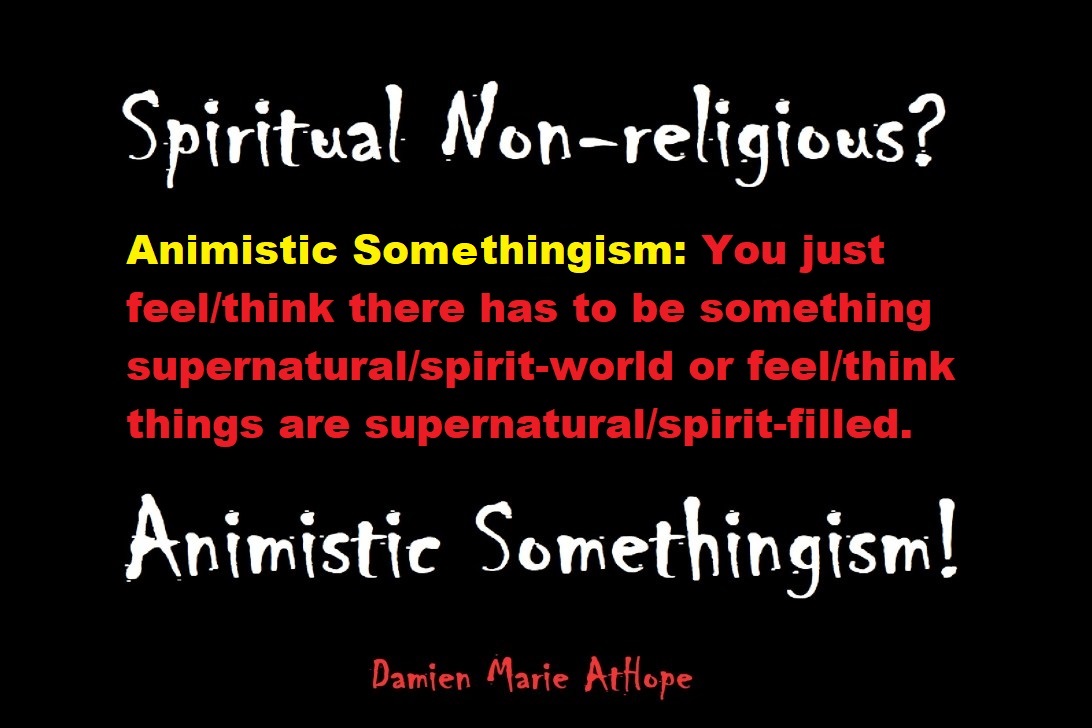
Animism (beginning around 100,000 years ago)
Animism (such as that seen in Africa: 100,000 years ago)
- Animism: an approximately 100,000-year-old belief system?
- Rock crystal stone tools 75,000 Years Ago – (Spain) made by Neanderthals
- Stone Snake of South Africa: “first human worship” 70,000 years ago
- Similarities and differences in Animism and Totemism
- Did Neanderthals Help Inspire Totemism? Because there is Art Dating to Around 65,000 Years Ago in Spain?
- History of Drug Use with Religion or Sacred Rituals possibly 58,000 years ago?
Animism is approximately a 100,000-year-old belief system and believe in spirit-filled life and/or afterlife. If you believe like this, regardless of your faith, you are a hidden animist.
The following is evidence of Animism: 100,000 years ago, in Qafzeh, Israel, the oldest intentional burial had 15 African individuals covered in red ocher was from a group who visited and returned back to Africa. 100,000 to 74,000 years ago, at Border Cave in Africa, an intentional burial of an infant with red ochre and a shell ornament, which may have possible connections to the Africans buried in Qafzeh, Israel. 120,000 years ago, did Neanderthals teach us Primal Religion (Pre-Animism/Animism) as they too used red ocher and burials? ref, ref
It seems to me, it may be the Neanderthals who may have transmitted a “Primal Religion (Animism)” or at least burial and thoughts of an afterlife. The Neanderthals seem to express what could be perceived as a Primal “type of” Religion, which could have come first and is supported in how 250,000 years ago, the Neanderthals used red ochre and 230,000 years ago shows evidence of Neanderthal burial with grave goods and possibly a belief in the afterlife. ref
Do you think it is crazy that the Neanderthals may have transmitted a “Primal Religion”? Consider this, it appears that 175,000 years ago, the Neanderthals built mysterious underground circles with broken off stalactites. This evidence suggests that the Neanderthals were the first humans to intentionally bury the dead, doing so in shallow graves along with stone tools and animal bones. Exemplary sites include Shanidar in Iraq, Kebara Cave in Israel and Krapina in Croatia. Other evidence may suggest the Neanderthals had it transmitted to them by Homo heidelbergensis, 350,000 years ago, by their earliest burial in a shaft pit grave in a cave that had a pink stone axe on the top of 27 Homo heidelbergensis individuals and 250,000 years ago, Homo naledi had an intentional cemetery in South Africa cave. ref, ref, ref, ref, ref
- “120,000–90,000 years ago: Abbassia Pluvial in North Africa—the Sahara desert region is wet and fertile.
- 120,000 to 75,000 years ago: Khoisanid back-migration from Southern Africa to East Africa.
- 82,000 years ago: small perforated seashell beads from Taforalt in Morocco are the earliest evidence of personal adornment found anywhere in the world.
- 75,000 years ago: Toba Volcano supereruption that almost made humanity extinct. Populations could have been lowered to about 3000-1000 people on the Earth.
- 70,000 years ago: earliest example of abstract art or symbolic art from Blombos Cave, South Africa—stones engraved with grid or cross-hatch patterns.
- 70,000 years ago: Recent African origin: separation of sub-Saharan Africans and non-Africans.” ref
Did Neanderthals Help Inspire Totemism?
Because there is Art Dating to Around 65,000 Years Ago in Spain?
“What About Neanderthals and Religion”
Scientists have found the first major evidence that Neanderthals made cave paintings, indicating they may have had an artistic sense similar to our own. A new study led by the University of Southampton and the Max Planck Institute for Evolutionary Anthropology shows that paintings in three caves in Spain were created more than 64,000 years ago – 20,000 years before modern humans arrived in Europe. This means that the Palaeolithic (Ice Age) cave art – including pictures of animals, dots, and geometric signs – must have been made by Neanderthals, a ‘sister’ species to Homo sapiens, and Europe’s sole human inhabitants at the time. It also indicates that they may have had a similar artistic sense, in terms of thinking symbolically, to modern humans. Published today in the journal Science, the study reveals how an international team of scientists used a state-of-the-art technique called uranium-thorium dating to fix the age of the paintings as more than 64,000 years. Until now, cave art has been attributed entirely to modern humans, as claims to a possible Neanderthal origin have been hampered by imprecise dating techniques. However, uranium-thorium dating provides much more reliable results than methods such as radiocarbon dating, which can give false age estimates. Results show that the paintings we dated are, by far, the oldest known cave art in the world, and were created at least 20,000 years before modern humans arrived in Europe from Africa so it is assumed – therefore they may have been painted by Neanderthals. All three caves contain red (ochre) or black paintings of groups of animals, dots, and geometric signs, as well as hand stencils, handprints, and engravings. According to the researchers, creating the art must have involved such sophisticated behavior as the choice of a location, planning of light source and mixing of pigments. There is evidence that Neanderthals in Europe used body ornamentation around 40,000 to 45,000 years ago, but many researchers have suggested this was inspired by modern humans who at the time had just arrived in Europe. Study co-author Paul Pettitt, of Durham University, commented: “Neanderthals created meaningful symbols in meaningful places. The art is not a one-off accident. ref
Neanderthals are our closest extinct relative, but for a long time, they had a reputation for being pretty backward. Early modern humans, for example, made cave paintings. But even though Neanderthals used pigments and decorated themselves with eagle claws and shells, there was no clear proof that they painted caves. One theory goes that Neanderthals developed their rudimentary culture only after early modern humans arrived in Europe some 40,000 to 50,000 years ago. The most recent painting is at least 64,800 years old, according to this technique, and the oldest is more than 66,000 years old. ref
The Neanderthal was the only proven Human of Europe at the time, but was his or her brain up to the job? Or did modern humans reach Europe tens of thousands of years earlier than thought? The ancient art forms are symbolic but not figurative, explain their finders. In Spain, a cave in Maltravieso features hand stencils more than 66,000 years old, Prof. Dirk Hoffmann of the Max Planck Institute for Evolutionary Anthropology and others report in their paper, published Thursday in Science. The La Pasiega Cave in Cantabria features a ladder form composed of red horizontal and vertical lines that were created more than 64,000 years ago, they say. Further supporting the Neanderthal-as-artist theory, a related paper published Thursday in Science Advances reports that dyed and decorated seashells found in a Spanish cave dated to more than 115,000 years ago. Perforated shells found in sediments in Cueva de los Aviones that date to between 115,000 and 120,000 years. There’s no argument that there were Neanderthals in Europe 64,000 years ago. Homo sapiens, on the other hand, was thought to have reached Europe only 45,000 to 40,000 years ago. There is no evidence for modern humans in Iberia before 41,000 years ago, and there is evidence for Neanderthal presence until about 36,000 years ago in southern Spain and Portugal. Neanderthals existed for twice the time modern people have, if not more, and were once the dominant hominin in Europe. While Neanderthals may have etched a crisscross and perhaps carved a flute, look what Homo sapiens achieved, Coolidge says. The Paleolithic record is replete with exquisite works, from cave paintings to carvings done tens of thousands of years ago – such as the Lion Man sculpture found in a German cave and made of mammoth ivory some 38,000 years ago. ref
Neanderthal ritual or religious practice at around 50,000 years old burial in Sima de las Palomas in Murcia, Southeast Spain of a female covered with rocks inturned with a cut off panther paw, suggesting that Neanderthals—much like today’s bear hunters—ceremoniously cut off panther paws and kept them as totemistic trophies. This 50,000-year-old Neanderthal burial ground actually includes the remains of at least three individuals intentionally buried, with each Neanderthal’s arms folded such that the hands were close to the head. Remains of other Neanderthals have been found in this position, suggesting that it held meaning. The remains of six to seven other Neanderthals, including one baby and two juveniles, have also been excavated at the site. The tallest individual appears to have been an adult who stood around 5 feet 1 inch tall. ref, ref
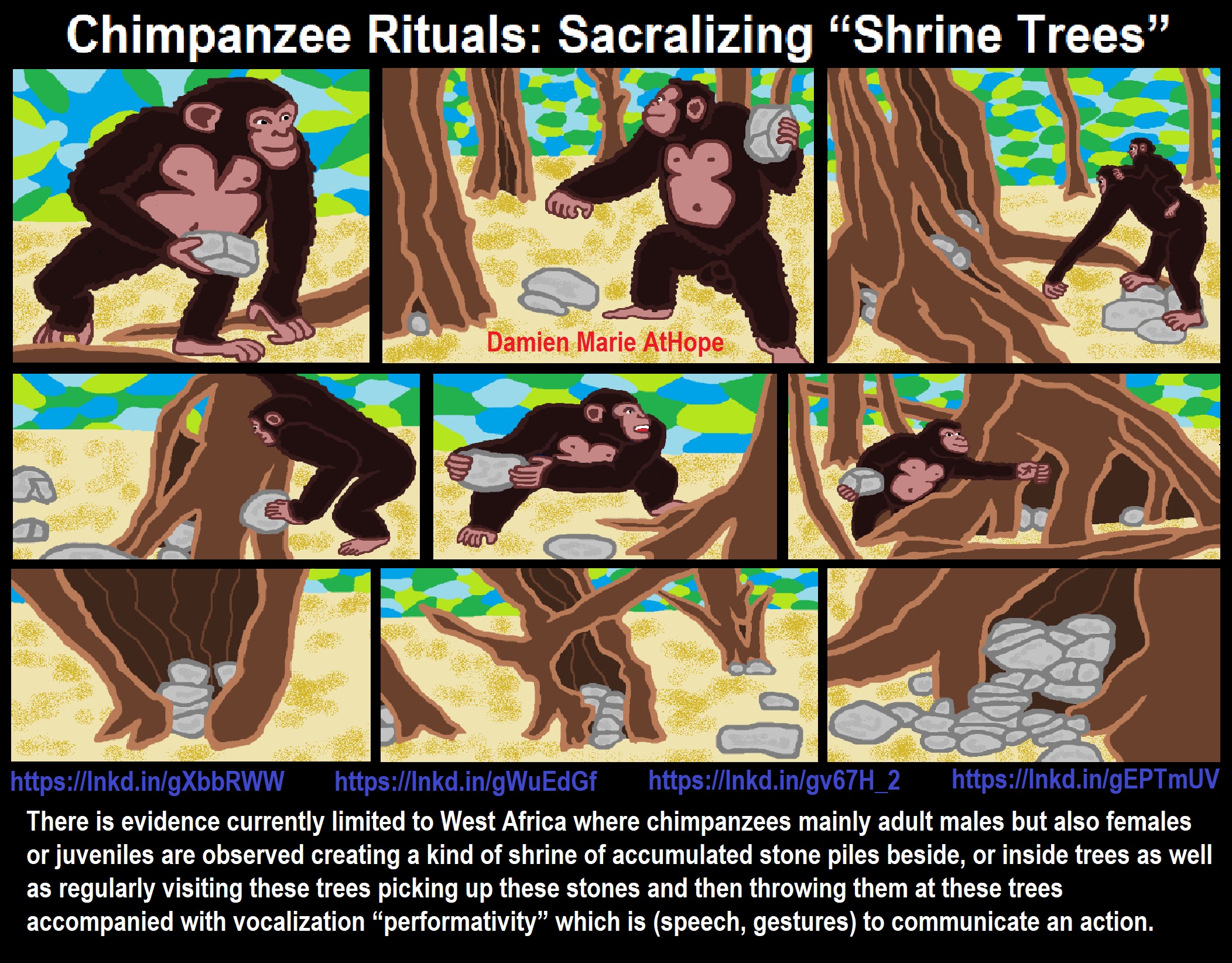
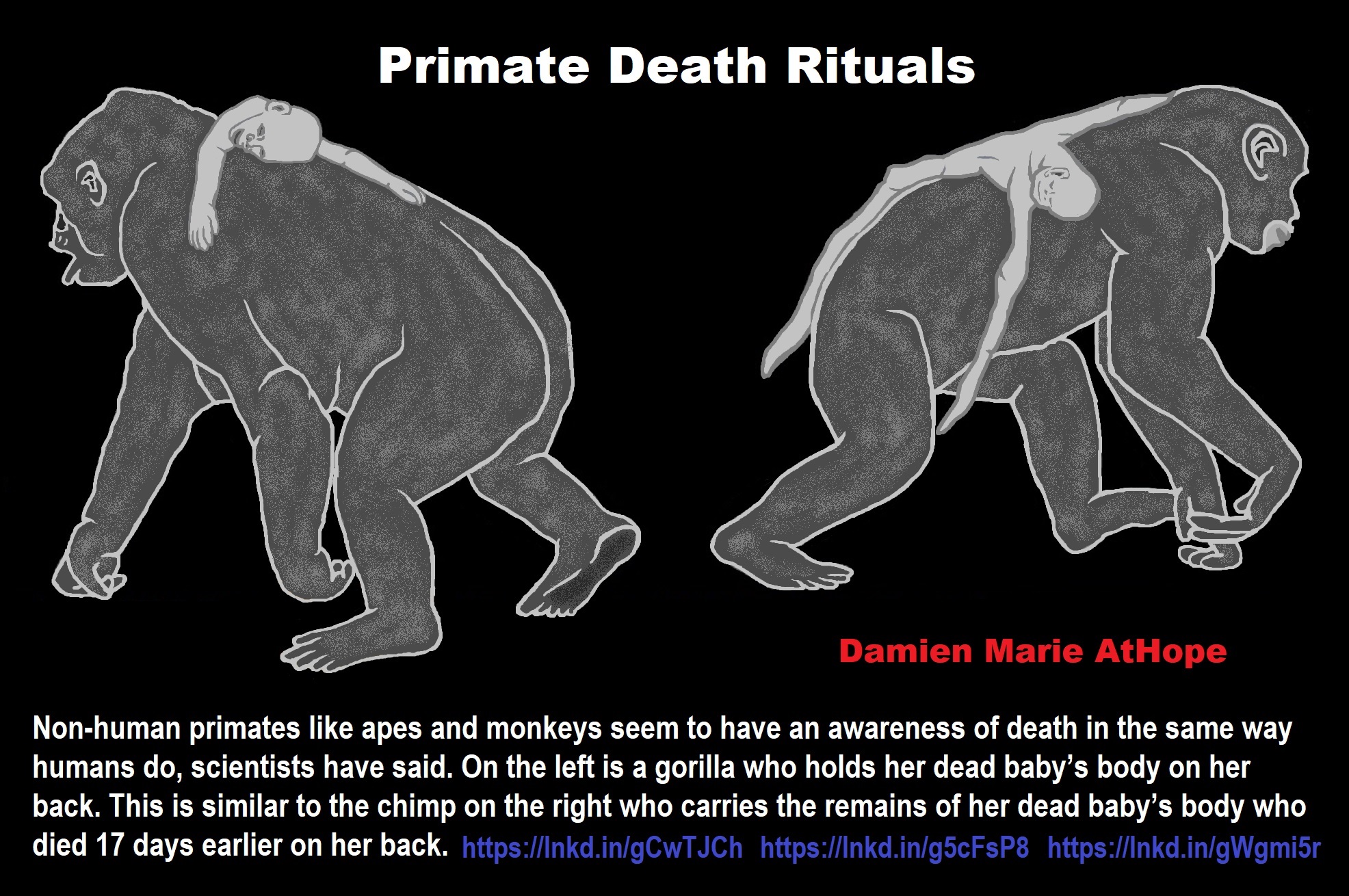

430,000 years ago, Sima de los Huesos, “Pit of Bones”, Atapuerca, Spain, seeming evidence of intentional storing of 28 individuals in a cave chamber pit (a symbolic pseudo-womb?) and a reddish quartzite tool found with the bodies, seems like a kind of ritual funeral offering in this possibly early cemetery. Fossil remains of 430,000-400,000-years-old 28 individuals, 6,500 bone fragments and 500 teeth, in one of several important sections of the Cueva Mayor-Cueva del Silo cave system in north-central Spain. The bone pit is at the bottom of the cave, beneath an abrupt vertical shaft measuring between 6.5-13 feet in diameter, and located about .1/3 of a mile in down a 42.5 ft shaft and it is possibly an expression of mortuary practices. ref
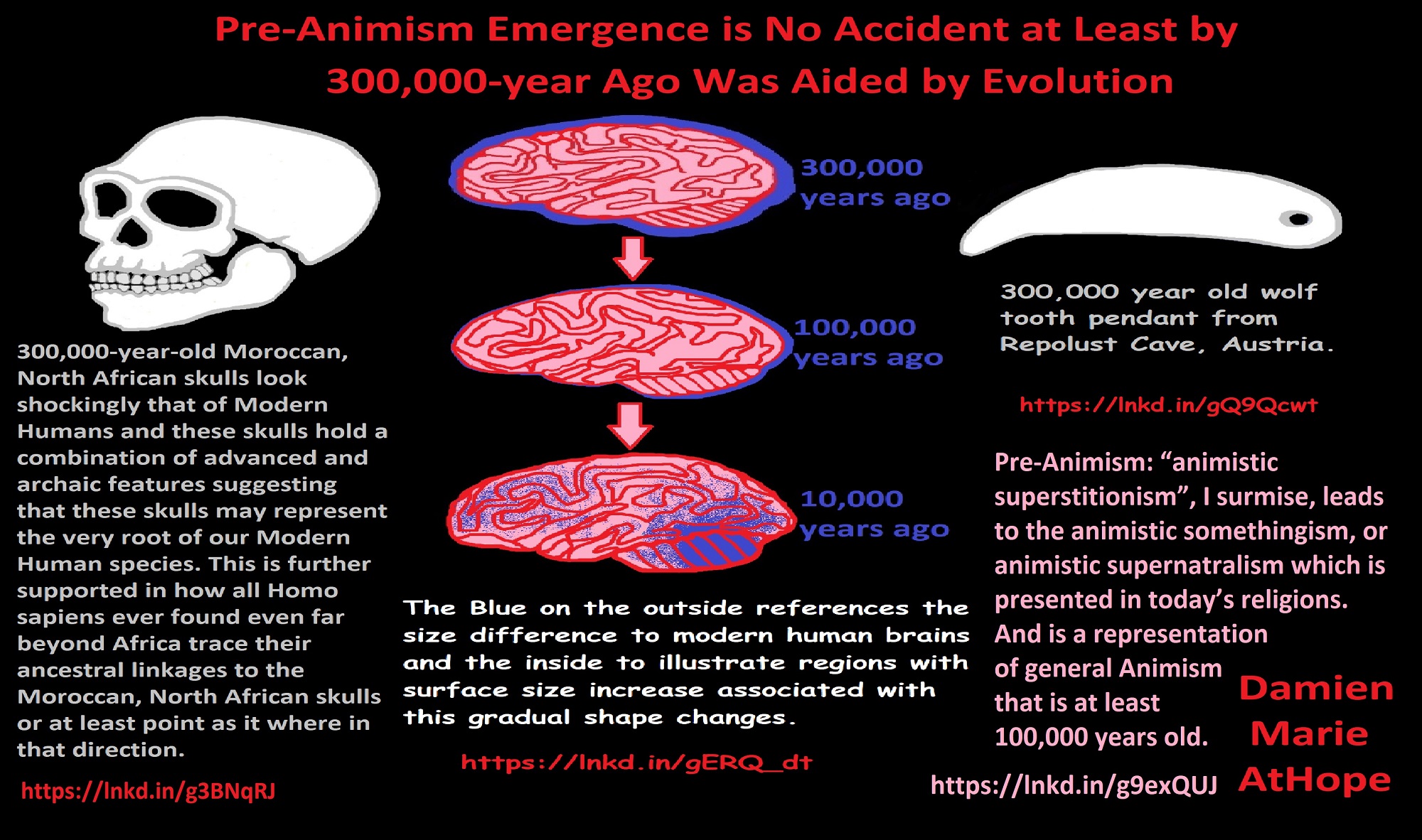
Pre-Animism Emergence is No Accident at Least by 300,000-year Ago Was Aided by Evolution
Pre-Animism: “animistic superstitionism”, I surmise, leads to the animistic somethingism, or animistic supernatralism is presented in today’s religions and is a representation of general Animism that is at least 100,000 years old. ref
The Blue on the outside references the size difference to modern human brains and the inside to illustrate regions with surface size increase associated with this gradual shape changes. ref
300,000-year-old Moroccan, North African skulls look shockingly that of Modern Humans and these skulls hold a combination of advanced and archaic features suggesting that these skulls may represent the very root of our Modern Human species. This is further supported in how all Homo sapiens ever found even far beyond Africa trace their ancestral linkages to the Moroccan, North African skulls or at least point as it where in that direction. And seemingly Homo sapiens could have been living across Africa and sem9ingly engaging in extensive movement, which could have involved exchange both in ideas, technology as well as even genetics. ref
300,000-year-old wolf tooth pendant from Repolust Cave, Austria. ref
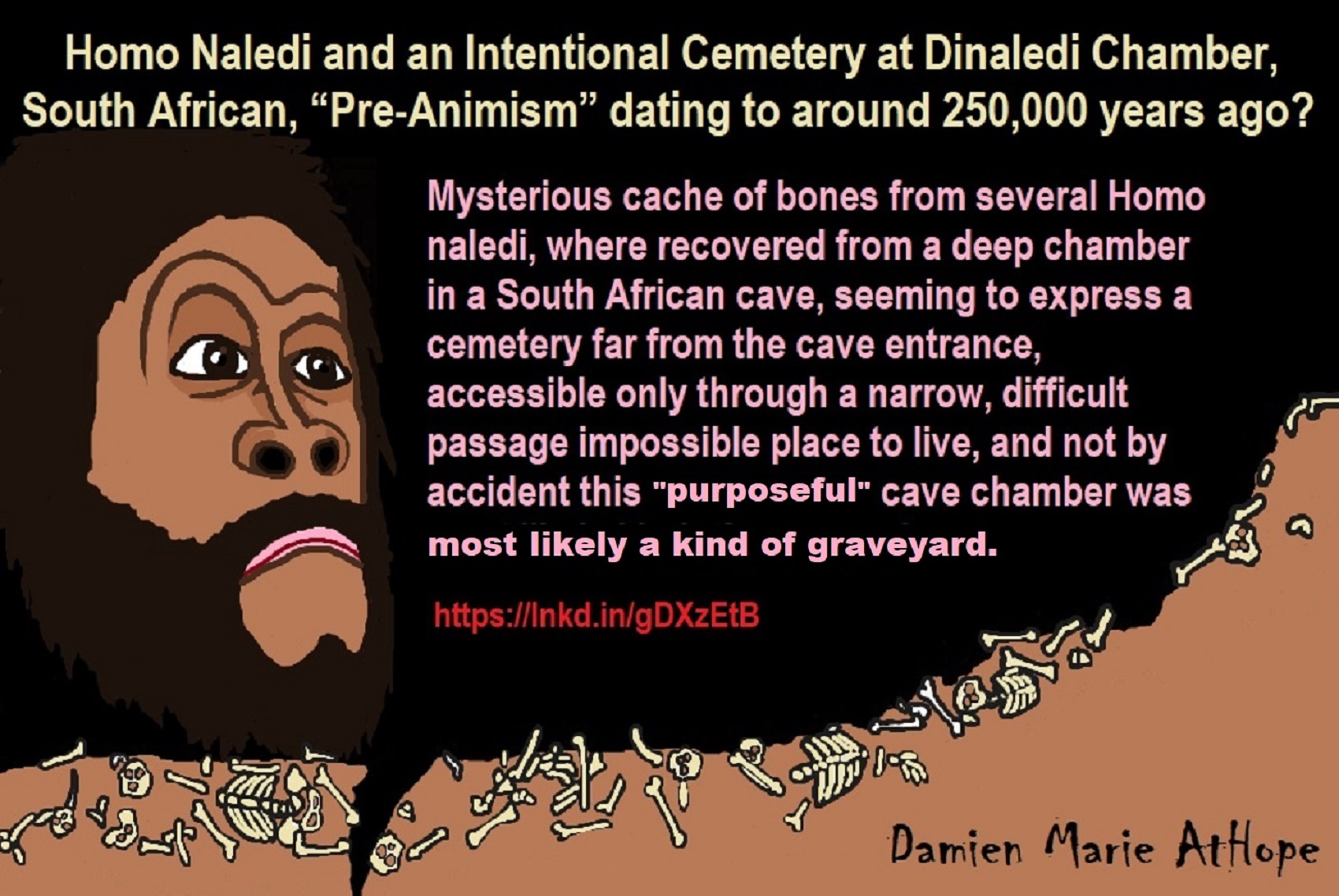
Homo Naledi and an Intentional Cemetery “Pre-Animism” dating to around 250,000 years ago?
To me, it seems likely Homo Naledi did have an intentional cemetery as seen at Dinaledi Chamber, in South Africa, thus “Pre-Animism” dating to around 250,000 years ago. The odd cache of bones from several Homo Naledi were recovered from a deep chamber in a South African cave, seeming to express a cemetery far from the cave entrance, accessible only through a narrow, difficult passage impossible place to live, and not by accident this purposeful cave chamber was most likely kind of graveyard. ref
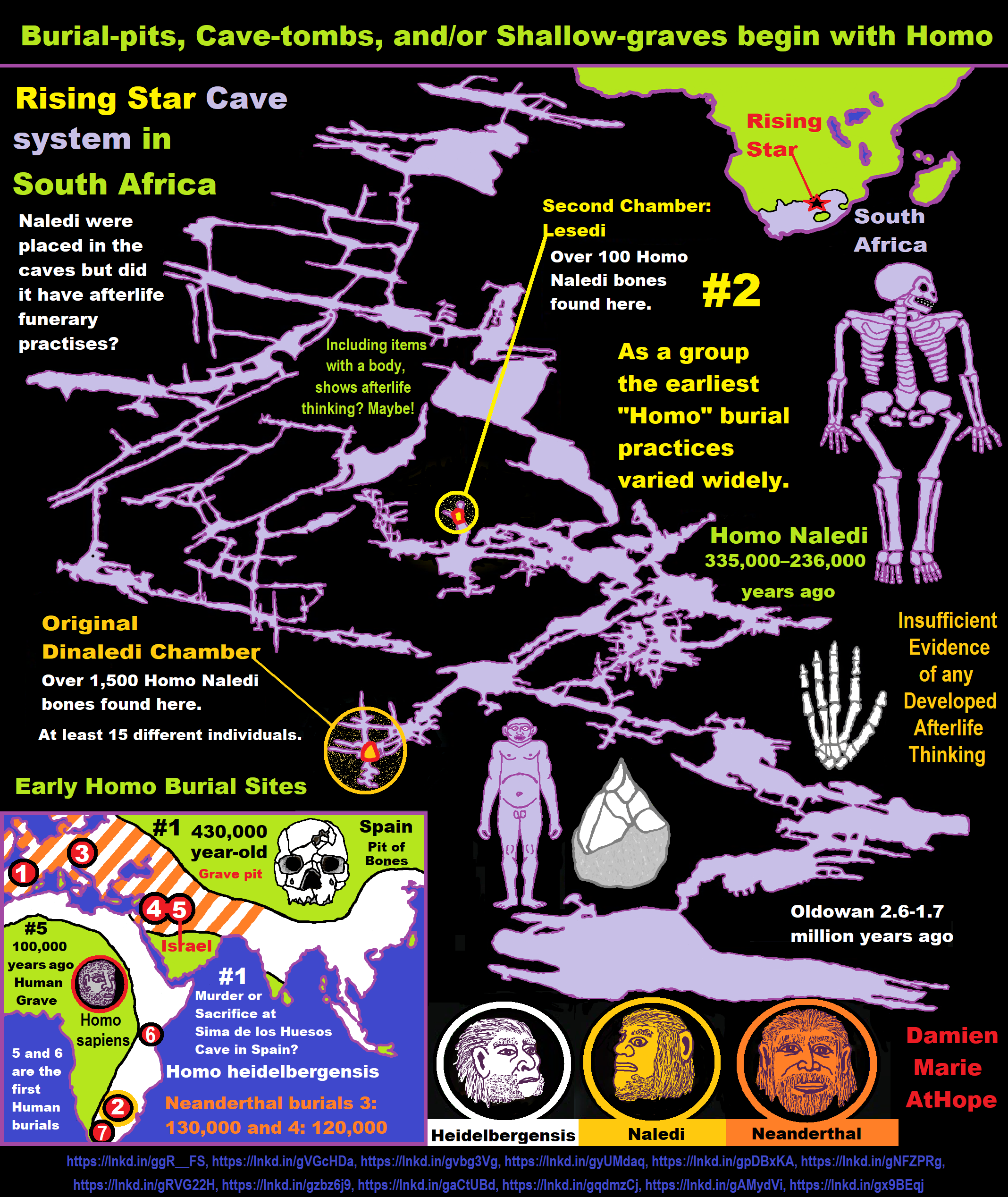
ref, ref, ref, ref, ref, ref, ref, ref, ref, ref, ref, ref
Homo Naledi
“Homo Naledi is a species of archaic human discovered in the Rising Star Cave, Cradle of Humankind, South Africa dating to the Middle Pleistocene 335,000–236,000 years ago. The initial discovery comprises 1,550 specimens, representing 737 different elements, and at least 15 different individuals. Despite this exceptionally high number of specimens, their classification with other Homo remains unclear.” ref
“Along with similarities to contemporary Homo, they share several characteristics with the ancestral Australopithecus and early Homo as well (mosaic anatomy), most notably a small cranial capacity of 465–610 cm3 (28.4–37.2 cu in), compared to 1,270–1,330 cm3 (78–81 cu in) in modern humans. They are estimated to have averaged 143.6 cm (4 ft 9 in) in height and 39.7 kg (88 lb) in weight, yielding a small encephalization quotient of 4.5. Nonetheless, Homo Naledi’s brain anatomy seems to have been similar to contemporary Homo, which could indicate equatable cognitive complexity. The persistence of small-brained humans for so long in the midst of bigger-brained contemporaries revises the previous conception that a larger brain would necessarily lead to an evolutionary advantage, and their mosaic anatomy greatly expands the known range of variation for the genus.” ref
“Homo Naledi anatomy indicates that, though they were capable of long-distance travel with a humanlike stride and gait, they were more arboreal than other Homo, better adapted to climbing and suspensory behavior in trees than endurance running. Tooth anatomy suggests consumption of gritty foods covered in particulates such as dust or dirt. Though they have not been associated with stone tools or any indication of material culture, they appear to have been dextrous enough to produce and handle tools, and likely manufactured Early or Middle Stone Age industries. It has also been controversially postulated that these individuals were given funerary rites, and were carried into and placed in the chamber.” ref
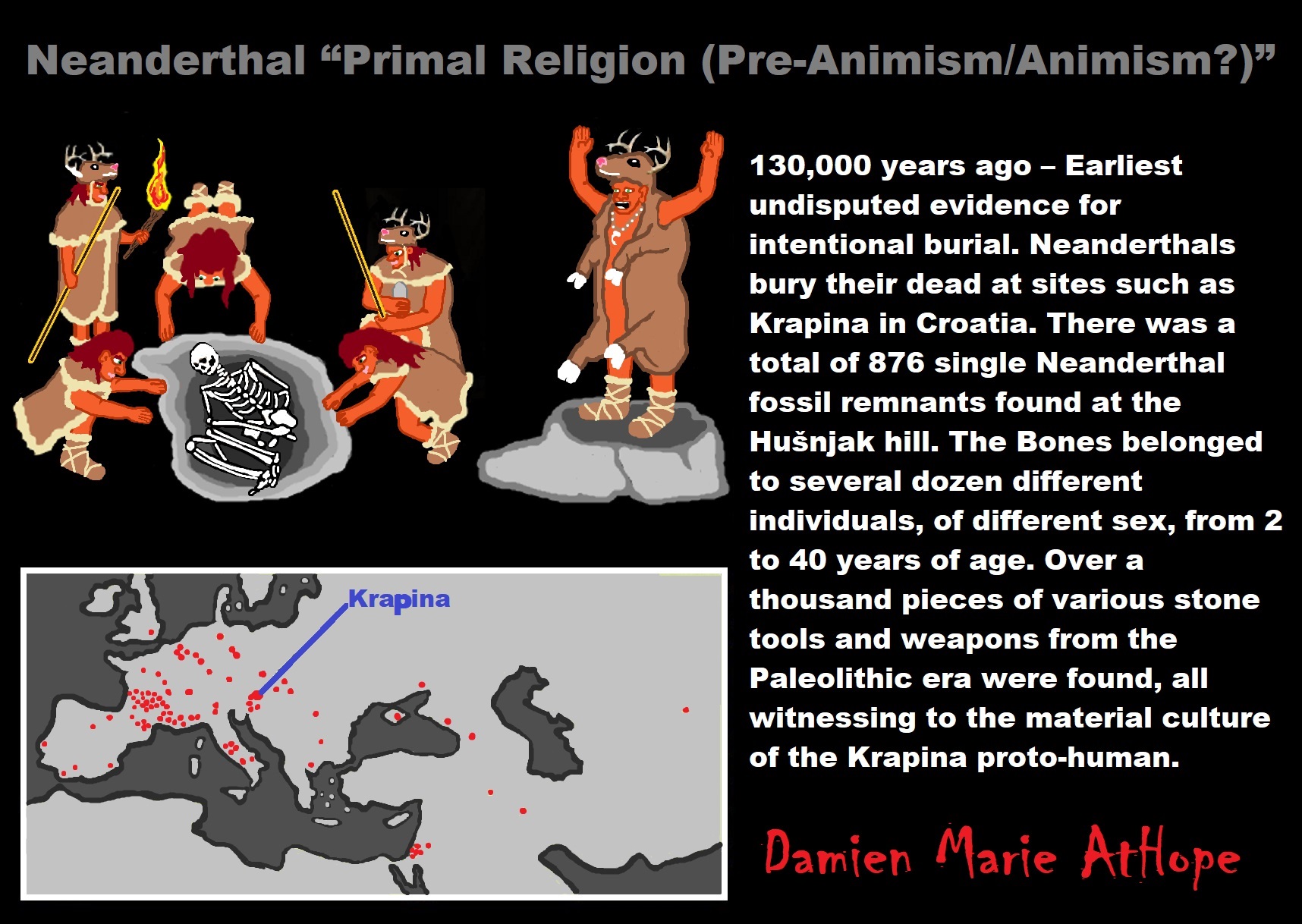
130,000 years ago – Earliest undisputed evidence for intentional burial and it is Neanderthals…
Evidence suggests that the Neanderthals were the first humans to intentionally bury the dead and possibly doing cannibalism which could be evidence of a death ritual, doing so in shallow graves along with stone tools and animal bones. 130,000 years ago – Earliest undisputed evidence for intentional burial. Neanderthals bury their dead at sites such as Krapina in Croatia. There was a total of 876 single Neanderthal fossil remnants found at the Hušnjak hill. The Bones belonged to several dozen different individuals, of different sex, from 2 to 40 years of age. Over a thousand pieces of various stone tools and weapons from the Paleolithic era were found, all witnessing to the material culture of the Krapina proto-human. This rich locality is approximately 130.000 years old.
Numerous fossil remnants of the cave bear, wolf, moose, large deer, warm climate rhinoceros, wild cattle and many other animals were also found. Moreover, there is bird skeletons, with some of the parts modified, are found in association with the Neanderthal bones. Here are some talons and foot bones from the white-tailed eagle. There appears to be cut marks in the talons and foot bones to which they were attached, suggesting that Neanderthals were using the talons and bones as jewelry. This is supported by recent findings of gut “fiber” tied around part of a talon. Here are a foot bone and a talon that have been modified by having grooves cut in them. Neanderthals were largely carnivores, though we know they also used medicinal plants. ref, ref, ref
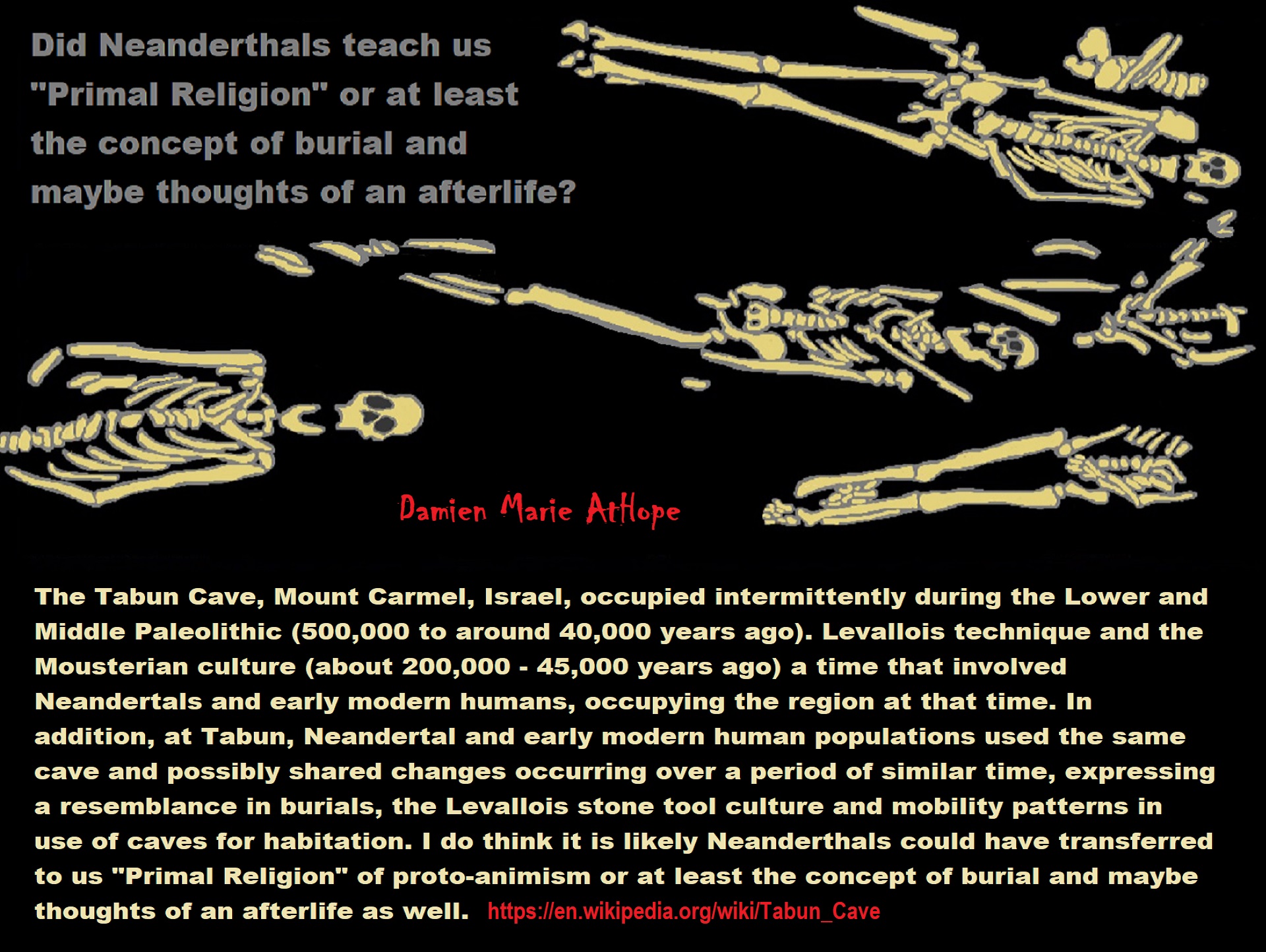
The Tabun Cave, Mount Carmel, Israel, occupied intermittently during the Lower and Middle Paleolithic (500,000 to around 40,000 years ago). Tabun suggests that ancestral humans used fire at the site on a regular basis since about 350,000 years ago and this likely would have shaped our culture and behavior. The material remains from the upper strata of the cave are of Levallois technique and the Mousterian culture (about 200,000 – 45,000 years ago). The Middle Palaeolithic of the southern Levant involved Neandertals and early modern humans, occupying the region at that time. Tabun Cave held fossil remains involved Neandertals and early modern humans but not an absolute chronology of the Levantine MP fossils though could indicates that an enamel fragment from the Tabun C1 could be as old as 143,000 years ago nearly double Tabun BC7. Moreover, a Neanderthal-type female, dated to about 120,000 years ago around the time early modern humans existed there which was between 120,000 – 90,000 years ago and again from 55,000 years ago on. ref, ref, ref, ref
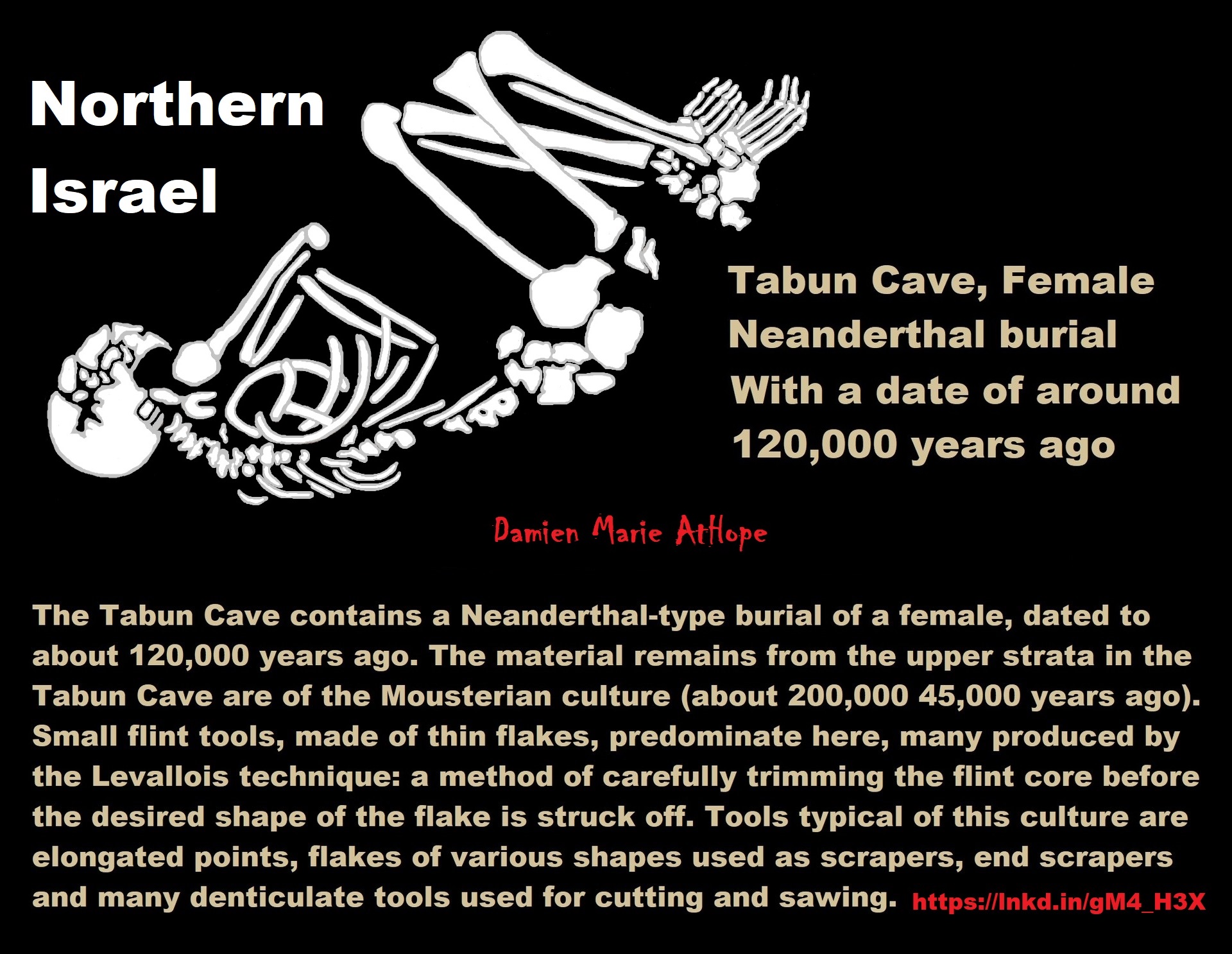
Did Neanderthals teach us “Primal Religion (Pre-Animism/Animism?)” 120,000 Years Ago?
Homo sapiens – is known to have reached the Levant between 120,000 and 90,000 years ago, but that exit from Africa evidently went extinct. Homo sapiens – is known to have reached the Levant between 120,000 and 90,000 years ago, but that exit from Africa evidently went extinct. Tabun Cave Mousterian (stone tool) culture (about 200,000 45,000 years ago). Small flint tools, made of thin flakes, predominate here, many produced by the Levallois technique. ref, ref
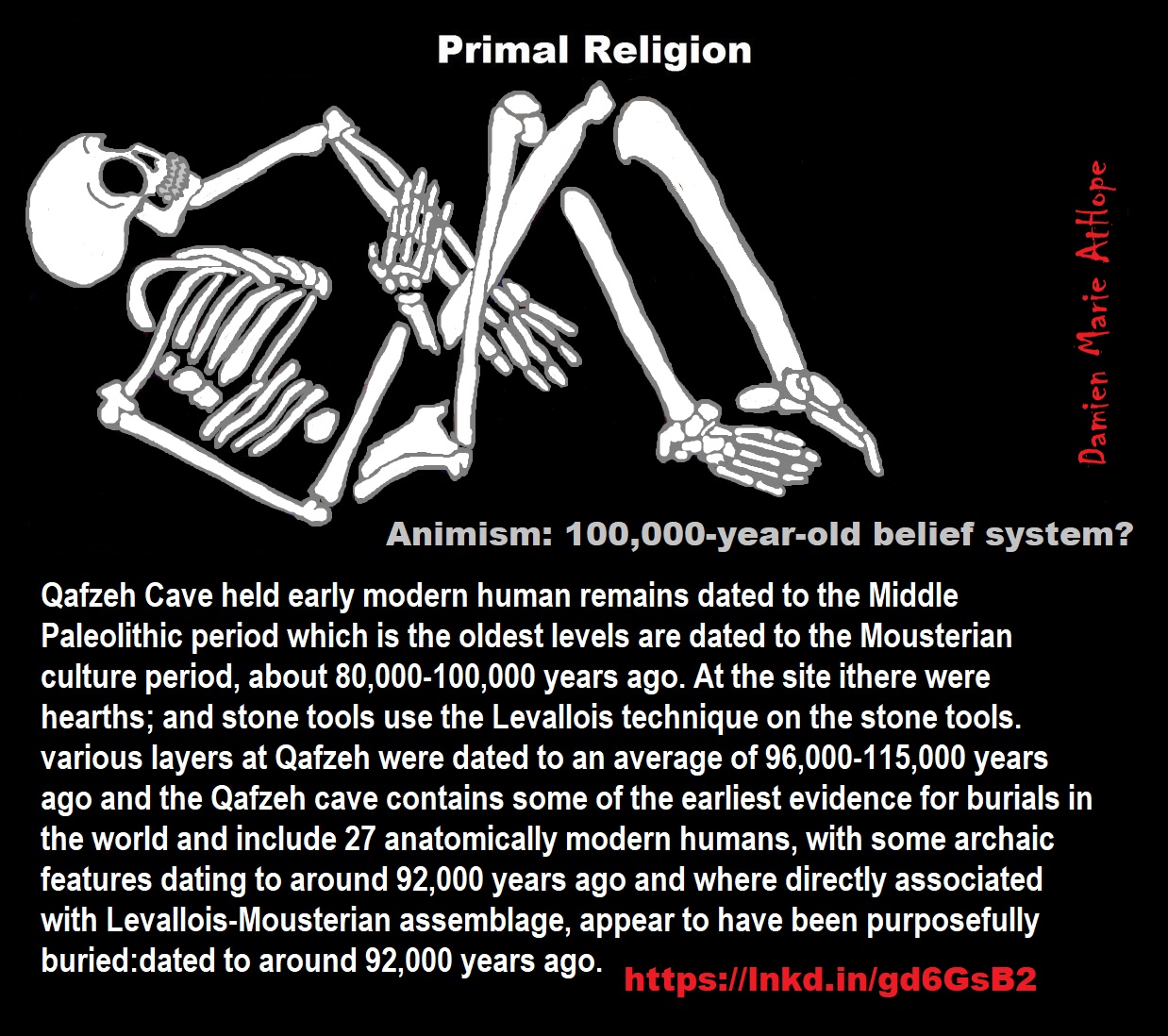
Animism: an approximately 100,000-year-old belief system?
Qafzeh Cave held early modern human remains dating to the Middle Paleolithic period which is the oldest levels are dated to the Mousterian culture period, about 80,000-100,000 years ago. At the site there were hearths; and stone tools use the Levallois technique on the stone tools. various layers at Qafzeh were dated to an average of 96,000-115,000 years ago and the Qafzeh cave contains some of the earliest evidence for burials in the world and included 27 anatomically modern humans, with some archaic features dating to around 92,000 years ago and were directly associated with Levallois-Mousterian assemblage, appear to have been purposefully buried: dated to around 92,000 years ago. The remains are from anatomically modern humans, with some archaic features; they are directly associated with Levallois-Mousterian assemblage. Modern behaviors indicated at the cave include the purposeful burials; the use of ochre for body painting; the presence of marine shells, used as ornamentation, and most interestingly, the survival and eventual ritual interment of a severely brain-damaged child. Moreover, deer antlers at Qafzeh 11 seem to be associated with burials unlike the marine shells which do not seem to be associated with burials, but rather are scattered more or less randomly throughout the site, possibly as a sacred offering, one that sanctifies an area? Or kind of blessing the aria? ref
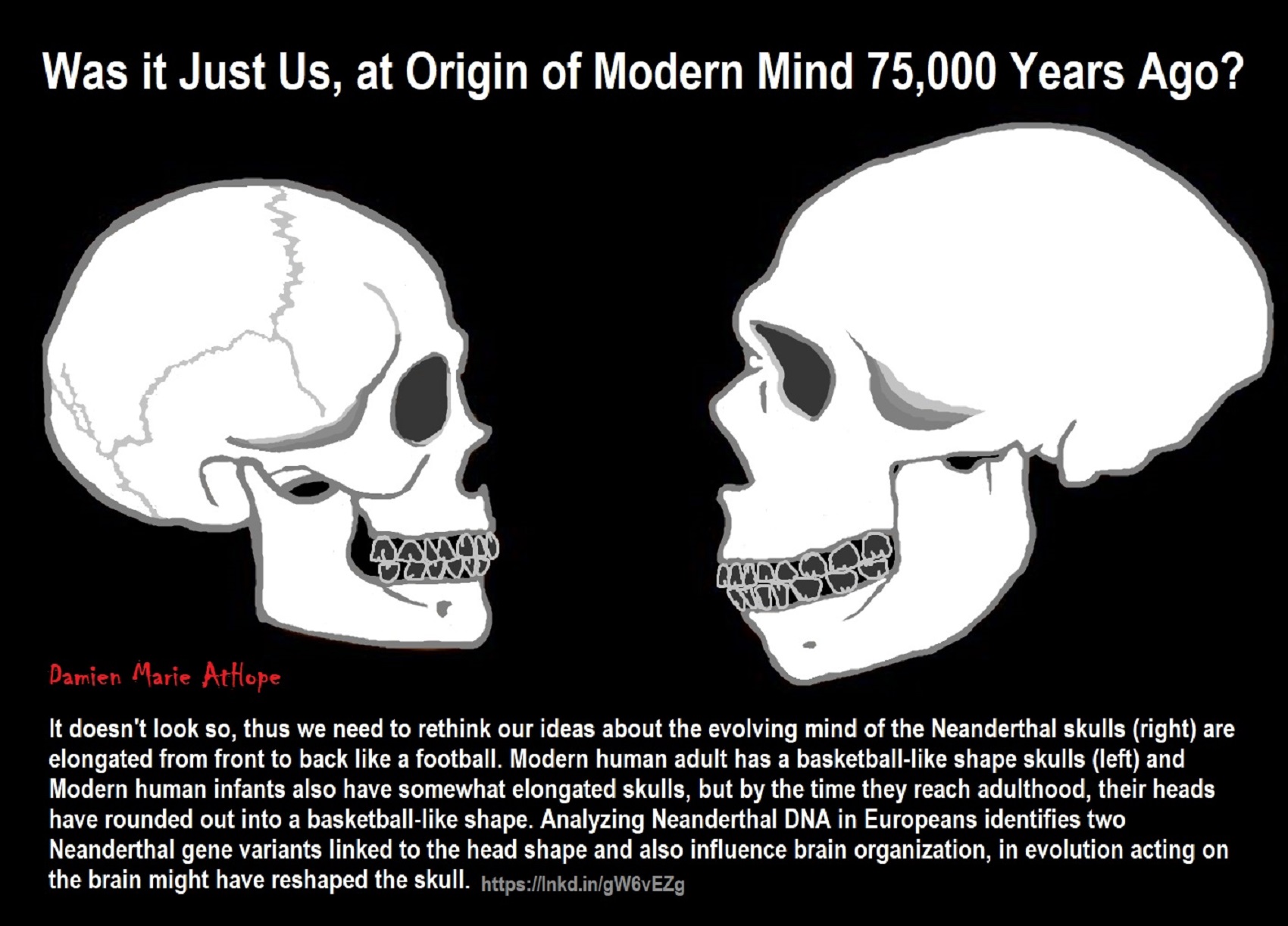
Was it Just Us, at Origin of Modern Mind 75,000 Years Ago?
It doesn’t look so, thus we need to rethink our ideas about the evolving mind of the Neanderthal skulls (right) are elongated from front to back like a football. Modern human adult has a basketball-like shape skulls (left) and Modern human infants also have somewhat elongated skulls, but by the time they reach adulthood, their heads have rounded out into a basketball-like shape. Analyzing Neanderthal DNA in Europeans identifies two Neanderthal gene variants linked to the head shape and also influence brain organization, in evolution acting on the brain might have reshaped the skull. Therefore, the Neanderthal DNA had a direct effect on brain shape and, presumably, brain function in humans today but infants start life with elongated skulls, somewhat like Neanderthals. ref
Evidence shows that Neanderthals had a complex culture although they did not behave in the same ways as the early modern humans who lived at the same time. Neanderthal dead were often buried, although there is no conclusive evidence for full ritualistic behavior, though at some sites, objects have been uncovered that may represent grave goods. ref
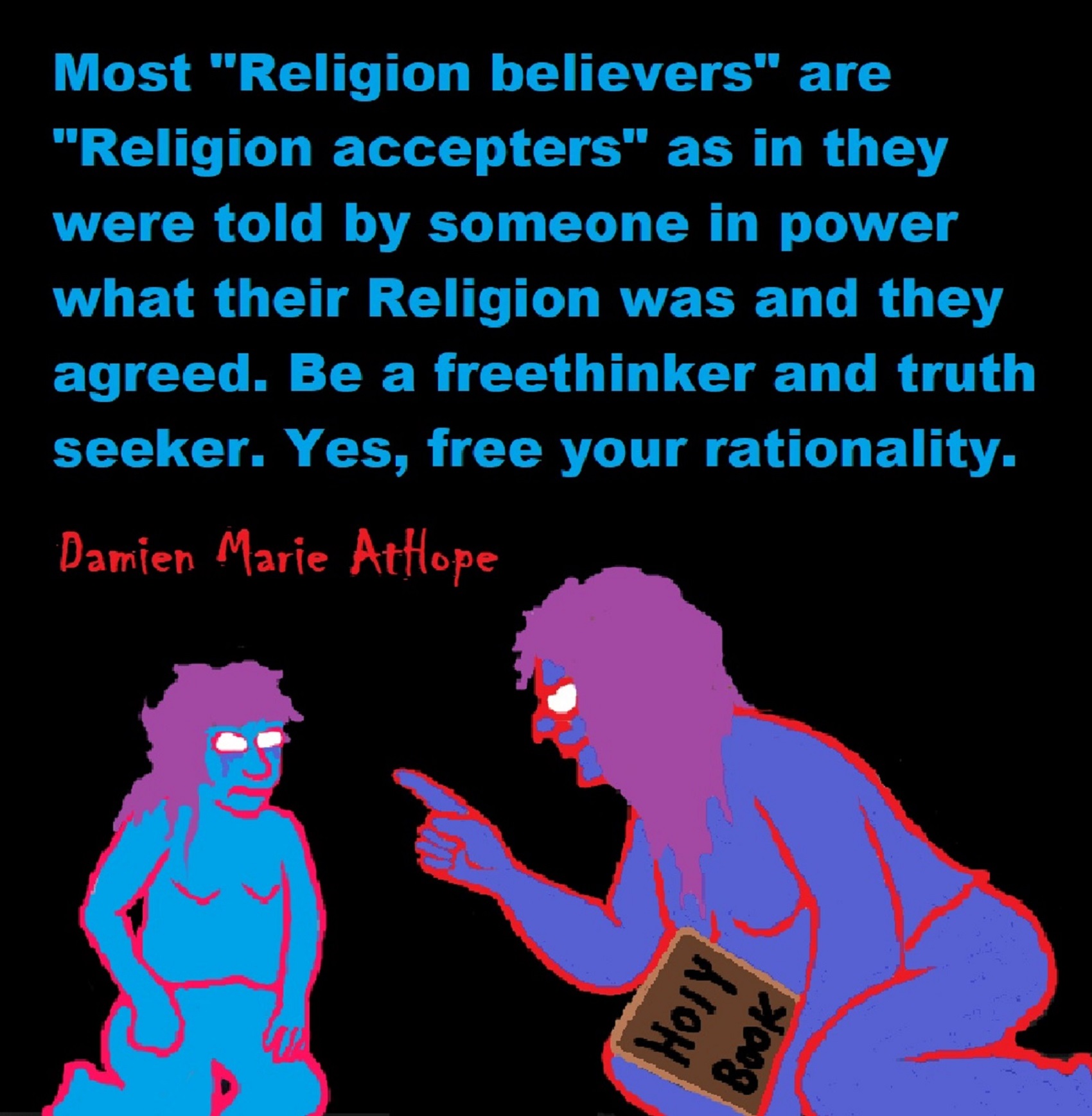

People don’t commonly teach religious history, even that of their own claimed religion. No, rather they teach a limited “pro their religion” history of their religion from a religious perspective favorable to the religion of choice.

Do you truly think “Religious Belief” is only a matter of some personal choice?
Do you not see how coercive one’s world of choice is limited to the obvious hereditary belief, in most religious choices available to the child of religious parents or caregivers? Religion is more commonly like a family, culture, society, etc. available belief that limits the belief choices of the child and that is when “Religious Belief” is not only a matter of some personal choice and when it becomes hereditary faith, not because of the quality of its alleged facts or proposed truths but because everyone else important to the child believes similarly so they do as well simply mimicking authority beliefs handed to them. Because children are raised in religion rather than being presented all possible choices but rather one limited dogmatic brand of “Religious Belief” where children only have a choice of following the belief as instructed, and then personally claim the faith hereditary belief seen in the confirming to the belief they have held themselves all their lives. This is obvious in statements asked and answered by children claiming a faith they barely understand but they do understand that their family believes “this or that” faith, so they feel obligated to believe it too. While I do agree that “Religious Belief” should only be a matter of some personal choice, it rarely is… End Hereditary Religion!

Animism: Respecting the Living World by Graham Harvey
“How have human cultures engaged with and thought about animals, plants, rocks, clouds, and other elements in their natural surroundings? Do animals and other natural objects have a spirit or soul? What is their relationship to humans? In this new study, Graham Harvey explores current and past animistic beliefs and practices of Native Americans, Maori, Aboriginal Australians, and eco-pagans. He considers the varieties of animism found in these cultures as well as their shared desire to live respectfully within larger natural communities. Drawing on his extensive casework, Harvey also considers the linguistic, performative, ecological, and activist implications of these different animisms.” ref

We are like believing machines we vacuum up ideas, like Velcro sticks to almost everything. We accumulate beliefs that we allow to negatively influence our lives, often without realizing it. Our willingness must be to alter skewed beliefs that impend our balance or reason, which allows us to achieve new positive thinking and accurate outcomes.

My thoughts on Religion Evolution with external links for more info:
- (Pre-Animism Africa mainly, but also Europe, and Asia at least 300,000 years ago), (Pre-Animism – Oxford Dictionaries)
- (Animism Africa around 100,000 years ago), (Animism – Britannica.com)
- (Totemism Europe around 50,000 years ago), (Totemism – Anthropology)
- (Shamanism Siberia around 30,000 years ago), (Shamanism – Britannica.com)
- (Paganism Turkey around 12,000 years ago), (Paganism – BBC Religion)
- (Progressed Organized Religion “Institutional Religion” Egypt around 5,000 years ago), (Ancient Egyptian Religion – Britannica.com)
- (CURRENT “World” RELIGIONS after 4,000 years ago) (Origin of Major Religions – Sacred Texts)
- (Early Atheistic Doubting at least by 2,600 years ago) (History of Atheism – Wikipedia)
“Religion is an Evolved Product” and Yes, Religion is Like Fear Given Wings…
Atheists talk about gods and religions for the same reason doctors talk about cancer, they are looking for a cure, or a firefighter talks about fires because they burn people and they care to stop them. We atheists too often feel a need to help the victims of mental slavery, held in the bondage that is the false beliefs of gods and the conspiracy theories of reality found in religions.
Understanding Religion Evolution:
- Pre-Animism (at least 300,000 years ago)
- Animism (Africa: 100,000 years ago)
- Totemism (Europe: 50,000 years ago)
- Shamanism (Siberia: 30,000 years ago)
- Paganism (Turkey: 12,000 years ago)
- Progressed organized religion (Egypt: 5,000 years ago), (Egypt, the First Dynasty 5,150 years ago)
- CURRENT “World” RELIGIONS (after 4,000 years ago)
- Early Atheistic Doubting (at least by 2,600 years ago)
“An Archaeological/Anthropological Understanding of Religion Evolution”
It seems ancient peoples had to survived amazing threats in a “dangerous universe (by superstition perceived as good and evil),” and human “immorality or imperfection of the soul” which was thought to affect the still living, leading to ancestor worship. This ancestor worship presumably led to the belief in supernatural beings, and then some of these were turned into the belief in gods. This feeble myth called gods were just a human conceived “made from nothing into something over and over, changing, again and again, taking on more as they evolve, all the while they are thought to be special,” but it is just supernatural animistic spirit-belief perceived as sacred.
Quick Evolution of Religion?
Pre-Animism (at least 300,000 years ago) pre-religion is a beginning that evolves into later Animism. So, Religion as we think of it, to me, all starts in a general way with Animism (Africa: 100,000 years ago) (theoretical belief in supernatural powers/spirits), then this is physically expressed in or with Totemism (Europe: 50,000 years ago) (theoretical belief in mythical relationship with powers/spirits through a totem item), which then enlists a full-time specific person to do this worship and believed interacting Shamanism (Siberia/Russia: 30,000 years ago) (theoretical belief in access and influence with spirits through ritual), and then there is the further employment of myths and gods added to all the above giving you Paganism (Turkey: 12,000 years ago) (often a lot more nature-based than most current top world religions, thus hinting to their close link to more ancient religious thinking it stems from). My hypothesis is expressed with an explanation of the building of a theatrical house (modern religions development). Progressed organized religion (Egypt: 5,000 years ago) with CURRENT “World” RELIGIONS (after 4,000 years ago).
Historically, in large city-state societies (such as Egypt or Iraq) starting around 5,000 years ago culminated to make religion something kind of new, a sociocultural-governmental-religious monarchy, where all or at least many of the people of such large city-state societies seem familiar with and committed to the existence of “religion” as the integrated life identity package of control dynamics with a fixed closed magical doctrine, but this juggernaut integrated religion identity package of Dogmatic-Propaganda certainly did not exist or if developed to an extent it was highly limited in most smaller prehistoric societies as they seem to lack most of the strong control dynamics with a fixed closed magical doctrine (magical beliefs could be at times be added or removed). Many people just want to see developed religious dynamics everywhere even if it is not. Instead, all that is found is largely fragments until the domestication of religion.
Religions, as we think of them today, are a new fad, even if they go back to around 6,000 years in the timeline of human existence, this amounts to almost nothing when seen in the long slow evolution of religion at least around 70,000 years ago with one of the oldest ritual worship. Stone Snake of South Africa: “first human worship” 70,000 years ago. This message of how religion and gods among them are clearly a man-made thing that was developed slowly as it was invented and then implemented peace by peace discrediting them all. Which seems to be a simple point some are just not grasping how devastating to any claims of truth when we can see the lie clearly in the archeological sites.
I wish people fought as hard for the actual values as they fight for the group/clan names political or otherwise they think support values. Every amount spent on war is theft to children in need of food or the homeless kept from shelter.
Here are several of my blog posts on history:
- To Find Truth You Must First Look
- (Magdalenian/Iberomaurusian) Connections to the First Paganists of the early Neolithic Near East Dating from around 17,000 to 12,000 Years Ago
- Natufians: an Ancient People at the Origins of Agriculture and Sedentary Life
- Possible Clan Leader/Special “MALE” Ancestor Totem Poles At Least 13,500 years ago?
- Jewish People with DNA at least 13,200 years old, Judaism, and the Origins of Some of its Ideas
- Baltic Reindeer Hunters: Swiderian, Lyngby, Ahrensburgian, and Krasnosillya cultures 12,020 to 11,020 years ago are evidence of powerful migratory waves during the last 13,000 years and a genetic link to Saami and the Finno-Ugric peoples.
- The Rise of Inequality: patriarchy and state hierarchy inequality
- Fertile Crescent 12,500 – 9,500 Years Ago: fertility and death cult belief system?
- 12,400 – 11,700 Years Ago – Kortik Tepe (Turkey) Pre/early-Agriculture Cultic Ritualism
- Ritualistic Bird Symbolism at Gobekli Tepe and its “Ancestor Cult”
- Male-Homosexual (female-like) / Trans-woman (female) Seated Figurine from Gobekli Tepe
- Could a 12,000-year-old Bull Geoglyph at Göbekli Tepe relate to older Bull and Female Art 25,000 years ago and Later Goddess and the Bull cults like Catal Huyuk?
- Sedentism and the Creation of goddesses around 12,000 years ago as well as male gods after 7,000 years ago.
- Alcohol, where Agriculture and Religion Become one? Such as Gobekli Tepe’s Ritualistic use of Grain as Food and Ritual Drink
- Neolithic Ritual Sites with T-Pillars and other Cultic Pillars
- Paganism: Goddesses around 12,000 years ago then Male Gods after 7,000 years ago
- First Patriarchy: Split of Women’s Status around 12,000 years ago & First Hierarchy: fall of Women’s Status around 5,000 years ago.
- Natufians: an Ancient People at the Origins of Agriculture and Sedentary Life
- J DNA and the Spread of Agricultural Religion (paganism)
- Paganism: an approximately 12,000-year-old belief system
- Paganism 12,000 years old: related to “Anarchism and Socialism” (Pre-Capitalism)
- Shaman burial in Israel 12,000 years ago and the Shamanism Phenomena
- Need to Mythicized: gods and goddesses
- 12,000 – 7,000 Years Ago – Paleo-Indian Culture (The Americas)
- 12,000 – 2,000 Years Ago – Indigenous-Scandinavians (Nordic)
- Norse did not wear helmets with horns?
- Pre-Pottery Neolithic Skull Cult around 11,500 to 8,400 Years Ago?
- 10,400 – 10,100 Years Ago, in Turkey the Nevail Cori Religious Settlement
- 9,000-6,500 Years Old Submerged Pre-Pottery/Pottery Neolithic Ritual Settlements off Israel’s Coast
- Catal Huyuk “first religious designed city” around 9,500 to 7,700 years ago (Turkey)
- Cultic Hunting at Catal Huyuk “first religious designed city”
- Special Items and Art as well as Special Elite Burials at Catal Huyuk
- New Rituals and Violence with the appearance of Pottery and People?
- Haplogroup N and its related Uralic Languages and Cultures
- Ainu people, Sámi people, Native Americans, the Ancient North Eurasians, and Paganistic-Shamanism with Totemism
- Ideas, Technology and People from Turkey, Europe, to China and Back again 9,000 to 5,000 years ago?
- First Pottery of Europe and the Related Cultures
- 9,000 years old Neolithic Artifacts Judean Desert and Hills Israel
- 9,000-7,000 years-old Sex and Death Rituals: Cult Sites in Israel, Jordan, and the Sinai
- 9,000-8500 year old Horned Female shaman Bad Dürrenberg Germany
- Neolithic Jewelry and the Spread of Farming in Europe Emerging out of West Turkey
- 8,600-year-old Tortoise Shells in Neolithic graves in central China have Early Writing and Shamanism
- Swing of the Mace: the rise of Elite, Forced Authority, and Inequality begin to Emerge 8,500 years ago?
- Migrations and Changing Europeans Beginning around 8,000 Years Ago
- My “Steppe-Anatolian-Kurgan hypothesis” 8,000/7,000 years ago
- Around 8,000-year-old Shared Idea of the Mistress of Animals, “Ritual” Motif
- Pre-Columbian Red-Paint (red ochre) Maritime Archaic Culture 8,000-3,000 years ago
- 7,522-6,522 years ago Linear Pottery culture which I think relates to Arcane Capitalism’s origins
- Arcane Capitalism: Primitive socialism, Primitive capital, Private ownership, Means of production, Market capitalism, Class discrimination, and Petite bourgeoisie (smaller capitalists)
- 7,500-4,750 years old Ritualistic Cucuteni-Trypillian culture of Moldova, Romania, and Ukraine
- Roots of a changing early society 7,200-6,700 years ago Jordan and Israel
- Agriculture religion (Paganism) with farming reached Britain between about 7,000 to 6,500 or so years ago and seemingly expressed in things like Western Europe’s Long Barrows
- My Thoughts on Possible Migrations of “R” DNA and Proto-Indo-European?
- “Millet” Spreading from China 7,022 years ago to Europe and related Language may have Spread with it leading to Proto-Indo-European
- Proto-Indo-European (PIE), ancestor of Indo-European languages: DNA, Society, Language, and Mythology
- The Dnieper–Donets culture and Asian varieties of Millet from China to the Black Sea region of Europe by 7,022 years ago
- Kurgan 6,000 years ago/dolmens 7,000 years ago: funeral, ritual, and other?
- 7,020 to 6,020-year-old Proto-Indo-European Homeland of Urheimat or proposed home of their Language and Religion
- Ancient Megaliths: Kurgan, Ziggurat, Pyramid, Menhir, Trilithon, Dolman, Kromlech, and Kromlech of Trilithons
- The Mytheme of Ancient North Eurasian Sacred-Dog belief and similar motifs are found in Indo-European, Native American, and Siberian comparative mythology
- Elite Power Accumulation: Ancient Trade, Tokens, Writing, Wealth, Merchants, and Priest-Kings
- Sacred Mounds, Mountains, Kurgans, and Pyramids may hold deep connections?
- Between 7,000-5,000 Years ago, rise of unequal hierarchy elite, leading to a “birth of the State” or worship of power, strong new sexism, oppression of non-elites, and the fall of Women’s equal status
- Paganism 7,000-5,000 years old: related to “Anarchism and Socialism” (Capitalism) (World War 0) Elite & their slaves
- Hell and Underworld mythologies starting maybe as far back as 7,000 to 5,000 years ago with the Proto-Indo-Europeans?
- The First Expression of the Male God around 7,000 years ago?
- White (light complexion skin) Bigotry and Sexism started 7,000 years ago?
- Around 7,000-year-old Shared Idea of the Divine Bird (Tutelary and/or Trickster spirit/deity), “Ritual” Motif
- Nekhbet an Ancient Egyptian Vulture Goddess and Tutelary Deity
- 6,720 to 4,920 years old Ritualistic Hongshan Culture of Inner Mongolia with 5,000-year-old Pyramid Mounds and Temples
- First proto-king in the Balkans, Varna culture around 6,500 years ago?
- 6,500–5,800 years ago in Israel Late Chalcolithic (Copper Age) Period in the Southern Levant Seems to Express Northern Levant Migrations, Cultural and Religious Transfer
- KING OF BEASTS: Master of Animals “Ritual” Motif, around 6,000 years old or older…
- Around 6000-year-old Shared Idea of the Solid Wheel & the Spoked Wheel-Shaped Ritual Motif
- “The Ghassulian Star,” a mysterious 6,000-year-old mural from Jordan; a Proto-Star of Ishtar, Star of Inanna or Star of Venus?
- Religious/Ritual Ideas, including goddesses and gods as well as ritual mounds or pyramids from Northeastern Asia at least 6,000 years old, seemingly filtering to Iran, Iraq, the Mediterranean, Europe, Egypt, and the Americas?
- Maykop (5,720–5,020 years ago) Caucasus region Bronze Age culture-related to Copper Age farmers from the south, influenced by the Ubaid period and Leyla-Tepe culture, as well as influencing the Kura-Araxes culture
- 5-600-year-old Tomb, Mummy, and First Bearded Male Figurine in a Grave
- Kura-Araxes Cultural 5,520 to 4,470 years old DNA traces to the Canaanites, Arabs, and Jews
- Minoan/Cretan (Keftiu) Civilization and Religion around 5,520 to 3,120 years ago
- Evolution Of Science at least by 5,500 years ago
- 5,500 Years old birth of the State, the rise of Hierarchy, and the fall of Women’s status
- “Jiroft culture” 5,100 – 4,200 years ago and the History of Iran
- Stonehenge: Paganistic Burial and Astrological Ritual Complex, England (5,100-3,600 years ago)
- Around 5,000-year-old Shared Idea of the “Tree of Life” Ritual Motif
- Complex rituals for elite, seen from China to Egypt, at least by 5,000 years ago
- Around 5,000 years ago: “Birth of the State” where Religion gets Military Power and Influence
- The Center of the World “Axis Mundi” and/or “Sacred Mountains” Mythology Could Relate to the Altai Mountains, Heart of the Steppe
- Progressed organized religion starts, an approximately 5,000-year-old belief system
- China’s Civilization between 5,000-3,000 years ago, was a time of war and class struggle, violent transition from free clans to a Slave or Elite society
- Origin of Logics is Naturalistic Observation at least by around 5,000 years ago.
- Paganism 5,000 years old: progressed organized religion and the state: related to “Anarchism and Socialism” (Kings and the Rise of the State)
- Ziggurats (multi-platform temples: 4,900 years old) to Pyramids (multi-platform tombs: 4,700 years old)
- Did a 4,520–4,420-year-old Volcano In Turkey Inspire the Bible God?
- Finland’s Horned Shaman and Pre-Horned-God at least 4,500 years ago?
- 4,000-year-Old Dolmens in Israel: A Connected Dolmen Religious Phenomenon?
- Creation myths: From chaos, Ex nihilo, Earth-diver, Emergence, World egg, and World parent
- Bronze Age “Ritual” connections of the Bell Beaker culture with the Corded Ware/Single Grave culture, which were related to the Yamnaya culture and Proto-Indo-European Languages/Religions
- Low Gods (Earth/ Tutelary deity), High Gods (Sky/Supreme deity), and Moralistic Gods (Deity enforcement/divine order)
- The exchange of people, ideas, and material-culture including, to me, the new god (Sky Father) and goddess (Earth Mother) religion between the Cucuteni-Trypillians and others which is then spread far and wide
- Koryaks: Indigenous People of the Russian Far East and Big Raven myths also found in Tlingit, Haida, Tsimshian, and other Indigenous People of North America
- 42 Principles Of Maat (Egyptian Goddess of the justice) around 4,400 years ago, 2000 Years Before Ten Commandments
- “Happy Easter” Well Happy Eostre/Ishter
- 4,320-3,820 years old “Shimao” (North China) site with Totemistic-Shamanistic Paganism and a Stepped Pyramid
- 4,250 to 3,400 Year old Stonehenge from Russia: Arkaim?
- 4,100-year-old beaker with medicinal & flowering plants in a grave of a woman in Scotland
- Early European Farmer ancestry, Kelif el Boroud people with the Cardial Ware culture, and the Bell Beaker culture Paganists too, spread into North Africa, then to the Canary Islands off West Africa
- Flood Accounts: Gilgamesh epic (4,100 years ago) Noah in Genesis (2,600 years ago)
- Paganism 4,000 years old: related to “Anarchism and Socialism” (First Moralistic gods, then the Origin time of Monotheism)
- When was the beginning: TIMELINE OF CURRENT RELIGIONS, which start around 4,000 years ago.
- Early Religions Thought to Express Proto-Monotheistic Systems around 4,000 years ago
- Kultepe? An archaeological site with a 4,000 years old women’s rights document.
- Single God Religions (Monotheism) = “Man-o-theism” started around 4,000 years ago with the Great Sky Spirit/God Tiān (天)?
- Confucianism’s Tiān (Shangdi god 4,000 years old): Supernaturalism, Pantheism or Theism?
- Yes, Your Male God is Ridiculous
- Mythology, a Lunar Deity is a Goddess or God of the Moon
- Sacred Land, Hills, and Mountains: Sami Mythology (Paganistic Shamanism)
- Horse Worship/Sacrifice: mythical union of Ruling Elite/Kingship and the Horse
- The Amorite/Amurru people’s God Amurru “Lord of the Steppe”, relates to the Origins of the Bible God?
- Bronze Age Exotic Trade Routes Spread Quite Far as well as Spread Religious Ideas with Them
- Sami and the Northern Indigenous Peoples Landscape, Language, and its Connection to Religion
- Prototype of Ancient Analemmatic Sundials around 3,900-3,150 years ago and a Possible Solar Connection to gods?
- Judaism is around 3,450 or 3,250 years old. (“Paleo-Hebrew” 3,000 years ago and Torah 2,500 years ago)
- The Weakening of Ancient Trade and the Strengthening of Religions around 3000 years ago?
- Are you aware that there are religions that worship women gods, explain now religion tears women down?
- Animistic, Totemistic, and Paganistic Superstition Origins of bible god and the bible’s Religion.
- Myths and Folklore: “Trickster gods and goddesses”
- Jews, Judaism, and the Origins of Some of its Ideas
- An Old Branch of Religion Still Giving Fruit: Sacred Trees
- Dating the BIBLE: naming names and telling times (written less than 3,000 years ago, provable to 2,200 years ago)
- Did a Volcano Inspire the bible god?
- Dené–Yeniseian language, Old Copper Complex, and Pre-Columbian Mound Builders?
- No “dinosaurs and humans didn’t exist together just because some think they are in the bible itself”
- Sacred Shit and Sacred Animals?
- Everyone Killed in the Bible Flood? “Nephilim” (giants)?
- Hey, Damien dude, I have a question for you regarding “the bible” Exodus.
- Archaeology Disproves the Bible
- Bible Battle, Just More, Bible Babble
- The Jericho Conquest lie?
- Canaanites and Israelites?
- Accurate Account on how did Christianity Began?
- Let’s talk about Christianity.
- So the 10 commandments isn’t anything to go by either right?
- Misinformed christian
- Debunking Jesus?
- Paulism vs Jesus
- Ok, you seem confused so let’s talk about Buddhism.
- Unacknowledged Buddhism: Gods, Savior, Demons, Rebirth, Heavens, Hells, and Terrorism
- His Foolishness The Dalai Lama
- Yin and Yang is sexist with an ORIGIN around 2,300 years ago?
- I Believe Archaeology, not Myths & Why Not, as the Religious Myths Already Violate Reason!
- Archaeological, Scientific, & Philosophic evidence shows the god myth is man-made nonsense.
- Aquatic Ape Theory/Hypothesis? As Always, Just Pseudoscience.
- Ancient Aliens Conspiracy Theorists are Pseudohistorians
- The Pseudohistoric and Pseudoscientific claims about “Bakoni Ruins” of South Africa
- Why do people think Religion is much more than supernaturalism and superstitionism?
- Religion is an Evolved Product
- Was the Value of Ancient Women Different?
- 1000 to 1100 CE, human sacrifice Cahokia Mounds a pre-Columbian Native American site
- Feminist atheists as far back as the 1800s?
- Promoting Religion as Real is Mentally Harmful to a Flourishing Humanity
- Screw All Religions and Their Toxic lies, they are all fraud
- Forget Religions’ Unfounded Myths, I Have Substantiated “Archaeology Facts.”
- Religion Dispersal throughout the World
- I Hate Religion Just as I Hate all Pseudoscience
- Exposing Scientology, Eckankar, Wicca and Other Nonsense?
- Main deity or religious belief systems
- Quit Trying to Invent Your God From the Scraps of Science.
- Archaeological, Scientific, & Philosophic evidence shows the god myth is man-made nonsense.
- Ancient Alien Conspiracy Theorists: Misunderstanding, Rhetoric, Misinformation, Fabrications, and Lies
- Misinformation, Distortion, and Pseudoscience in Talking with a Christian Creationist
- Judging the Lack of Goodness in Gods, Even the Norse God Odin
- Challenging the Belief in God-like Aliens and Gods in General
- A Challenge to Christian use of Torture Devices?
- Yes, Hinduism is a Religion
- Trump is One of the Most Reactionary Forces of Far-right Christian Extremism
- Was the Bull Head a Symbol of God? Yes!
- Primate Death Rituals
- Christian – “God and Christianity are objectively true”
- Australopithecus afarensis Death Ritual?
- You Claim Global Warming is a Hoax?
- Doubter of Science and Defamer of Atheists?
- I think that sounds like the Bible?
- History of the Antifa (“anti-fascist”) Movements
- Indianapolis Anti-Blasphemy Laws #Free Soheil Rally
- Damien, you repeat the golden rule in so many forms then you say religion is dogmatic?
- Science is a Trustable Methodology whereas Faith is not Trustable at all!
- Was I ever a believer, before I was an atheist?
- Atheists rise in reason
- Mistrust of science?
- Open to Talking About the Definition of ‘God’? But first, we address Faith.
- ‘United Monarchy’ full of splendor and power – Saul, David, and Solomon? Most likely not.
- Is there EXODUS ARCHAEOLOGY? The short answer is “no.”
- Lacking Proof of Bigfoots, Unicorns, and Gods is Just a Lack of Research?
- Religion and Politics: Faith Beliefs vs. Rational Thinking
- Hammer of Truth that lying pig RELIGION: challenged by an archaeologist
- “The Hammer of Truth” -ontology question- What do You Mean by That?
- Navigation of a bad argument: Ad Hominem vs. Attack
- Why is it Often Claimed that Gods have a Gender?
- Why are basically all monotheistic religions ones that have a male god?
- Shifting through the Claims in support of Faith
- Dear Mr. AtHope, The 20th Century is an Indictment of Secularism and a Failed Atheist Century
- An Understanding of the Worldwide Statistics and Dynamics of Terrorist Incidents and Suicide Attacks
- Intoxication and Evolution? Addressing and Assessing the “Stoned Ape” or “Drunken Monkey” Theories as Catalysts in Human Evolution
- Sacred Menstrual cloth? Inanna’s knot, Isis knot, and maybe Ma’at’s feather?
- Damien, why don’t the Hebrews accept the bible stories?
- Dealing with a Troll and Arguing Over Word Meaning
- Knowledge without Belief? Justified beliefs or disbeliefs worthy of Knowledge?
- Afrocentrism and African Religions
- Crecganford @crecganford offers history & stories of the people, places, gods, & culture
- Empiricism-Denier?
I am not an academic. I am a revolutionary that teaches in public, in places like social media, and in the streets. I am not a leader by some title given but from my commanding leadership style of simply to start teaching everywhere to everyone, all manner of positive education.


No Gods, No Masters!
God-Talk has always just been the Master, talking out of your mouth. How disgusting the idea that a god-something would rather my servitude than my freedom and self-empowerment.






ref, ref, ref, ref, ref, ref, ref, ref, ref, ref, ref, ref, ref, ref, ref, ref, ref, ref, ref, ref, ref
Low Gods “Earth” or Tutelary deity and High Gods “Sky” or Supreme deity
“An Earth goddess is a deification of the Earth. Earth goddesses are often associated with the “chthonic” deities of the underworld. Ki and Ninhursag are Mesopotamian earth goddesses. In Greek mythology, the Earth is personified as Gaia, corresponding to Roman Terra, Indic Prithvi/Bhūmi, etc. traced to an “Earth Mother” complementary to the “Sky Father” in Proto-Indo-European religion. Egyptian mythology exceptionally has a sky goddess and an Earth god.” ref
“A mother goddess is a goddess who represents or is a personification of nature, motherhood, fertility, creation, destruction or who embodies the bounty of the Earth. When equated with the Earth or the natural world, such goddesses are sometimes referred to as Mother Earth or as the Earth Mother. In some religious traditions or movements, Heavenly Mother (also referred to as Mother in Heaven or Sky Mother) is the wife or feminine counterpart of the Sky father or God the Father.” ref
“Any masculine sky god is often also king of the gods, taking the position of patriarch within a pantheon. Such king gods are collectively categorized as “sky father” deities, with a polarity between sky and earth often being expressed by pairing a “sky father” god with an “earth mother” goddess (pairings of a sky mother with an earth father are less frequent). A main sky goddess is often the queen of the gods and may be an air/sky goddess in her own right, though she usually has other functions as well with “sky” not being her main. In antiquity, several sky goddesses in ancient Egypt, Mesopotamia, and the Near East were called Queen of Heaven. Neopagans often apply it with impunity to sky goddesses from other regions who were never associated with the term historically. The sky often has important religious significance. Many religions, both polytheistic and monotheistic, have deities associated with the sky.” ref
“In comparative mythology, sky father is a term for a recurring concept in polytheistic religions of a sky god who is addressed as a “father”, often the father of a pantheon and is often either a reigning or former King of the Gods. The concept of “sky father” may also be taken to include Sun gods with similar characteristics, such as Ra. The concept is complementary to an “earth mother“. “Sky Father” is a direct translation of the Vedic Dyaus Pita, etymologically descended from the same Proto-Indo-European deity name as the Greek Zeûs Pater and Roman Jupiter and Germanic Týr, Tir or Tiwaz, all of which are reflexes of the same Proto-Indo-European deity’s name, *Dyēus Ph₂tḗr. While there are numerous parallels adduced from outside of Indo-European mythology, there are exceptions (e.g. In Egyptian mythology, Nut is the sky mother and Geb is the earth father).” ref
Tutelary deity
“A tutelary (also tutelar) is a deity or spirit who is a guardian, patron, or protector of a particular place, geographic feature, person, lineage, nation, culture, or occupation. The etymology of “tutelary” expresses the concept of safety and thus of guardianship. In late Greek and Roman religion, one type of tutelary deity, the genius, functions as the personal deity or daimon of an individual from birth to death. Another form of personal tutelary spirit is the familiar spirit of European folklore.” ref
“A tutelary (also tutelar) in Korean shamanism, jangseung and sotdae were placed at the edge of villages to frighten off demons. They were also worshiped as deities. Seonangshin is the patron deity of the village in Korean tradition and was believed to embody the Seonangdang. In Philippine animism, Diwata or Lambana are deities or spirits that inhabit sacred places like mountains and mounds and serve as guardians. Such as: Maria Makiling is the deity who guards Mt. Makiling and Maria Cacao and Maria Sinukuan. In Shinto, the spirits, or kami, which give life to human bodies come from nature and return to it after death. Ancestors are therefore themselves tutelaries to be worshiped. And similarly, Native American beliefs such as Tonás, tutelary animal spirit among the Zapotec and Totems, familial or clan spirits among the Ojibwe, can be animals.” ref
“A tutelary (also tutelar) in Austronesian beliefs such as: Atua (gods and spirits of the Polynesian peoples such as the Māori or the Hawaiians), Hanitu (Bunun of Taiwan‘s term for spirit), Hyang (Kawi, Sundanese, Javanese, and Balinese Supreme Being, in ancient Java and Bali mythology and this spiritual entity, can be either divine or ancestral), Kaitiaki (New Zealand Māori term used for the concept of guardianship, for the sky, the sea, and the land), Kawas (mythology) (divided into 6 groups: gods, ancestors, souls of the living, spirits of living things, spirits of lifeless objects, and ghosts), Tiki (Māori mythology, Tiki is the first man created by either Tūmatauenga or Tāne and represents deified ancestors found in most Polynesian cultures). ” ref, ref, ref, ref, ref, ref, ref
Mesopotamian Tutelary Deities can be seen as ones related to City-States
“Historical city-states included Sumerian cities such as Uruk and Ur; Ancient Egyptian city-states, such as Thebes and Memphis; the Phoenician cities (such as Tyre and Sidon); the five Philistine city-states; the Berber city-states of the Garamantes; the city-states of ancient Greece (the poleis such as Athens, Sparta, Thebes, and Corinth); the Roman Republic (which grew from a city-state into a vast empire); the Italian city-states from the Middle Ages to the early modern period, such as Florence, Siena, Ferrara, Milan (which as they grew in power began to dominate neighboring cities) and Genoa and Venice, which became powerful thalassocracies; the Mayan and other cultures of pre-Columbian Mesoamerica (including cities such as Chichen Itza, Tikal, Copán and Monte Albán); the central Asian cities along the Silk Road; the city-states of the Swahili coast; Ragusa; states of the medieval Russian lands such as Novgorod and Pskov; and many others.” ref
“The Uruk period (ca. 4000 to 3100 BCE; also known as Protoliterate period) of Mesopotamia, named after the Sumerian city of Uruk, this period saw the emergence of urban life in Mesopotamia and the Sumerian civilization. City-States like Uruk and others had a patron tutelary City Deity along with a Priest-King.” ref
“Chinese folk religion, both past, and present, includes myriad tutelary deities. Exceptional individuals, highly cultivated sages, and prominent ancestors can be deified and honored after death. Lord Guan is the patron of military personnel and police, while Mazu is the patron of fishermen and sailors. Such as Tu Di Gong (Earth Deity) is the tutelary deity of a locality, and each individual locality has its own Earth Deity and Cheng Huang Gong (City God) is the guardian deity of an individual city, worshipped by local officials and locals since imperial times.” ref
“A tutelary (also tutelar) in Hinduism, personal tutelary deities are known as ishta-devata, while family tutelary deities are known as Kuladevata. Gramadevata are guardian deities of villages. Devas can also be seen as tutelary. Shiva is the patron of yogis and renunciants. City goddesses include: Mumbadevi (Mumbai), Sachchika (Osian); Kuladevis include: Ambika (Porwad), and Mahalakshmi. In NorthEast India Meitei mythology and religion (Sanamahism) of Manipur, there are various types of tutelary deities, among which Lam Lais are the most predominant ones. Tibetan Buddhism has Yidam as a tutelary deity. Dakini is the patron of those who seek knowledge.” ref
“A tutelary (also tutelar) The Greeks also thought deities guarded specific places: for instance, Athena was the patron goddess of the city of Athens. Socrates spoke of hearing the voice of his personal spirit or daimonion:
You have often heard me speak of an oracle or sign which comes to me … . This sign I have had ever since I was a child. The sign is a voice which comes to me and always forbids me to do something which I am going to do, but never commands me to do anything, and this is what stands in the way of my being a politician.” ref
“Tutelary deities who guard and preserve a place or a person are fundamental to ancient Roman religion. The tutelary deity of a man was his Genius, that of a woman her Juno. In the Imperial era, the Genius of the Emperor was a focus of Imperial cult. An emperor might also adopt a major deity as his personal patron or tutelary, as Augustus did Apollo. Precedents for claiming the personal protection of a deity were established in the Republican era, when for instance the Roman dictator Sulla advertised the goddess Victory as his tutelary by holding public games (ludi) in her honor.” ref
“Each town or city had one or more tutelary deities, whose protection was considered particularly vital in time of war and siege. Rome itself was protected by a goddess whose name was to be kept ritually secret on pain of death (for a supposed case, see Quintus Valerius Soranus). The Capitoline Triad of Juno, Jupiter, and Minerva were also tutelaries of Rome. The Italic towns had their own tutelary deities. Juno often had this function, as at the Latin town of Lanuvium and the Etruscan city of Veii, and was often housed in an especially grand temple on the arx (citadel) or other prominent or central location. The tutelary deity of Praeneste was Fortuna, whose oracle was renowned.” ref
“The Roman ritual of evocatio was premised on the belief that a town could be made vulnerable to military defeat if the power of its tutelary deity were diverted outside the city, perhaps by the offer of superior cult at Rome. The depiction of some goddesses such as the Magna Mater (Great Mother, or Cybele) as “tower-crowned” represents their capacity to preserve the city. A town in the provinces might adopt a deity from within the Roman religious sphere to serve as its guardian, or syncretize its own tutelary with such; for instance, a community within the civitas of the Remi in Gaul adopted Apollo as its tutelary, and at the capital of the Remi (present-day Rheims), the tutelary was Mars Camulus.” ref
Household deity (a kind of or related to a Tutelary deity)
“A household deity is a deity or spirit that protects the home, looking after the entire household or certain key members. It has been a common belief in paganism as well as in folklore across many parts of the world. Household deities fit into two types; firstly, a specific deity – typically a goddess – often referred to as a hearth goddess or domestic goddess who is associated with the home and hearth, such as the ancient Greek Hestia.” ref
“The second type of household deities are those that are not one singular deity, but a type, or species of animistic deity, who usually have lesser powers than major deities. This type was common in the religions of antiquity, such as the Lares of ancient Roman religion, the Gashin of Korean shamanism, and Cofgodas of Anglo-Saxon paganism. These survived Christianisation as fairy-like creatures existing in folklore, such as the Anglo-Scottish Brownie and Slavic Domovoy.” ref
“Household deities were usually worshipped not in temples but in the home, where they would be represented by small idols (such as the teraphim of the Bible, often translated as “household gods” in Genesis 31:19 for example), amulets, paintings, or reliefs. They could also be found on domestic objects, such as cosmetic articles in the case of Tawaret. The more prosperous houses might have a small shrine to the household god(s); the lararium served this purpose in the case of the Romans. The gods would be treated as members of the family and invited to join in meals, or be given offerings of food and drink.” ref
“In many religions, both ancient and modern, a god would preside over the home. Certain species, or types, of household deities, existed. An example of this was the Roman Lares. Many European cultures retained house spirits into the modern period. Some examples of these include:
- Brownie (Scotland and England) or Hob (England) / Kobold (Germany) / Goblin / Hobgoblin
- Domovoy (Slavic)
- Nisse (Norwegian or Danish) / Tomte (Swedish) / Tonttu (Finnish)
- Húsvættir (Norse)” ref
“Although the cosmic status of household deities was not as lofty as that of the Twelve Olympians or the Aesir, they were also jealous of their dignity and also had to be appeased with shrines and offerings, however humble. Because of their immediacy they had arguably more influence on the day-to-day affairs of men than the remote gods did. Vestiges of their worship persisted long after Christianity and other major religions extirpated nearly every trace of the major pagan pantheons. Elements of the practice can be seen even today, with Christian accretions, where statues to various saints (such as St. Francis) protect gardens and grottos. Even the gargoyles found on older churches, could be viewed as guardians partitioning a sacred space.” ref
“For centuries, Christianity fought a mop-up war against these lingering minor pagan deities, but they proved tenacious. For example, Martin Luther‘s Tischreden have numerous – quite serious – references to dealing with kobolds. Eventually, rationalism and the Industrial Revolution threatened to erase most of these minor deities, until the advent of romantic nationalism rehabilitated them and embellished them into objects of literary curiosity in the 19th century. Since the 20th century this literature has been mined for characters for role-playing games, video games, and other fantasy personae, not infrequently invested with invented traits and hierarchies somewhat different from their mythological and folkloric roots.” ref
“In contradistinction to both Herbert Spencer and Edward Burnett Tylor, who defended theories of animistic origins of ancestor worship, Émile Durkheim saw its origin in totemism. In reality, this distinction is somewhat academic, since totemism may be regarded as a particularized manifestation of animism, and something of a synthesis of the two positions was attempted by Sigmund Freud. In Freud’s Totem and Taboo, both totem and taboo are outward expressions or manifestations of the same psychological tendency, a concept which is complementary to, or which rather reconciles, the apparent conflict. Freud preferred to emphasize the psychoanalytic implications of the reification of metaphysical forces, but with particular emphasis on its familial nature. This emphasis underscores, rather than weakens, the ancestral component.” ref
“William Edward Hearn, a noted classicist, and jurist, traced the origin of domestic deities from the earliest stages as an expression of animism, a belief system thought to have existed also in the neolithic, and the forerunner of Indo-European religion. In his analysis of the Indo-European household, in Chapter II “The House Spirit”, Section 1, he states:
The belief which guided the conduct of our forefathers was … the spirit rule of dead ancestors.” ref
“In Section 2 he proceeds to elaborate:
It is thus certain that the worship of deceased ancestors is a vera causa, and not a mere hypothesis. …
In the other European nations, the Slavs, the Teutons, and the Kelts, the House Spirit appears with no less distinctness. … [T]he existence of that worship does not admit of doubt. … The House Spirits had a multitude of other names which it is needless here to enumerate, but all of which are more or less expressive of their friendly relations with man. … In [England] … [h]e is the Brownie. … In Scotland this same Brownie is well known. He is usually described as attached to particular families, with whom he has been known to reside for centuries, threshing the corn, cleaning the house, and performing similar household tasks. His favorite gratification was milk and honey.” ref

ref, ref, ref, ref, ref, ref, ref, ref, ref, ref, ref, ref, ref, ref, ref, ref, ref
“These ideas are my speculations from the evidence.”
I am still researching the “god‘s origins” all over the world. So you know, it is very complicated but I am smart and willing to look, DEEP, if necessary, which going very deep does seem to be needed here, when trying to actually understand the evolution of gods and goddesses. I am sure of a few things and less sure of others, but even in stuff I am not fully grasping I still am slowly figuring it out, to explain it to others. But as I research more I am understanding things a little better, though I am still working on understanding it all or something close and thus always figuring out more.
Sky Father/Sky God?
“Egyptian: (Nut) Sky Mother and (Geb) Earth Father” (Egypt is different but similar)
Turkic/Mongolic: (Tengri/Tenger Etseg) Sky Father and (Eje/Gazar Eej) Earth Mother *Transeurasian*
Hawaiian: (Wākea) Sky Father and (Papahānaumoku) Earth Mother *Austronesian*
New Zealand/ Māori: (Ranginui) Sky Father and (Papatūānuku) Earth Mother *Austronesian*
Proto-Indo-European: (Dyḗus/Dyḗus ph₂tḗr) Sky Father and (Dʰéǵʰōm/Pleth₂wih₁) Earth Mother
Indo-Aryan: (Dyaus Pita) Sky Father and (Prithvi Mata) Earth Mother *Indo-European*
Italic: (Jupiter) Sky Father and (Juno) Sky Mother *Indo-European*
Etruscan: (Tinia) Sky Father and (Uni) Sky Mother *Tyrsenian/Italy Pre–Indo-European*
Hellenic/Greek: (Zeus) Sky Father and (Hera) Sky Mother who started as an “Earth Goddess” *Indo-European*
Nordic: (Dagr) Sky Father and (Nótt) Sky Mother *Indo-European*
Slavic: (Perun) Sky Father and (Mokosh) Earth Mother *Indo-European*
Illyrian: (Deipaturos) Sky Father and (Messapic Damatura’s “earth-mother” maybe) Earth Mother *Indo-European*
Albanian: (Zojz) Sky Father and (?) *Indo-European*
Baltic: (Perkūnas) Sky Father and (Saulė) Sky Mother *Indo-European*
Germanic: (Týr) Sky Father and (?) *Indo-European*
Colombian-Muisca: (Bochica) Sky Father and (Huythaca) Sky Mother *Chibchan*
Aztec: (Quetzalcoatl) Sky Father and (Xochiquetzal) Sky Mother *Uto-Aztecan*
Incan: (Viracocha) Sky Father and (Mama Runtucaya) Sky Mother *Quechuan*
China: (Tian/Shangdi) Sky Father and (Dì) Earth Mother *Sino-Tibetan*
Sumerian, Assyrian and Babylonian: (An/Anu) Sky Father and (Ki) Earth Mother
Finnish: (Ukko) Sky Father and (Akka) Earth Mother *Finno-Ugric*
Sami: (Horagalles) Sky Father and (Ravdna) Earth Mother *Finno-Ugric*
Puebloan-Zuni: (Ápoyan Ta’chu) Sky Father and (Áwitelin Tsíta) Earth Mother
Puebloan-Hopi: (Tawa) Sky Father and (Kokyangwuti/Spider Woman/Grandmother) Earth Mother *Uto-Aztecan*
Puebloan-Navajo: (Tsohanoai) Sky Father and (Estsanatlehi) Earth Mother *Na-Dene*
ref, ref, ref, ref, ref, ref, ref, ref, ref, ref, ref, ref, ref, ref, ref, ref, ref, ref, ref, ref, ref, ref, ref, ref, ref, ref, ref

Hinduism around 3,700 to 3,500 years old. ref
Judaism around 3,450 or 3,250 years old. (The first writing in the bible was “Paleo-Hebrew” dated to around 3,000 years ago Khirbet Qeiyafa is the site of an ancient fortress city overlooking the Elah Valley. And many believe the religious Jewish texts were completed around 2,500) ref, ref
Judaism is around 3,450 or 3,250 years old. (“Paleo-Hebrew” 3,000 years ago and Torah 2,500 years ago)
“Judaism is an Abrahamic, its roots as an organized religion in the Middle East during the Bronze Age. Some scholars argue that modern Judaism evolved from Yahwism, the religion of ancient Israel and Judah, by the late 6th century BCE, and is thus considered to be one of the oldest monotheistic religions.” ref
“Yahwism is the name given by modern scholars to the religion of ancient Israel, essentially polytheistic, with a plethora of gods and goddesses. Heading the pantheon was Yahweh, the national god of the Israelite kingdoms of Israel and Judah, with his consort, the goddess Asherah; below them were second-tier gods and goddesses such as Baal, Shamash, Yarikh, Mot, and Astarte, all of whom had their own priests and prophets and numbered royalty among their devotees, and a third and fourth tier of minor divine beings, including the mal’ak, the messengers of the higher gods, who in later times became the angels of Judaism, Christianity and Islam. Yahweh, however, was not the ‘original’ god of Israel “Isra-El”; it is El, the head of the Canaanite pantheon, whose name forms the basis of the name “Israel”, and none of the Old Testament patriarchs, the tribes of Israel, the Judges, or the earliest monarchs, have a Yahwistic theophoric name (i.e., one incorporating the name of Yahweh).” ref
“El is a Northwest Semitic word meaning “god” or “deity“, or referring (as a proper name) to any one of multiple major ancient Near Eastern deities. A rarer form, ‘ila, represents the predicate form in Old Akkadian and in Amorite. The word is derived from the Proto-Semitic *ʔil-, meaning “god”. Specific deities known as ‘El or ‘Il include the supreme god of the ancient Canaanite religion and the supreme god of East Semitic speakers in Mesopotamia’s Early Dynastic Period. ʼĒl is listed at the head of many pantheons. In some Canaanite and Ugaritic sources, ʼĒl played a role as father of the gods, of creation, or both. For example, in the Ugaritic texts, ʾil mlk is understood to mean “ʼĒl the King” but ʾil hd as “the god Hadad“. The Semitic root ʾlh (Arabic ʾilāh, Aramaic ʾAlāh, ʾElāh, Hebrew ʾelōah) may be ʾl with a parasitic h, and ʾl may be an abbreviated form of ʾlh. In Ugaritic the plural form meaning “gods” is ʾilhm, equivalent to Hebrew ʾelōhîm “powers”. In the Hebrew texts this word is interpreted as being semantically singular for “god” by biblical commentators. However the documentary hypothesis for the Old Testament (corresponds to the Jewish Torah) developed originally in the 1870s, identifies these that different authors – the Jahwist, Elohist, Deuteronomist, and the Priestly source – were responsible for editing stories from a polytheistic religion into those of a monotheistic religion. Inconsistencies that arise between monotheism and polytheism in the texts are reflective of this hypothesis.” ref
Jainism around 2,599 – 2,527 years old. ref
Confucianism around 2,600 – 2,551 years old. ref
Buddhism around 2,563/2,480 – 2,483/2,400 years old. ref
Christianity around 2,o00 years old. ref
Shinto around 1,305 years old. ref
Islam around 1407–1385 years old. ref

Knowledge to Ponder:
Stars/Astrology:
- Possibly, around 30,000 years ago (in simpler form) to 6,000 years ago, Stars/Astrology are connected to Ancestors, Spirit Animals, and Deities.
- The star also seems to be a possible proto-star for Star of Ishtar, Star of Inanna, or Star of Venus.
- Around 7,000 to 6,000 years ago, Star Constellations/Astrology have connections to the “Kurgan phenomenon” of below-ground “mound” stone/wood burial structures and “Dolmen phenomenon” of above-ground stone burial structures.
- Around 6,500–5,800 years ago, The Northern Levant migrations into Jordon and Israel in the Southern Levant brought new cultural and religious transfer from Turkey and Iran.
- “The Ghassulian Star,” a mysterious 6,000-year-old mural from Jordan may have connections to the European paganstic kurgan/dolmens phenomenon.
“Astrology is a range of divinatory practices, recognized as pseudoscientific since the 18th century, that claim to discern information about human affairs and terrestrial events by studying the apparent positions of celestial objects. Different cultures have employed forms of astrology since at least the 2nd millennium BCE, these practices having originated in calendrical systems used to predict seasonal shifts and to interpret celestial cycles as signs of divine communications. Most, if not all, cultures have attached importance to what they observed in the sky, and some—such as the Hindus, Chinese, and the Maya—developed elaborate systems for predicting terrestrial events from celestial observations. Western astrology, one of the oldest astrological systems still in use, can trace its roots to 19th–17th century BCE Mesopotamia, from where it spread to Ancient Greece, Rome, the Islamicate world and eventually Central and Western Europe. Contemporary Western astrology is often associated with systems of horoscopes that purport to explain aspects of a person’s personality and predict significant events in their lives based on the positions of celestial objects; the majority of professional astrologers rely on such systems.” ref
Around 5,500 years ago, Science evolves, The first evidence of science was 5,500 years ago and was demonstrated by a body of empirical, theoretical, and practical knowledge about the natural world. ref
Around 5,000 years ago, Origin of Logics is a Naturalistic Observation (principles of valid reasoning, inference, & demonstration) ref
Around 4,150 to 4,000 years ago: The earliest surviving versions of the Sumerian Epic of Gilgamesh, which was originally titled “He who Saw the Deep” (Sha naqba īmuru) or “Surpassing All Other Kings” (Shūtur eli sharrī) were written. ref
Hinduism:
- 3,700 years ago or so, the oldest of the Hindu Vedas (scriptures), the Rig Veda was composed.
- 3,500 years ago or so, the Vedic Age began in India after the collapse of the Indus Valley Civilization.
Judaism:
- around 3,000 years ago, the first writing in the bible was “Paleo-Hebrew”
- around 2,500 years ago, many believe the religious Jewish texts were completed
Myths: The bible inspired religion is not just one religion or one myth but a grouping of several religions and myths
- Around 3,450 or 3,250 years ago, according to legend, is the traditionally accepted period in which the Israelite lawgiver, Moses, provided the Ten Commandments.
- Around 2,500 to 2,400 years ago, a collection of ancient religious writings by the Israelites based primarily upon the Hebrew Bible, Tanakh, or Old Testament is the first part of Christianity’s bible.
- Around 2,400 years ago, the most accepted hypothesis is that the canon was formed in stages, first the Pentateuch (Torah).
- Around 2,140 to 2,116 years ago, the Prophets was written during the Hasmonean dynasty, and finally the remaining books.
- Christians traditionally divide the Old Testament into four sections:
- The first five books or Pentateuch (Torah).
- The proposed history books telling the history of the Israelites from their conquest of Canaan to their defeat and exile in Babylon.
- The poetic and proposed “Wisdom books” dealing, in various forms, with questions of good and evil in the world.
- The books of the biblical prophets, warning of the consequences of turning away from God:
- Henotheism:
- Exodus 20:23 “You shall not make other gods besides Me (not saying there are no other gods just not to worship them); gods of silver or gods of gold, you shall not make for yourselves.”
- Polytheism:
- Judges 10:6 “Then the sons of Israel again did evil in the sight of the LORD, served the Baals and the Ashtaroth, the gods of Aram, the gods of Sidon, the gods of Moab, the gods of the sons of Ammon, and the gods of the Philistines; thus they forsook the LORD and did not serve Him.”
- 1 Corinthians 8:5 “For even if there are so-called gods whether in heaven or on earth, as indeed there are many gods and many lords.”
- Monotheism:
- Isaiah 43:10 “You are my witnesses,” declares the LORD, “and my servant whom I have chosen, so that you may know and believe me and understand that I am he. Before me no god was formed, nor will there be one after me.
Around 2,570 to 2,270 Years Ago, there is a confirmation of atheistic doubting as well as atheistic thinking, mainly by Greek philosophers. However, doubting gods is likely as old as the invention of gods and should destroy the thinking that belief in god(s) is the “default belief”. The Greek word is apistos (a “not” and pistos “faithful,”), thus not faithful or faithless because one is unpersuaded and unconvinced by a god(s) claim. Short Definition: unbelieving, unbeliever, or unbelief.

Expressions of Atheistic Thinking:
- Around 2,600 years ago, Ajita Kesakambali, ancient Indian philosopher, who is the first known proponent of Indian materialism. ref
- Around 2,535 to 2,475 years ago, Heraclitus, Greek pre-Socratic philosopher, a native of the Greek city Ephesus, Ionia, on the coast of Anatolia, also known as Asia Minor or modern Turkey. ref
- Around 2,500 to 2,400 years ago, according to The Story of Civilization book series certain African pygmy tribes have no identifiable gods, spirits, or religious beliefs or rituals, and even what burials accrue are without ceremony. ref
- Around 2,490 to 2,430 years ago, Empedocles, Greek pre-Socratic philosopher and a citizen of Agrigentum, a Greek city in Sicily. ref
- Around 2,460 to 2,370 years ago, Democritus, Greek pre-Socratic philosopher considered to be the “father of modern science” possibly had some disbelief amounting to atheism. ref
- Around 2,399 years ago or so, Socrates, a famous Greek philosopher was tried for sinfulness by teaching doubt of state gods. ref
- Around 2,341 to 2,270 years ago, Epicurus, a Greek philosopher known for composing atheistic critics and famously stated, “Is God willing to prevent evil, but not able? Then he is not omnipotent. Is he able, but not willing? Then he is malevolent. Is he both able and willing? Then whence cometh evil? Is he neither able nor willing? Then why call him god?” ref
This last expression by Epicurus, seems to be an expression of Axiological Atheism. To understand and utilize value or actually possess “Value Conscious/Consciousness” to both give a strong moral “axiological” argument (the problem of evil) as well as use it to fortify humanism and positive ethical persuasion of human helping and care responsibilities. Because value-blindness gives rise to sociopathic/psychopathic evil.

While hallucinogens are associated with shamanism, it is alcohol that is associated with paganism.
The Atheist-Humanist-Leftist Revolutionaries Shows in the prehistory series:
Show two: Pre-animism 300,000 years old and animism 100,000 years old: related to “Anarchism and Socialism”
Show tree: Totemism 50,000 years old: related to “Anarchism and Socialism”
Show four: Shamanism 30,000 years old: related to “Anarchism and Socialism”
Show five: Paganism 12,000 years old: related to “Anarchism and Socialism”
Show six: Emergence of hierarchy, sexism, slavery, and the new male god dominance: Paganism 7,000-5,000 years old: related to “Anarchism and Socialism” (Capitalism) (World War 0) Elite and their slaves!
Prehistory: related to “Anarchism and Socialism” the division of labor, power, rights, and recourses: VIDEO
Pre-animism 300,000 years old and animism 100,000 years old: related to “Anarchism and Socialism”: VIDEO
Totemism 50,000 years old: related to “Anarchism and Socialism”: VIDEO
Shamanism 30,000 years old: related to “Anarchism and Socialism”: VIDEO
Paganism 12,000 years old: related to “Anarchism and Socialism” (Pre-Capitalism): VIDEO
Paganism 7,000-5,000 years old: related to “Anarchism and Socialism” (Capitalism) (World War 0) Elite and their slaves: VIEDO
Paganism 5,000 years old: progressed organized religion and the state: related to “Anarchism and Socialism” (Kings and the Rise of the State): VIEDO
Paganism 4,000 years old: related to “Anarchism and Socialism” (First Moralistic gods, then the Origin time of Monotheism): VIEDO
I do not hate simply because I challenge and expose myths or lies any more than others being thought of as loving simply because of the protection and hiding from challenge their favored myths or lies.
The truth is best championed in the sunlight of challenge.
An archaeologist once said to me “Damien religion and culture are very different”
My response, So are you saying that was always that way, such as would you say Native Americans’ cultures are separate from their religions? And do you think it always was the way you believe?
I had said that religion was a cultural product. That is still how I see it and there are other archaeologists that think close to me as well. Gods too are the myths of cultures that did not understand science or the world around them, seeing magic/supernatural everywhere.
I personally think there is a goddess and not enough evidence to support a male god at Çatalhöyük but if there was both a male and female god and goddess then I know the kind of gods they were like Proto-Indo-European mythology.
This series idea was addressed in, Anarchist Teaching as Free Public Education or Free Education in the Public: VIDEO
Our 12 video series: Organized Oppression: Mesopotamian State Force and the Politics of power (9,000-4,000 years ago), is adapted from: The Complete and Concise History of the Sumerians and Early Bronze Age Mesopotamia (7000-2000 BC): https://www.youtube.com/watch?v=szFjxmY7jQA by “History with Cy“
Show #1: Mesopotamian State Force and the Politics of Power (Samarra, Halaf, Ubaid)
Show #2: Mesopotamian State Force and the Politics of Power
Show #3: Mesopotamian State Force and the Politics of Power (Uruk and the First Cities)
Show #4: Mesopotamian State Force and the Politics of Power (First Kings)
Show #5: Mesopotamian State Force and the Politics of Power (Early Dynastic Period)
Show #6: Mesopotamian State Force and the Politics of Power
Show #7: Mesopotamian State Force and the Politics of Power (Sargon and Akkadian Rule)
Show #9: Mesopotamian State Force and the Politics of Power (Gudea of Lagash and Utu-hegal)
Show #12: Mesopotamian State Force and the Politics of Power (Aftermath and Legacy of Sumer)

The “Atheist-Humanist-Leftist Revolutionaries”
Cory Johnston ☭ Ⓐ Atheist Leftist @Skepticallefty & I (Damien Marie AtHope) @AthopeMarie (my YouTube & related blog) are working jointly in atheist, antitheist, antireligionist, antifascist, anarchist, socialist, and humanist endeavors in our videos together, generally, every other Saturday.
Why Does Power Bring Responsibility?
Think, how often is it the powerless that start wars, oppress others, or commit genocide? So, I guess the question is to us all, to ask, how can power not carry responsibility in a humanity concept? I know I see the deep ethical responsibility that if there is power their must be a humanistic responsibility of ethical and empathic stewardship of that power. Will I be brave enough to be kind? Will I possess enough courage to be compassionate? Will my valor reach its height of empathy? I as everyone, earns our justified respect by our actions, that are good, ethical, just, protecting, and kind. Do I have enough self-respect to put my love for humanity’s flushing, over being brought down by some of its bad actors? May we all be the ones doing good actions in the world, to help human flourishing.
I create the world I want to live in, striving for flourishing. Which is not a place but a positive potential involvement and promotion; a life of humanist goal precision. To master oneself, also means mastering positive prosocial behaviors needed for human flourishing. I may have lost a god myth as an atheist, but I am happy to tell you, my friend, it is exactly because of that, leaving the mental terrorizer, god belief, that I truly regained my connected ethical as well as kind humanity.
Cory and I will talk about prehistory and theism, addressing the relevance to atheism, anarchism, and socialism.
At the same time as the rise of the male god, 7,000 years ago, there was also the very time there was the rise of violence, war, and clans to kingdoms, then empires, then states. It is all connected back to 7,000 years ago, and it moved across the world.
Cory Johnston: https://damienmarieathope.com/2021/04/cory-johnston-mind-of-a-skeptical-leftist/?v=32aec8db952d
The Mind of a Skeptical Leftist (YouTube)
Cory Johnston: Mind of a Skeptical Leftist @Skepticallefty
The Mind of a Skeptical Leftist By Cory Johnston: “Promoting critical thinking, social justice, and left-wing politics by covering current events and talking to a variety of people. Cory Johnston has been thoughtfully talking to people and attempting to promote critical thinking, social justice, and left-wing politics.” http://anchor.fm/skepticalleft
Cory needs our support. We rise by helping each other.
Cory Johnston ☭ Ⓐ @Skepticallefty Evidence-based atheist leftist (he/him) Producer, host, and co-host of 4 podcasts @skeptarchy @skpoliticspod and @AthopeMarie
Damien Marie AtHope (“At Hope”) Axiological Atheist, Anti-theist, Anti-religionist, Secular Humanist. Rationalist, Writer, Artist, Poet, Philosopher, Advocate, Activist, Psychology, and Armchair Archaeology/Anthropology/Historian.
Damien is interested in: Freedom, Liberty, Justice, Equality, Ethics, Humanism, Science, Atheism, Antiteism, Antireligionism, Ignosticism, Left-Libertarianism, Anarchism, Socialism, Mutualism, Axiology, Metaphysics, LGBTQI, Philosophy, Advocacy, Activism, Mental Health, Psychology, Archaeology, Social Work, Sexual Rights, Marriage Rights, Woman’s Rights, Gender Rights, Child Rights, Secular Rights, Race Equality, Ageism/Disability Equality, Etc. And a far-leftist, “Anarcho-Humanist.”
I am not a good fit in the atheist movement that is mostly pro-capitalist, I am anti-capitalist. Mostly pro-skeptic, I am a rationalist not valuing skepticism. Mostly pro-agnostic, I am anti-agnostic. Mostly limited to anti-Abrahamic religions, I am an anti-religionist.
To me, the “male god” seems to have either emerged or become prominent around 7,000 years ago, whereas the now favored monotheism “male god” is more like 4,000 years ago or so. To me, the “female goddess” seems to have either emerged or become prominent around 11,000-10,000 years ago or so, losing the majority of its once prominence around 2,000 years ago due largely to the now favored monotheism “male god” that grow in prominence after 4,000 years ago or so.
My Thought on the Evolution of Gods?
Animal protector deities from old totems/spirit animal beliefs come first to me, 13,000/12,000 years ago, then women as deities 11,000/10,000 years ago, then male gods around 7,000/8,000 years ago. Moralistic gods around 5,000/4,000 years ago, and monotheistic gods around 4,000/3,000 years ago.

Damien Marie AtHope (Said as “At” “Hope”)/(Autodidact Polymath but not good at math):
Axiological Atheist, Anti-theist, Anti-religionist, Secular Humanist, Rationalist, Writer, Artist, Jeweler, Poet, “autodidact” Philosopher, schooled in Psychology, and “autodidact” Armchair Archaeology/Anthropology/Pre-Historian (Knowledgeable in the range of: 1 million to 5,000/4,000 years ago). I am an anarchist socialist politically. Reasons for or Types of Atheism
My Website, My Blog, & Short-writing or Quotes, My YouTube, Twitter: @AthopeMarie, and My Email: damien.marie.athope@gmail.com

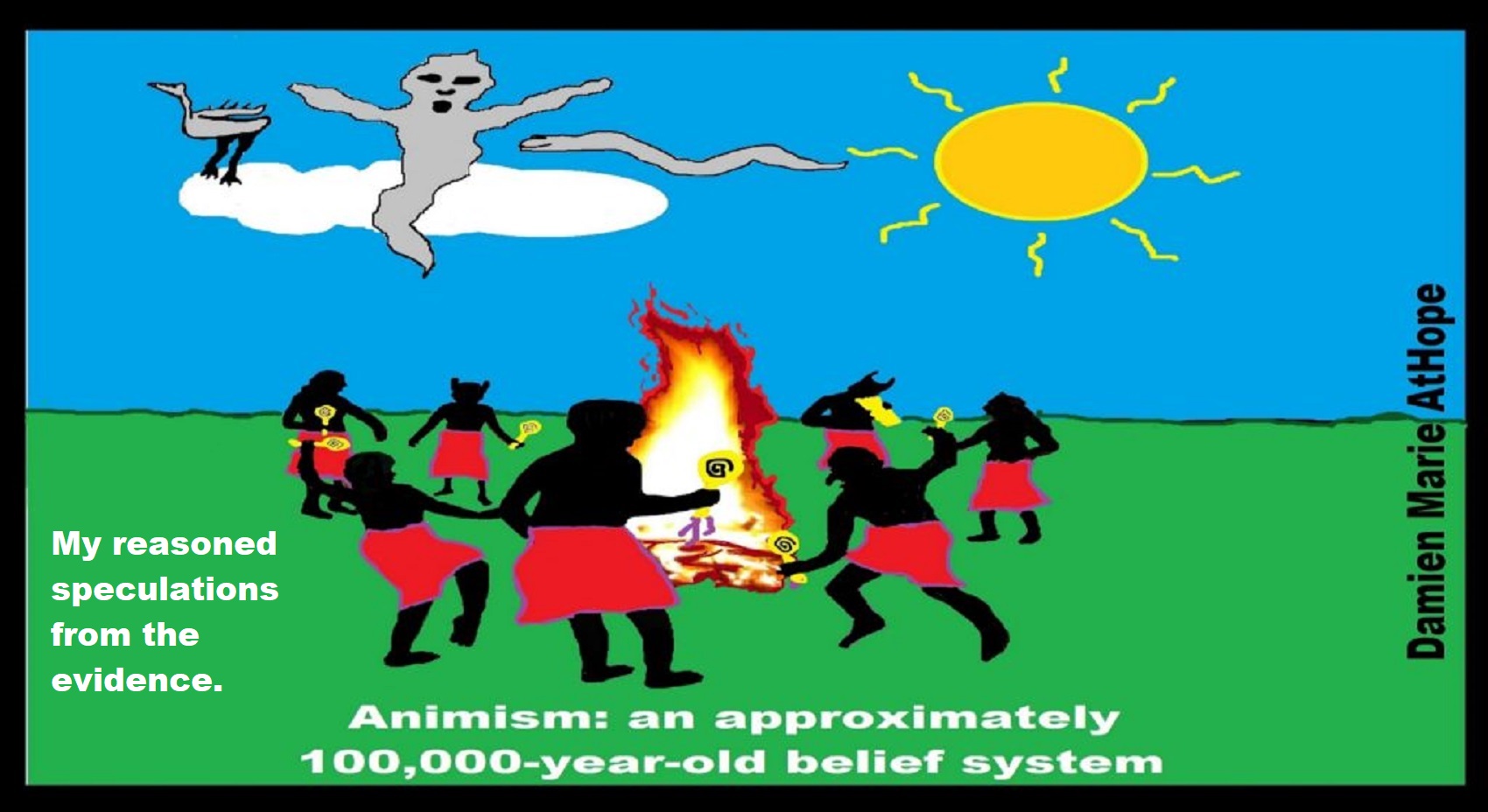
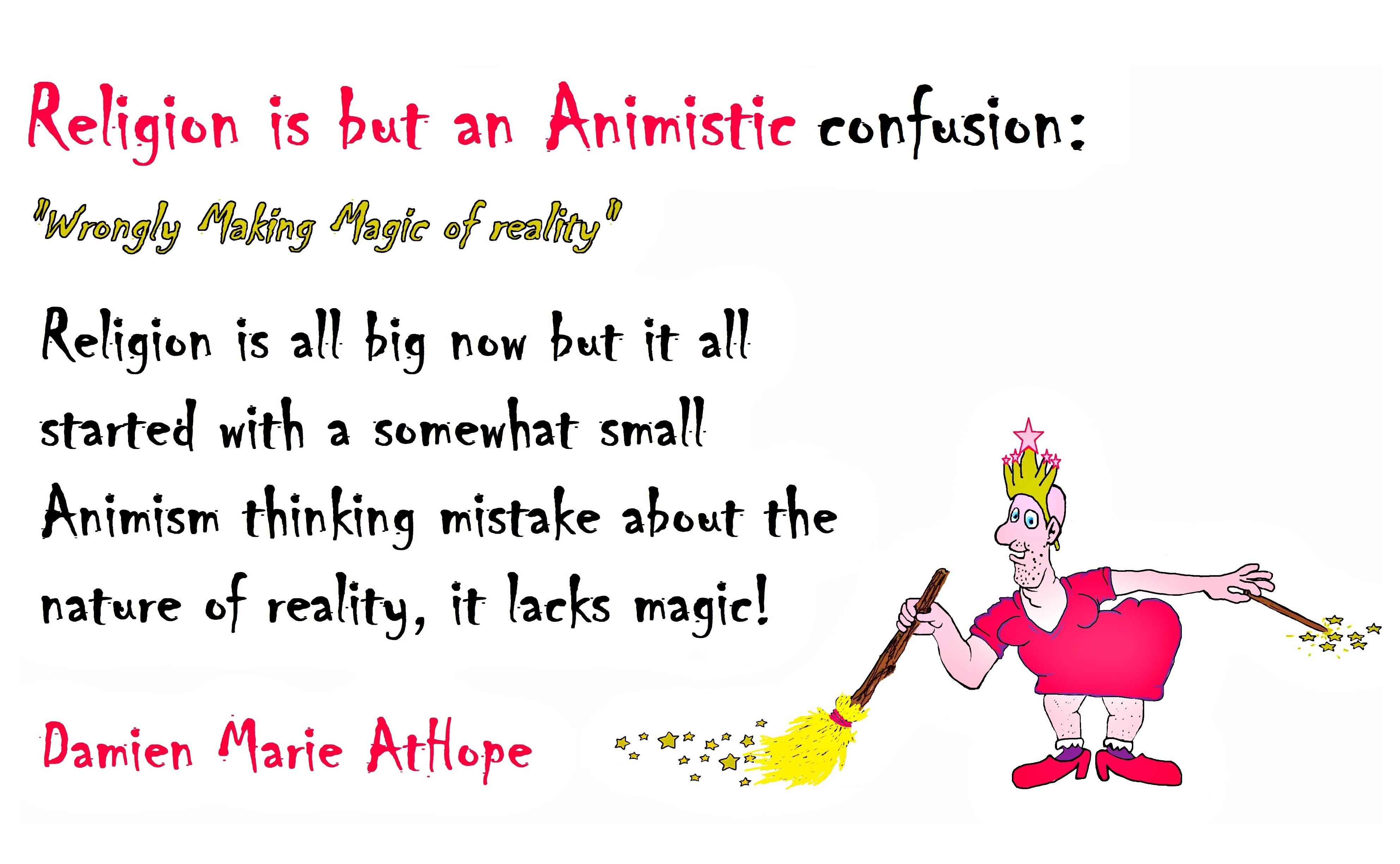
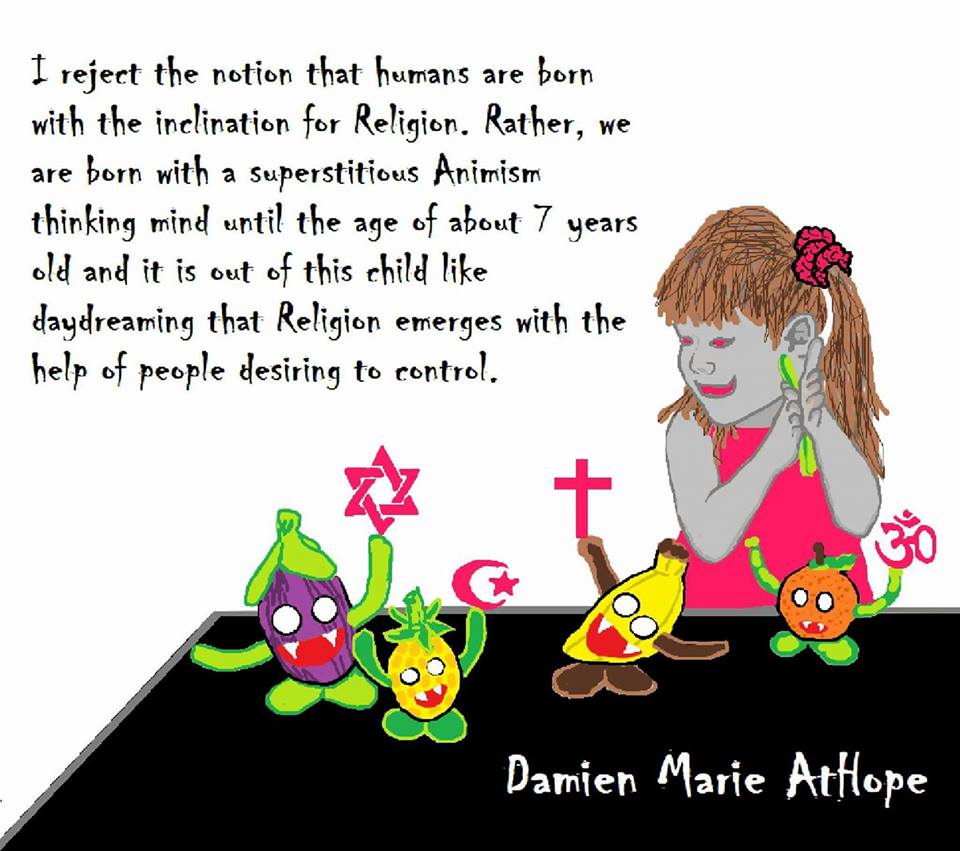
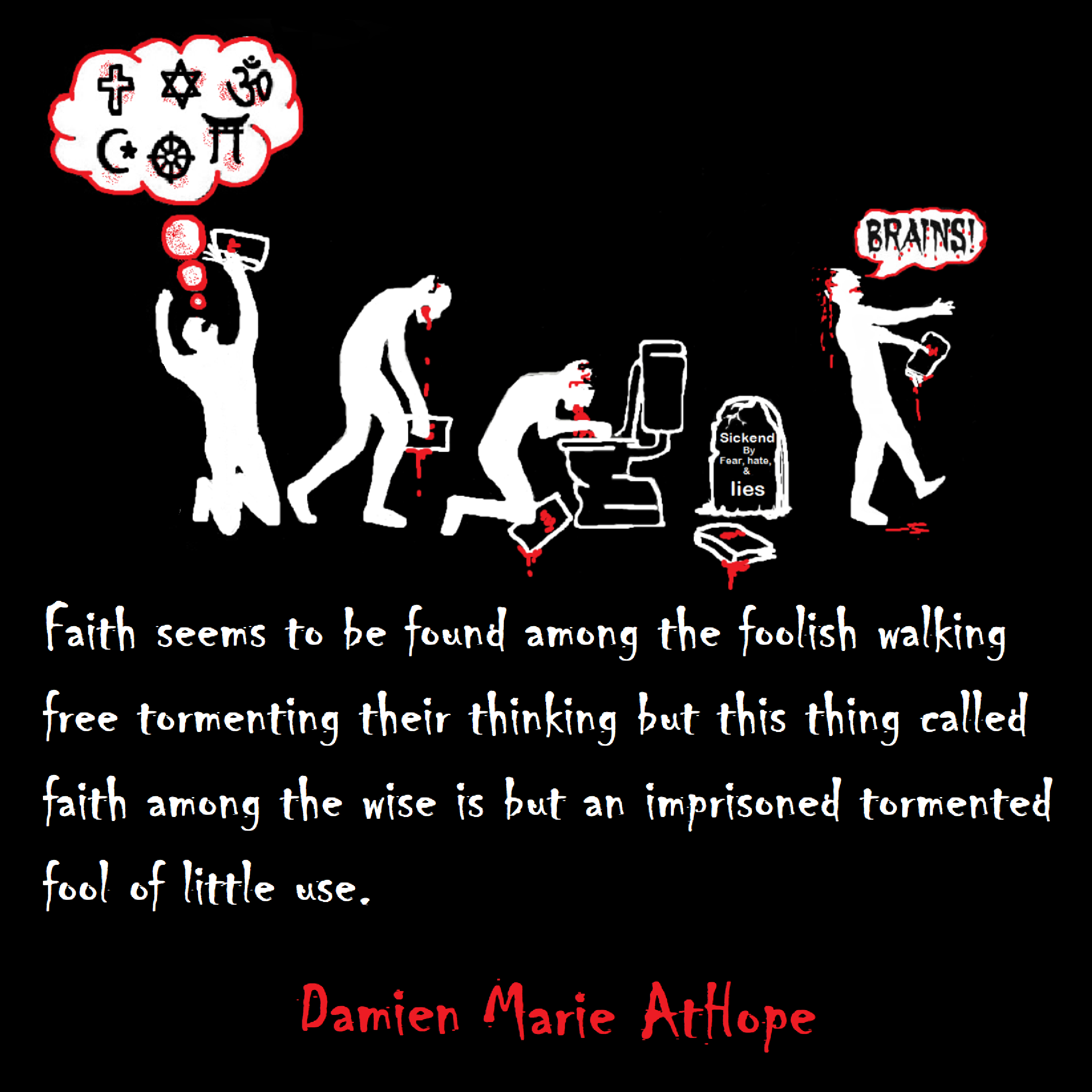
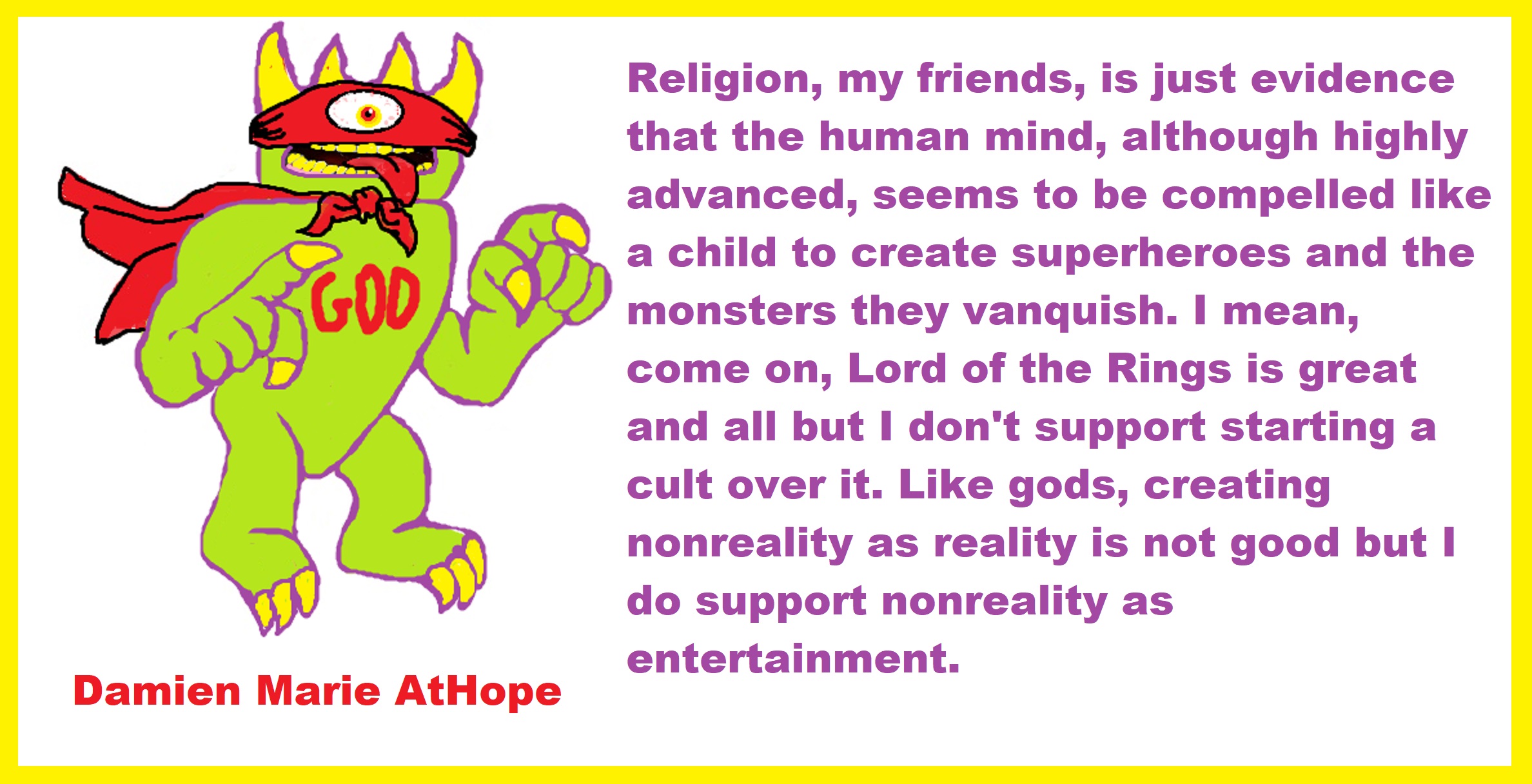

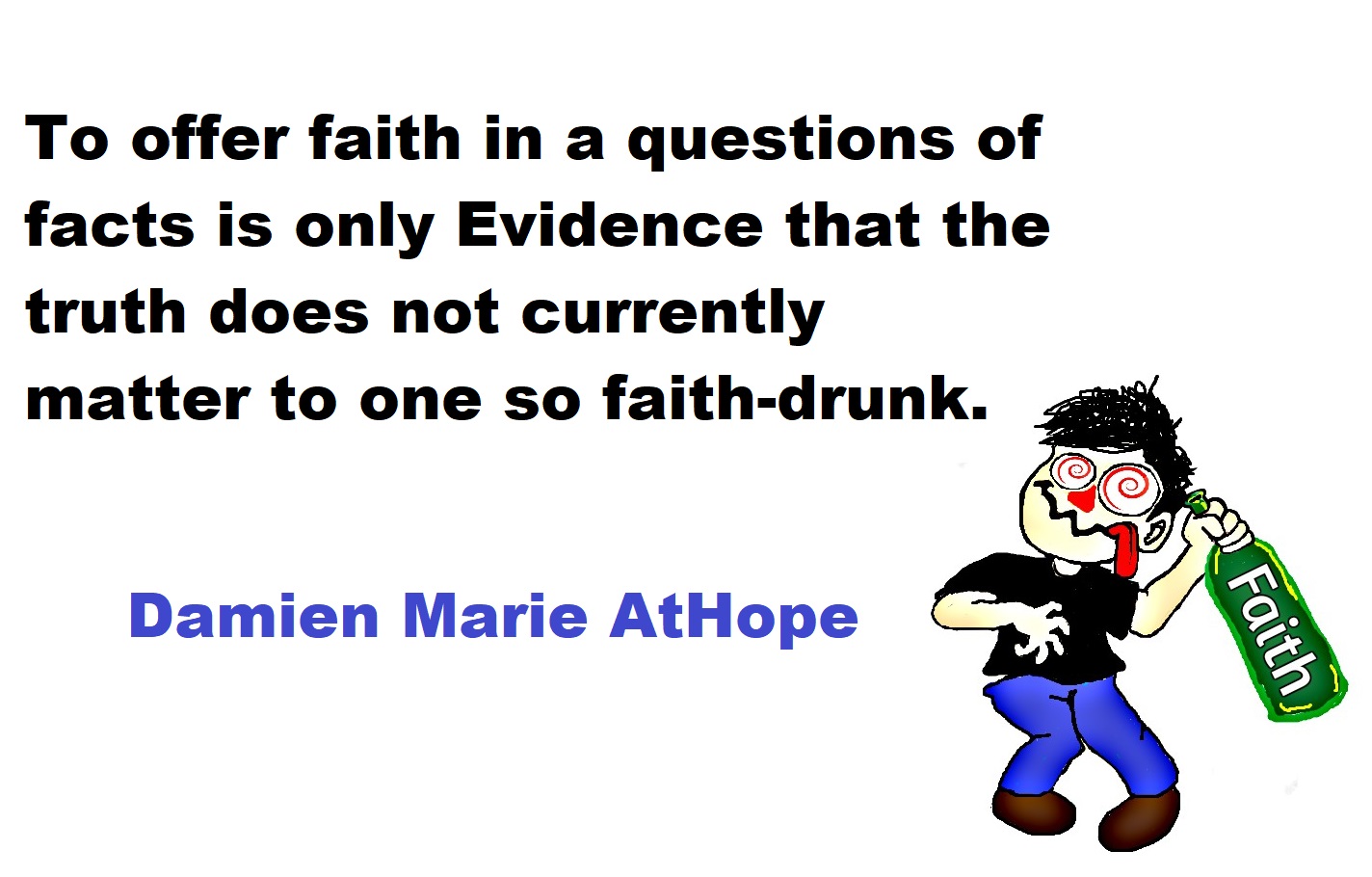
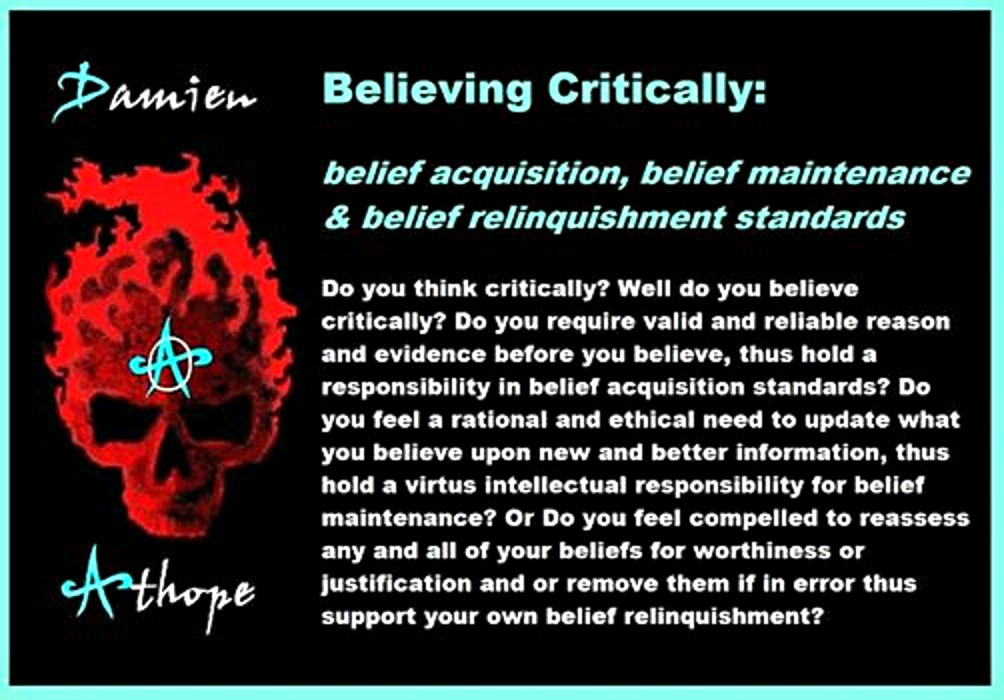

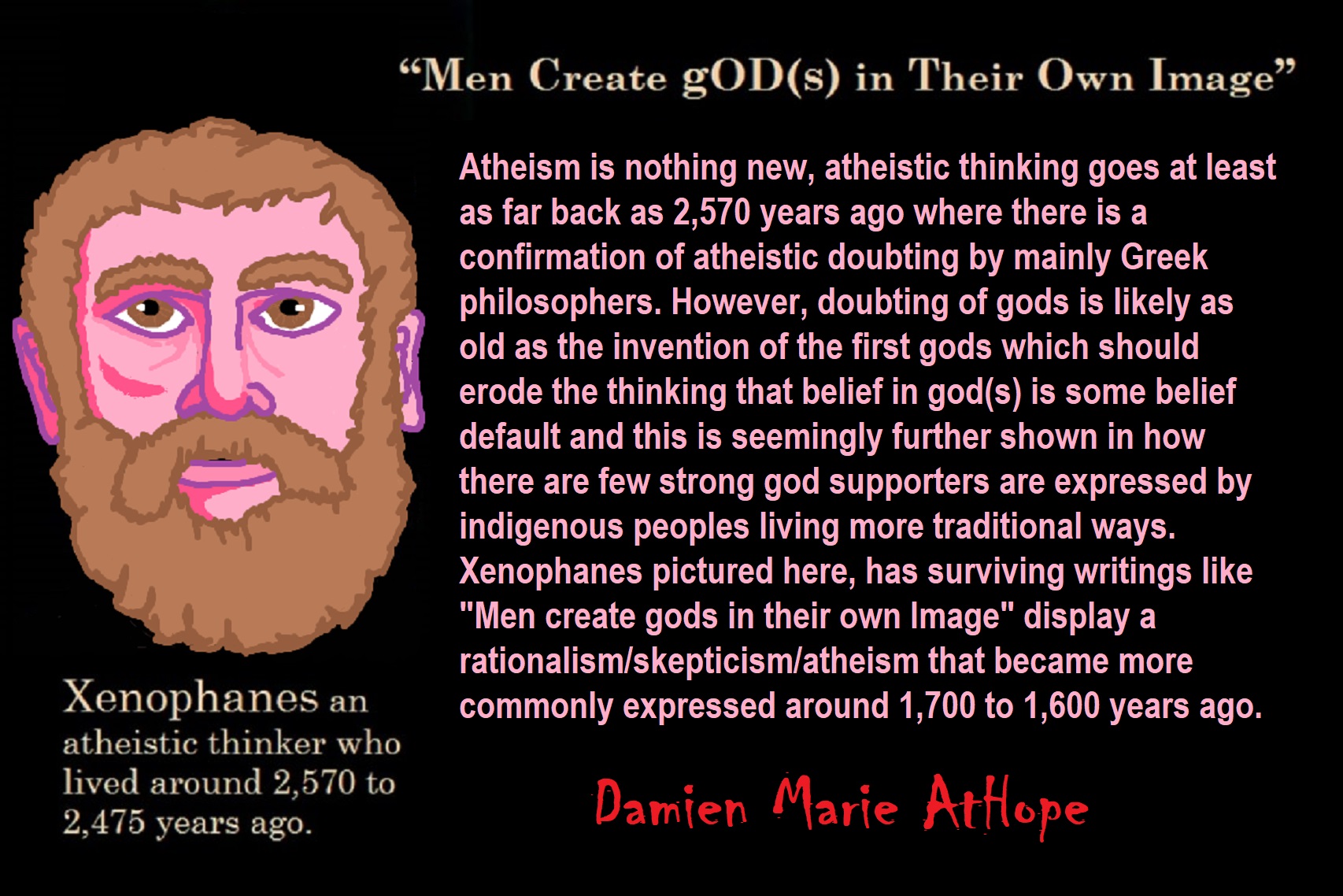
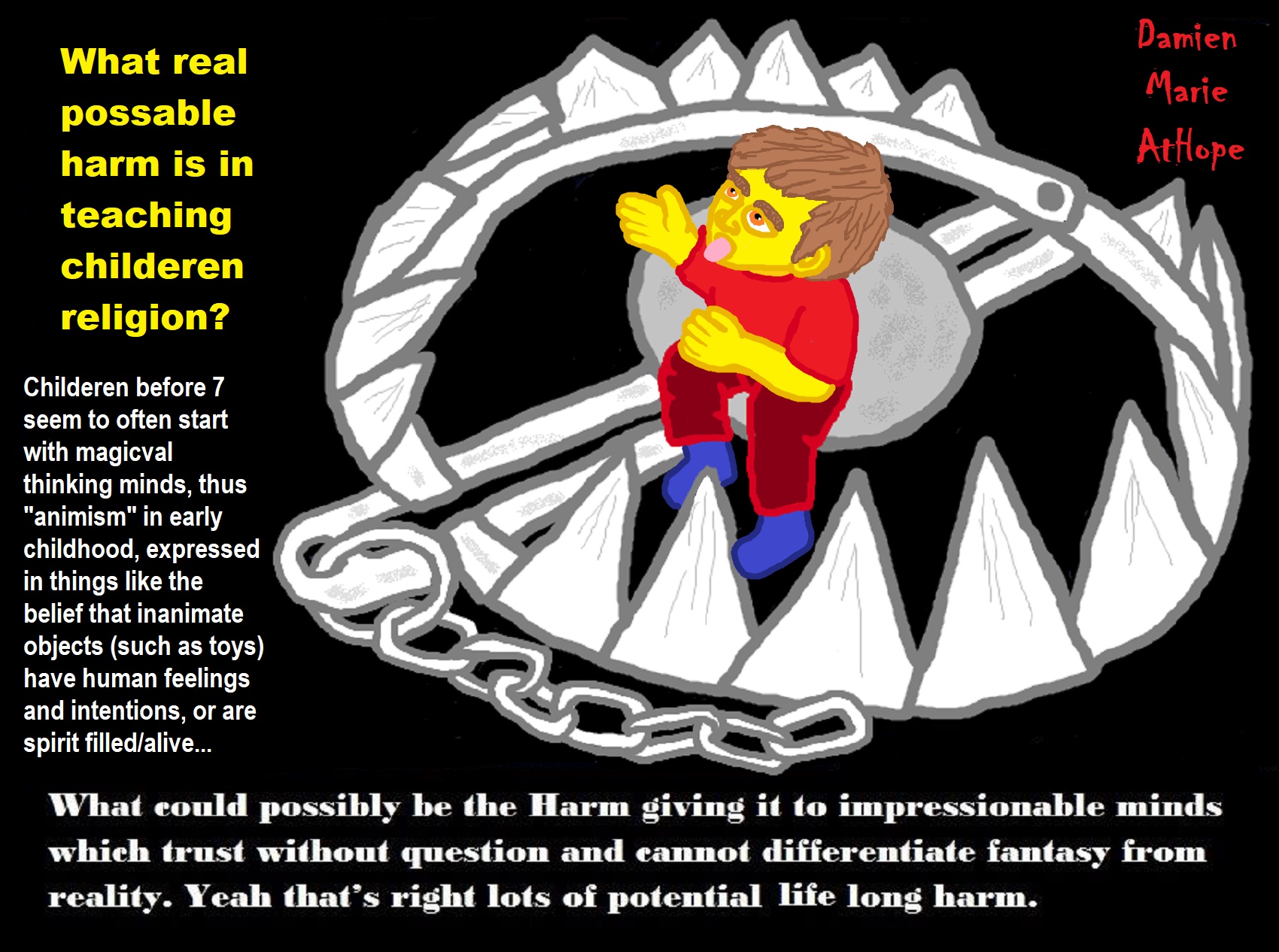
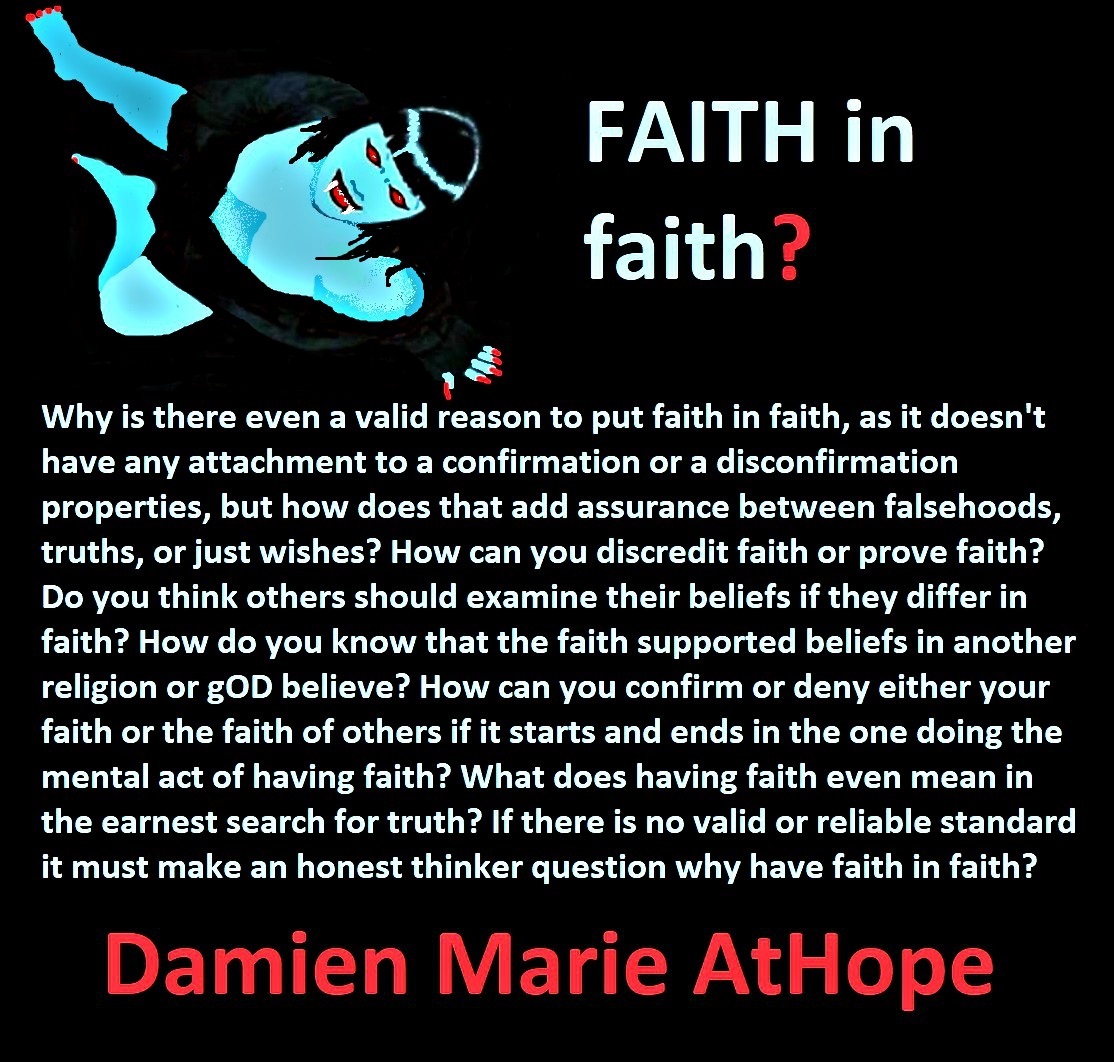



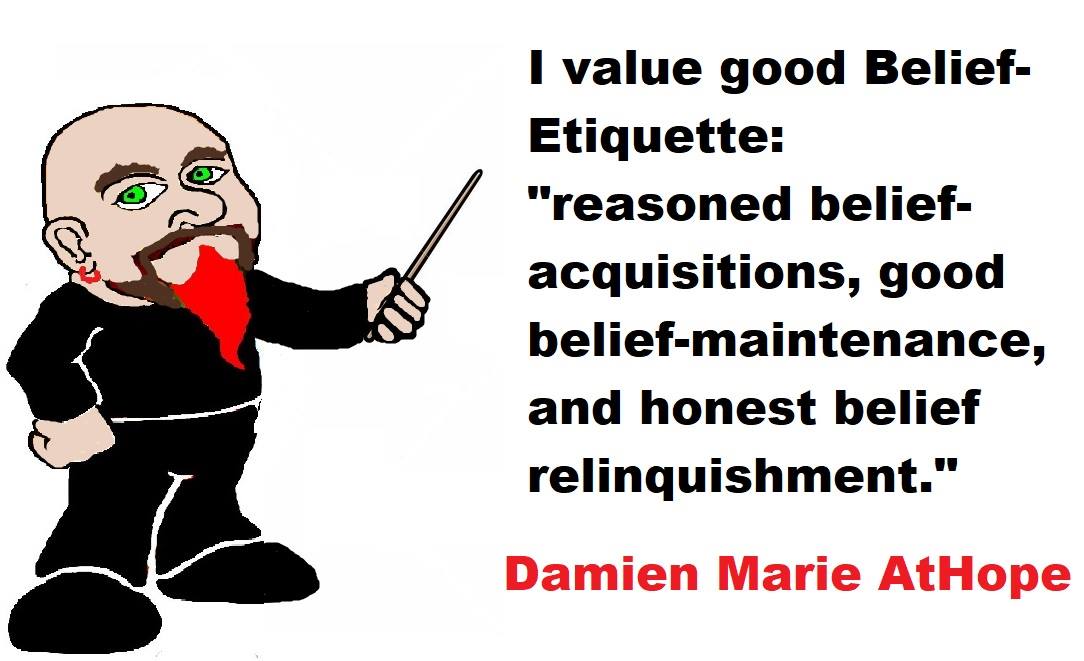




“Religion is an Evolved Product” and Yes, Religion is Like Fear Given Wings…
It seems ancient peoples had to survived amazing threats in a “dangerous universe (by superstition perceived as good and evil),” and human “immorality or imperfection of the soul” which was thought to affect the still living, leading to ancestor worship. This ancestor worship presumably led to the belief in supernatural beings, and then some of these were turned into the belief in gods. This feeble myth called gods were just a human conceived “made from nothing into something over and over, changing, again and again, taking on more as they evolve, all the while they are thought to be special,” but it is just supernatural animistic spirit-belief perceived as sacred.
Quick Evolution of Religion?
So, it all starts in a general way with Animism (theoretical belief in supernatural powers/spirits), then this is physically expressed in or with Totemism (theoretical belief in mythical relationship with powers/spirits through a totem item), which then enlists a full-time specific person to do this worship and believed interacting Shamanism (theoretical belief in access and influence with spirits through ritual), and then there is the further employment of myths and gods added to all the above giving you Paganism (often a lot more nature-based than most current top world religions, thus hinting to their close link to more ancient religious thinking it stems from). My hypothesis is expressed with an explanation of the building of a theatrical house (modern religions development).
Historically, in large city-state societies (such as Egypt or Iraq) starting around 5,000 years ago culminated to make religion something kind of new, a sociocultural-governmental-religious monarchy, where all or at least many of the people of such large city-state societies seem familiar with and committed to the existence of “religion” as the integrated life identity package of control dynamics with a fixed closed magical doctrine, but this juggernaut integrated religion identity package of Dogmatic-Propaganda certainly did not exist or if developed to an extent it was highly limited in most smaller prehistoric societies as they seem to lack most of the strong control dynamics with a fixed closed magical doctrine (magical beliefs could be at times be added or removed). Many people just want to see developed religious dynamics everywhere even if it is not. Instead, all that is found is largely fragments until the domestication of religion. Religions, as we think of them today, are a new fad, even if they go back to around 6,000 years in the timeline of human existence, this amounts to almost nothing when seen in the long slow evolution of religion at least around 70,000 years ago with one of the oldest ritual worship. This message of how religion and gods among them are clearly a man-made thing that was developed slowly as it was invented and then implemented peace by peace discrediting them all. Which seems to be a simple point some are just not grasping how devastating to any claims of truth when we can see the lie clearly in the archeological sites.